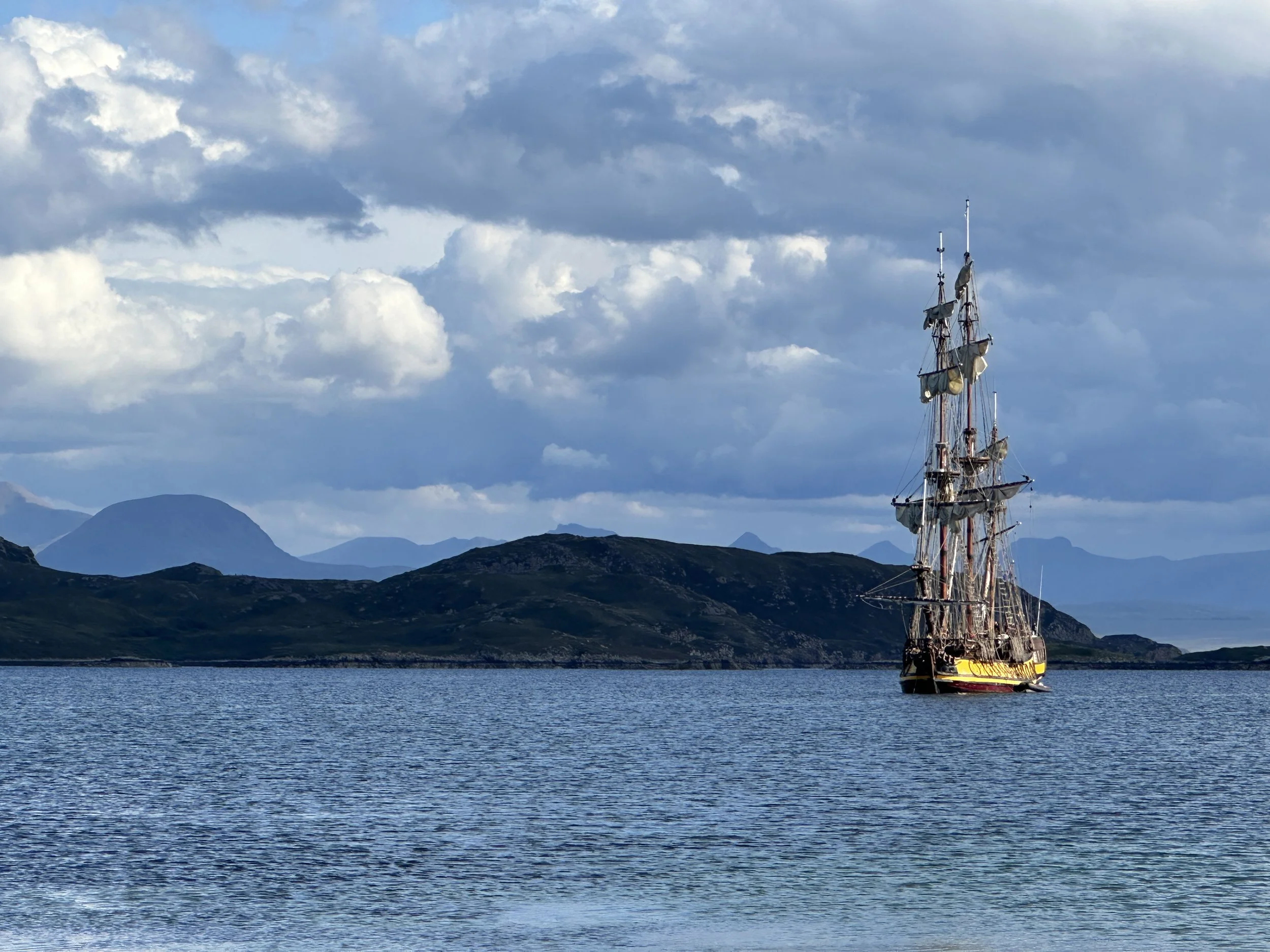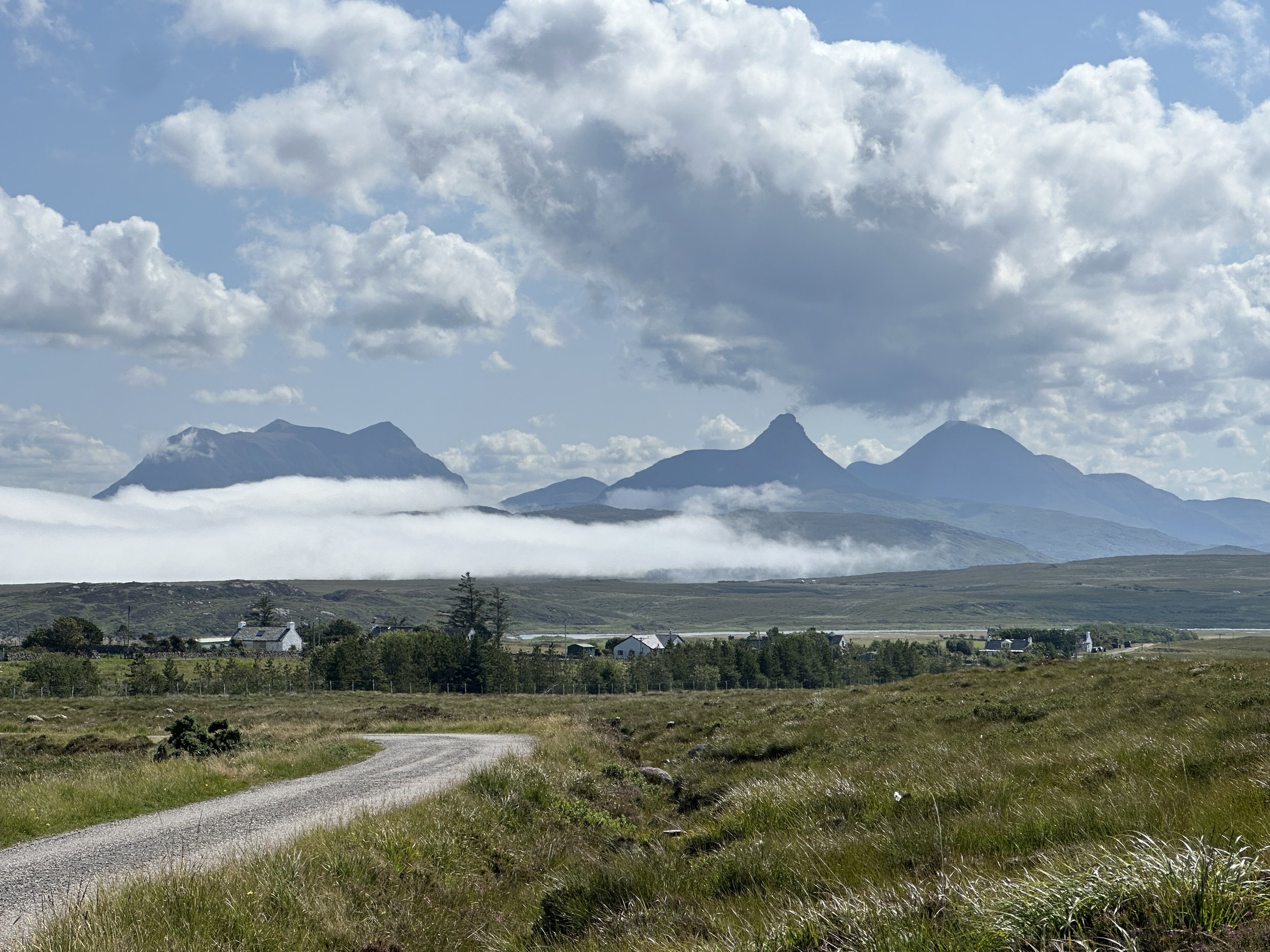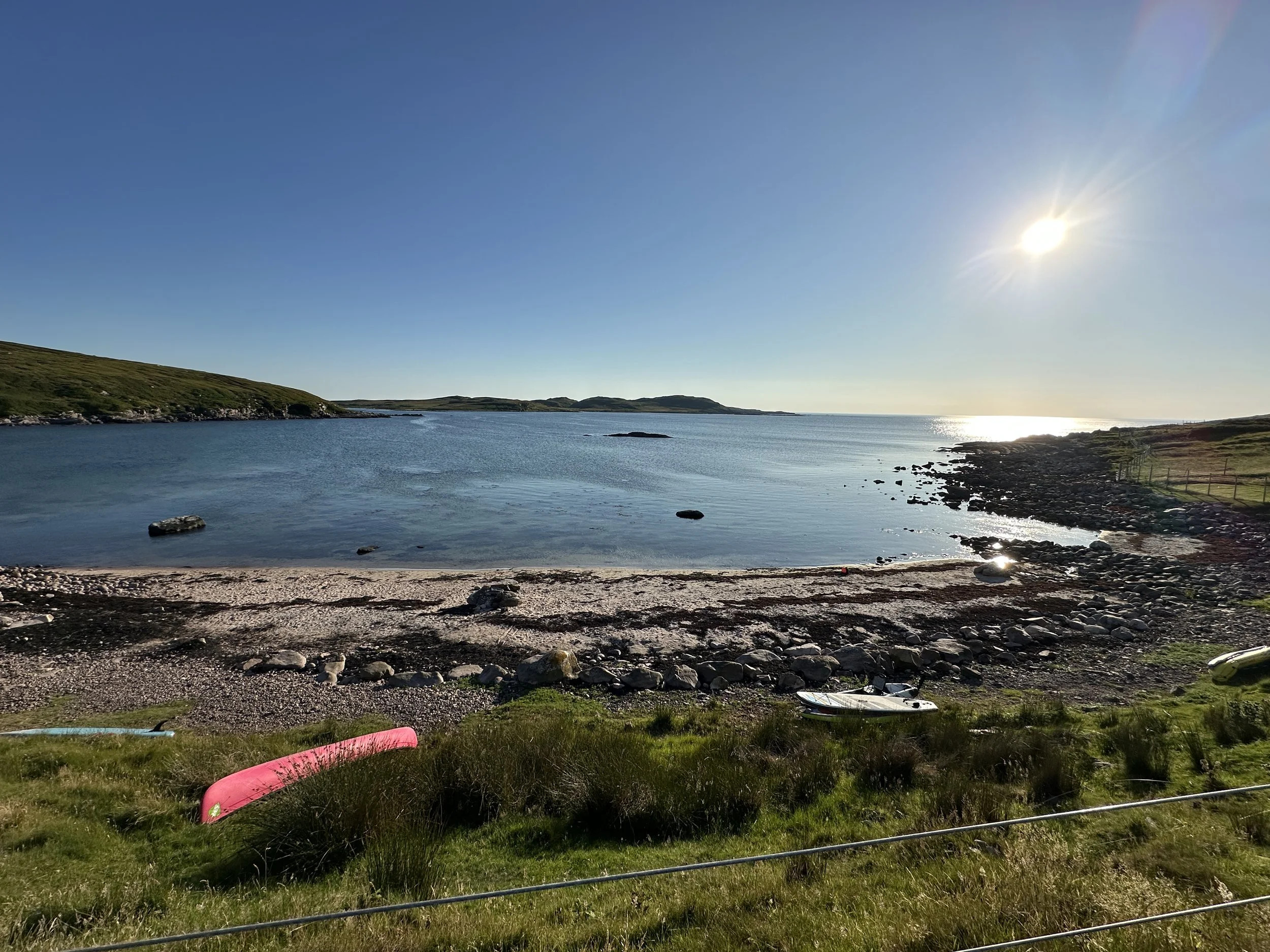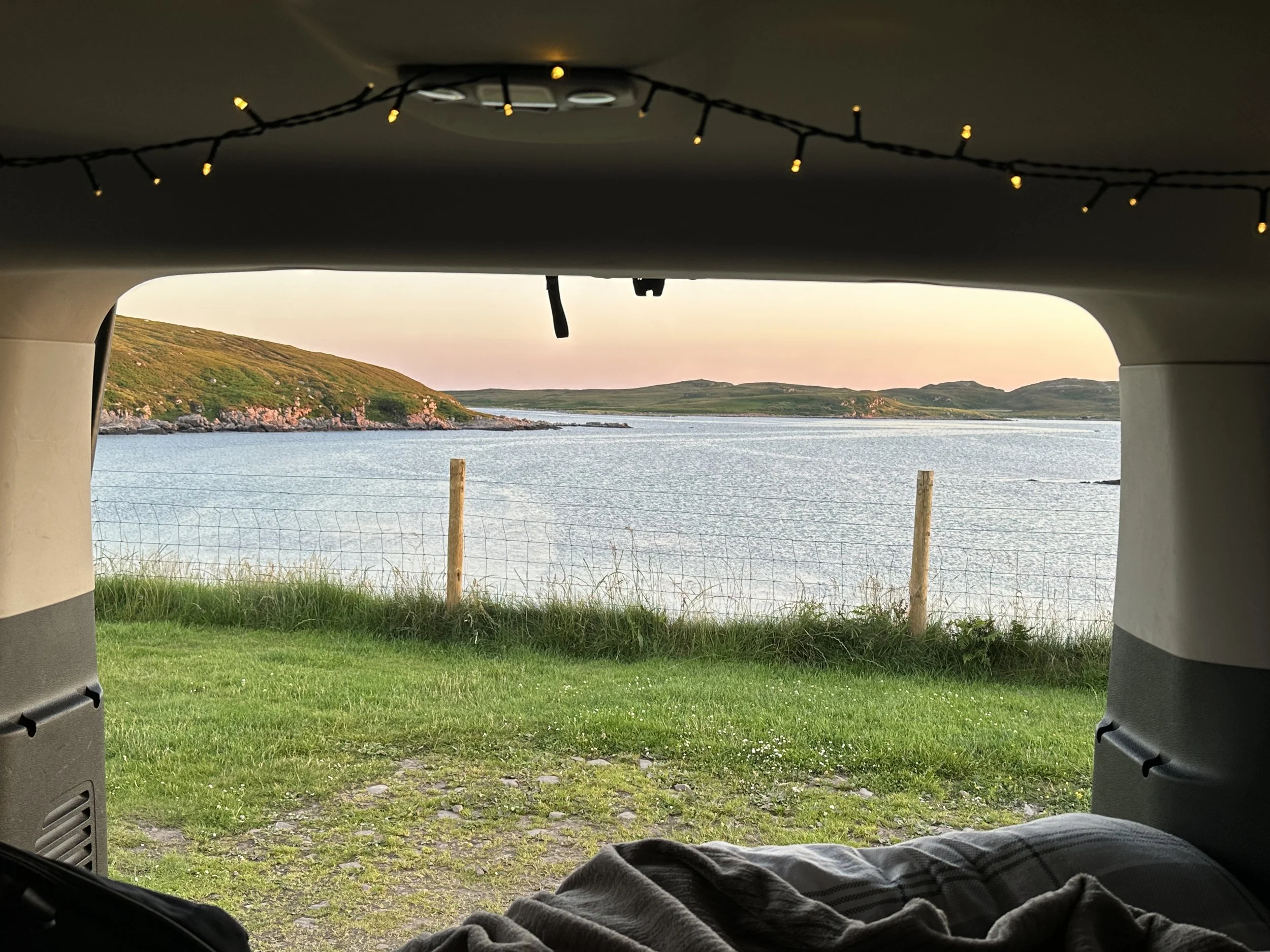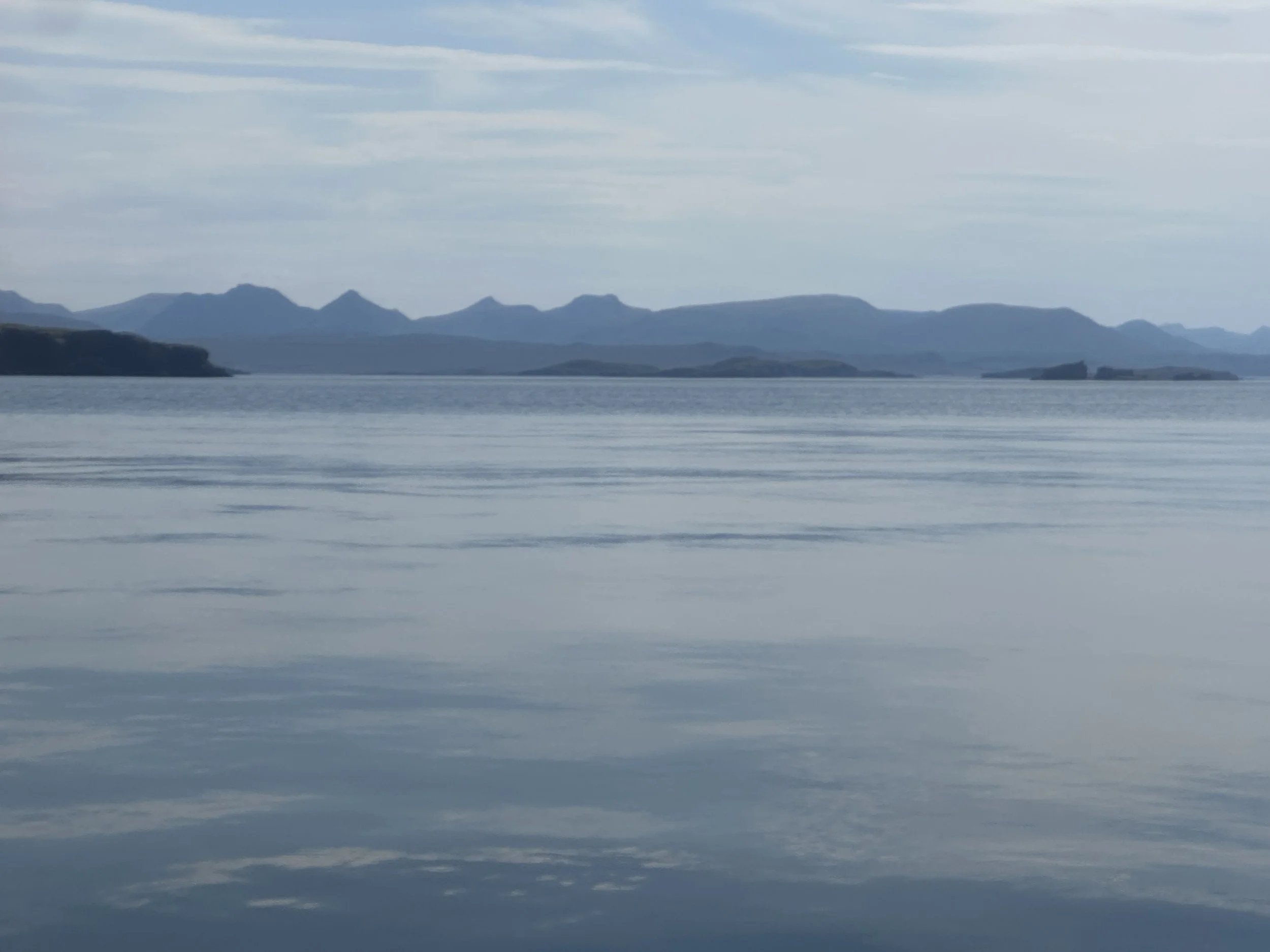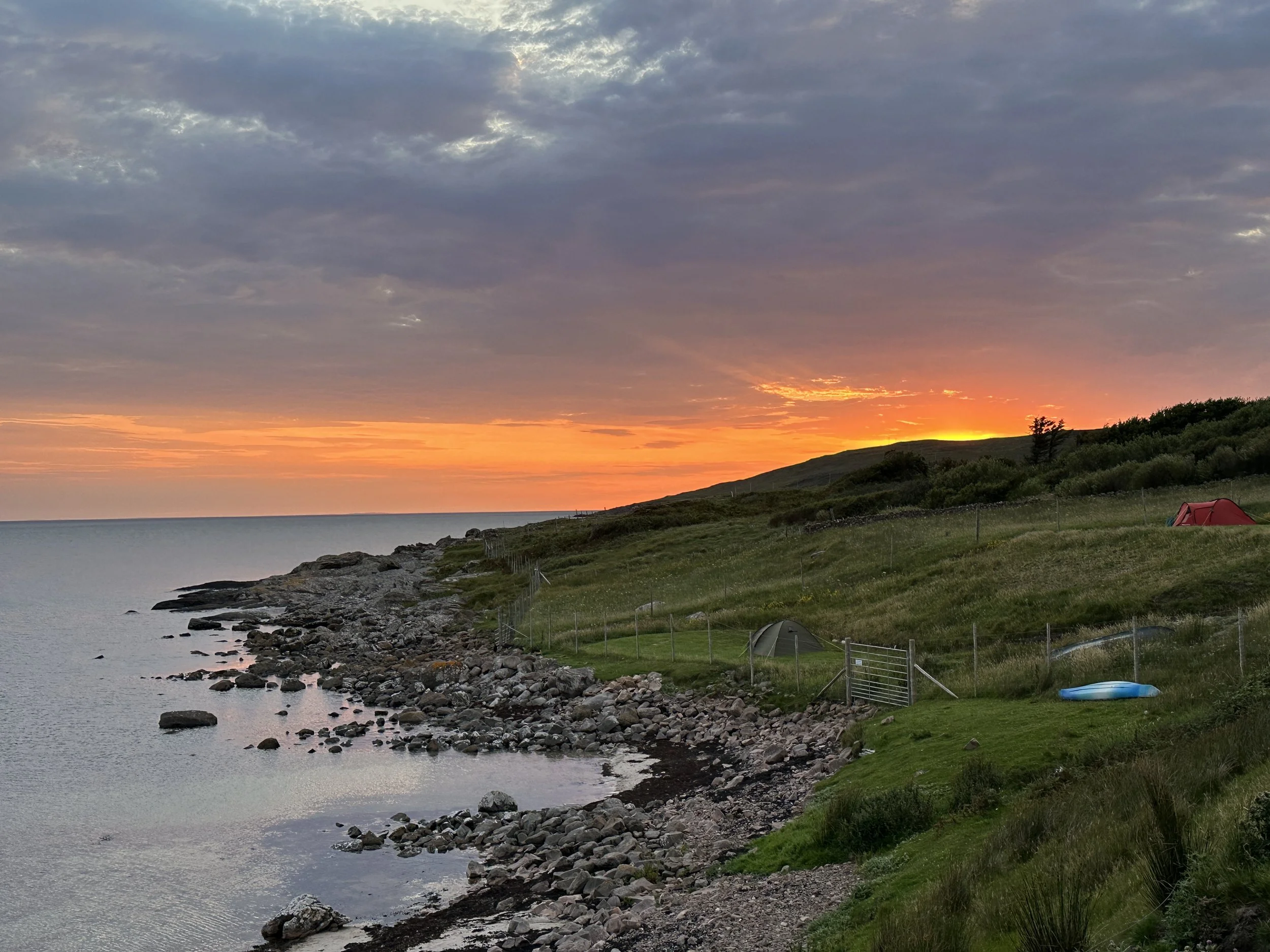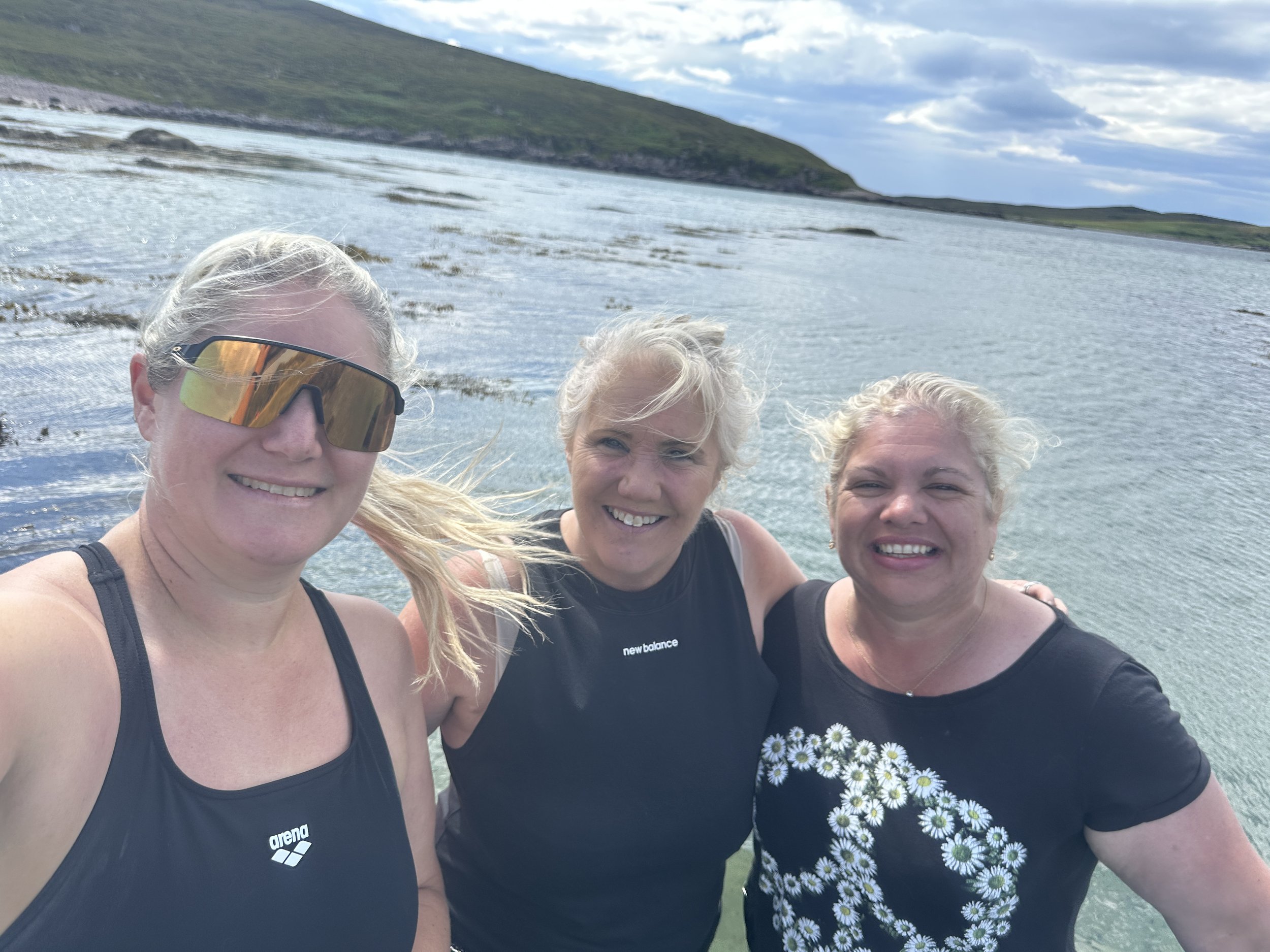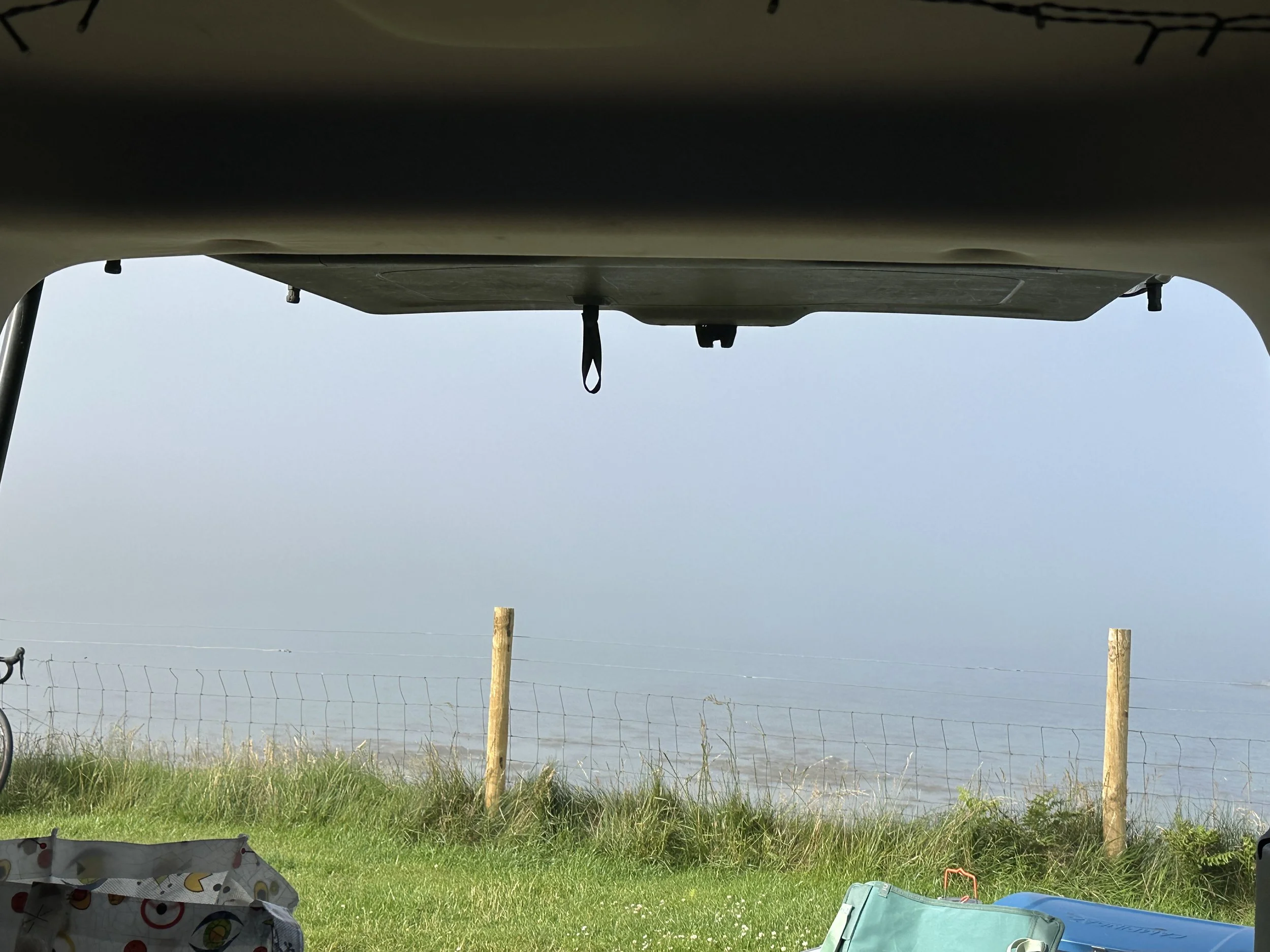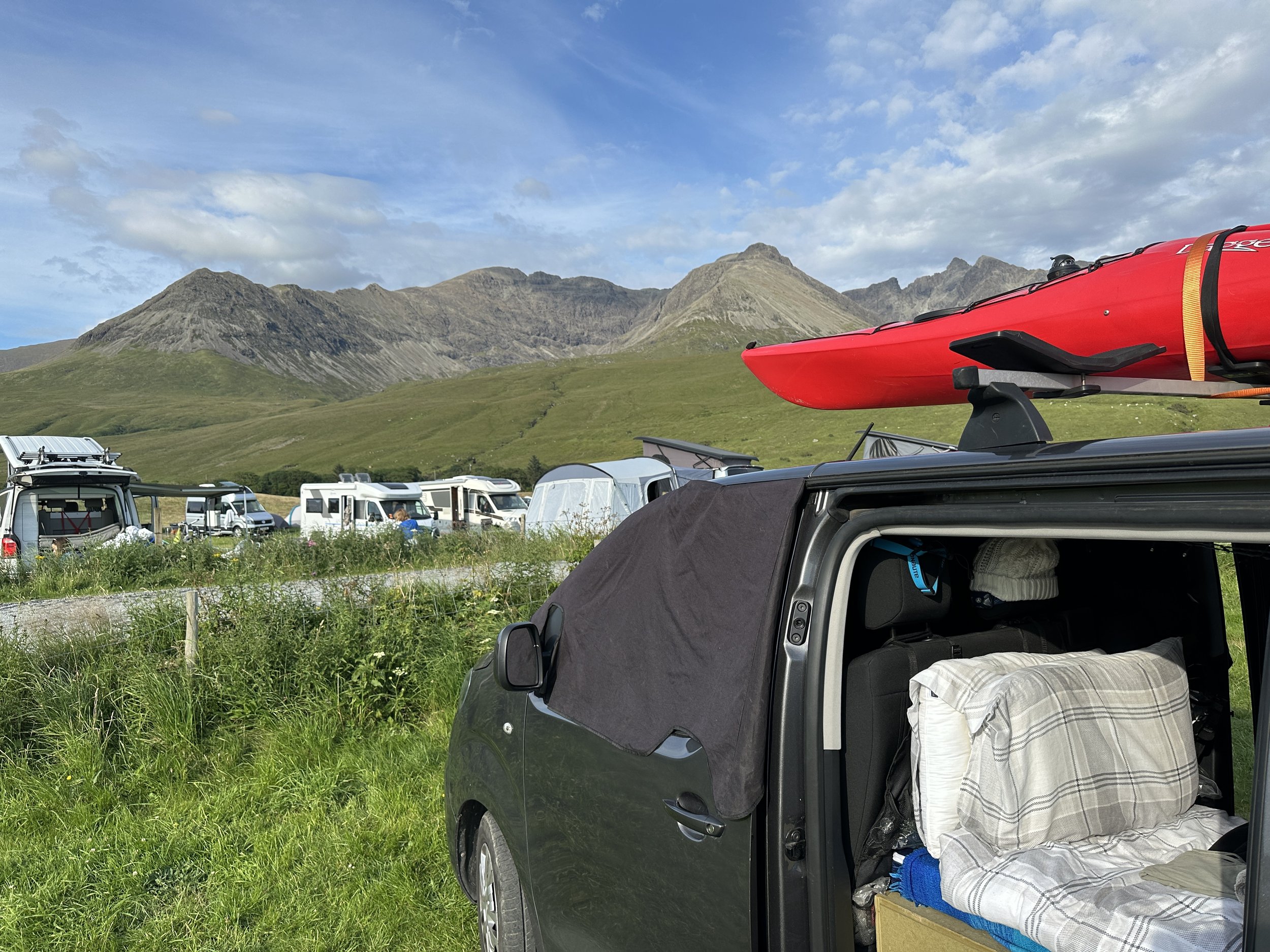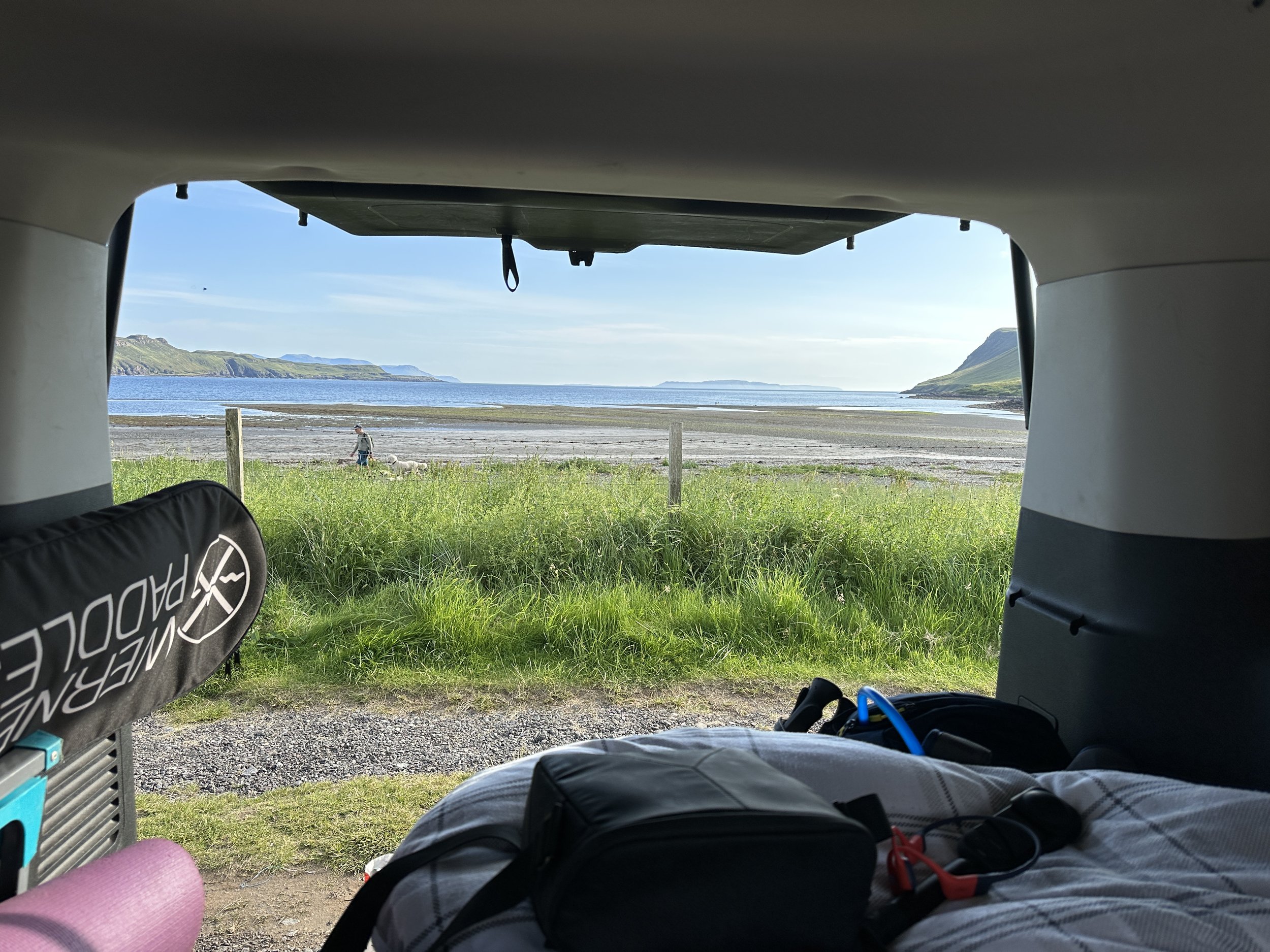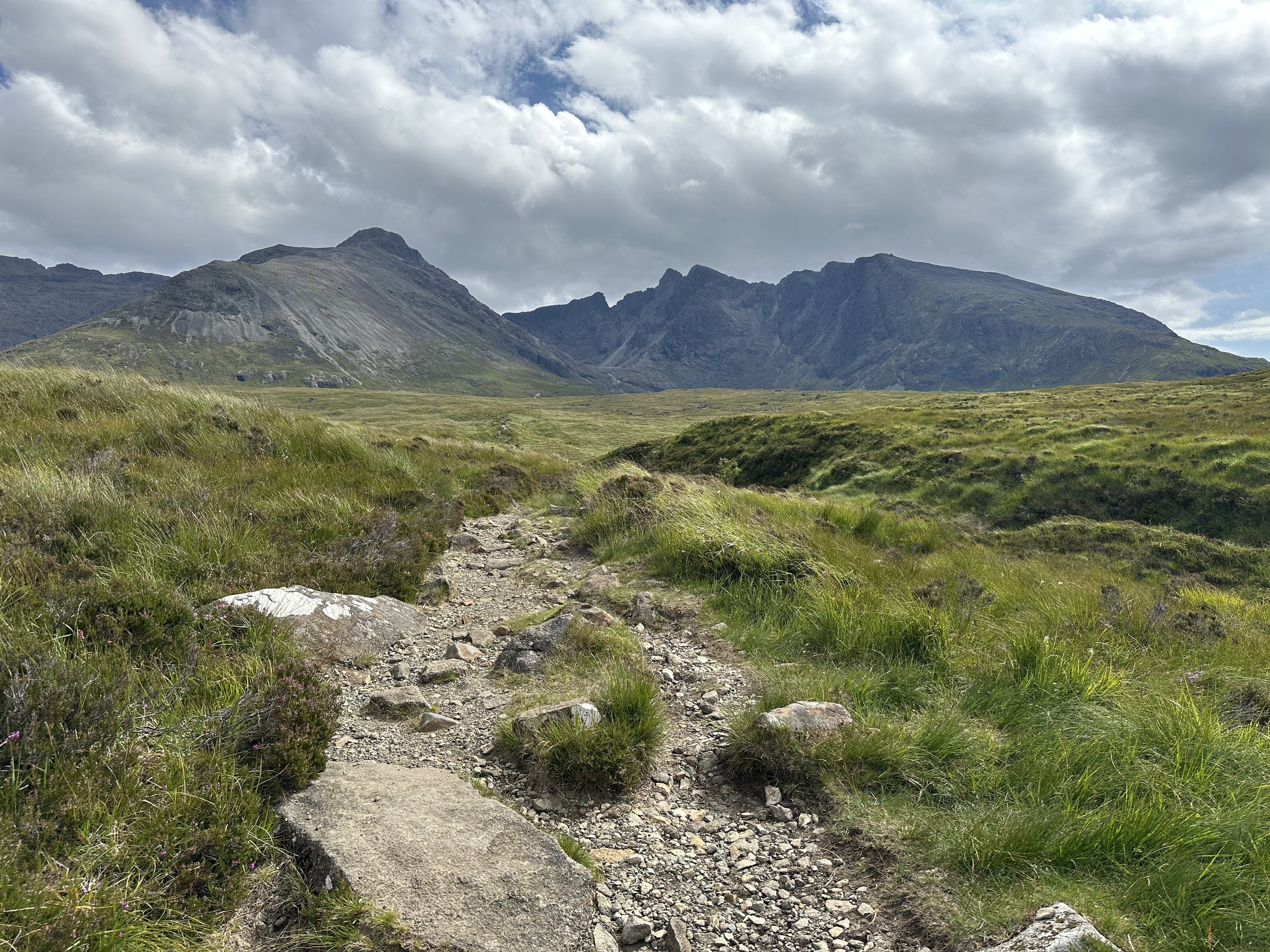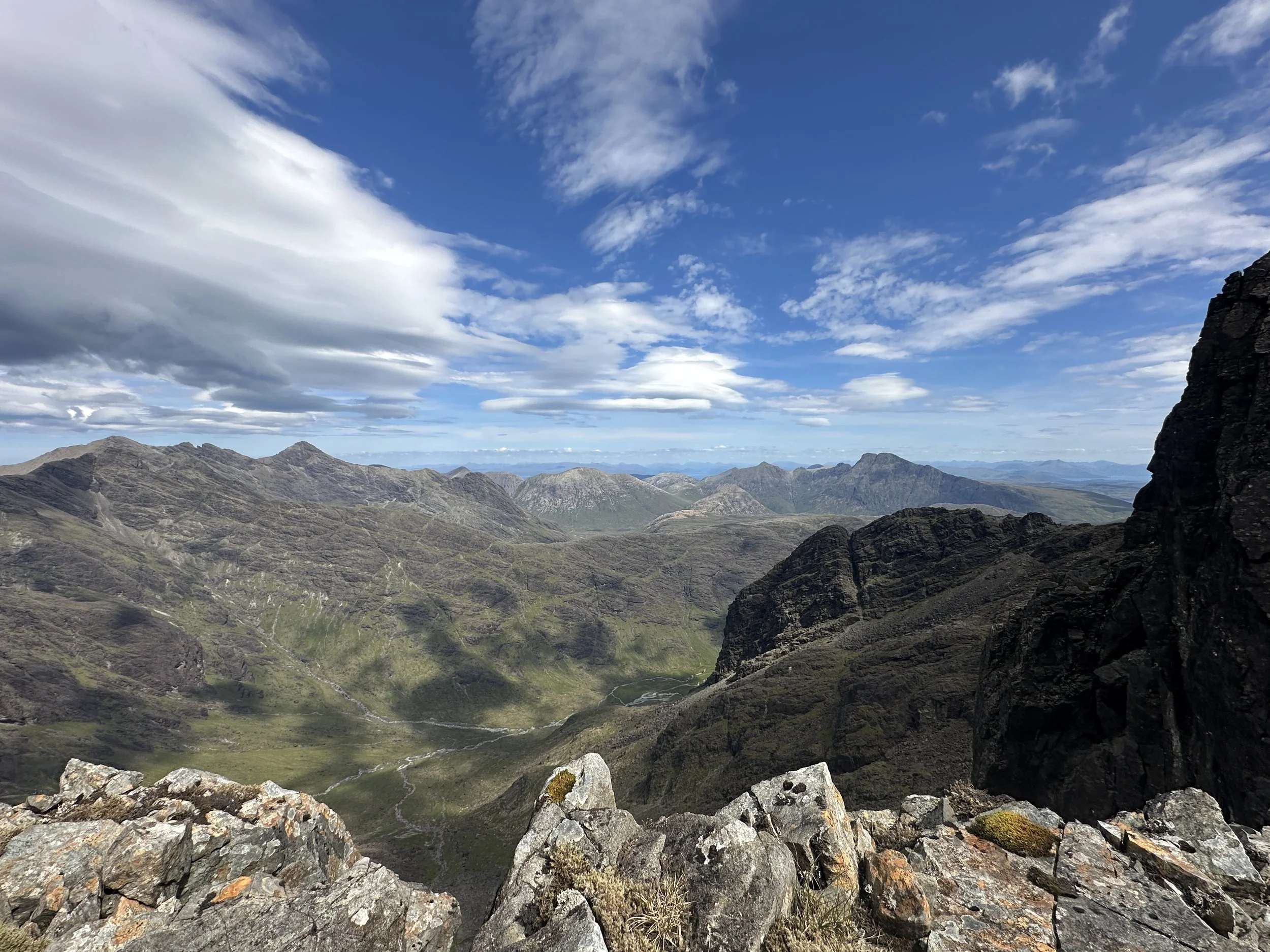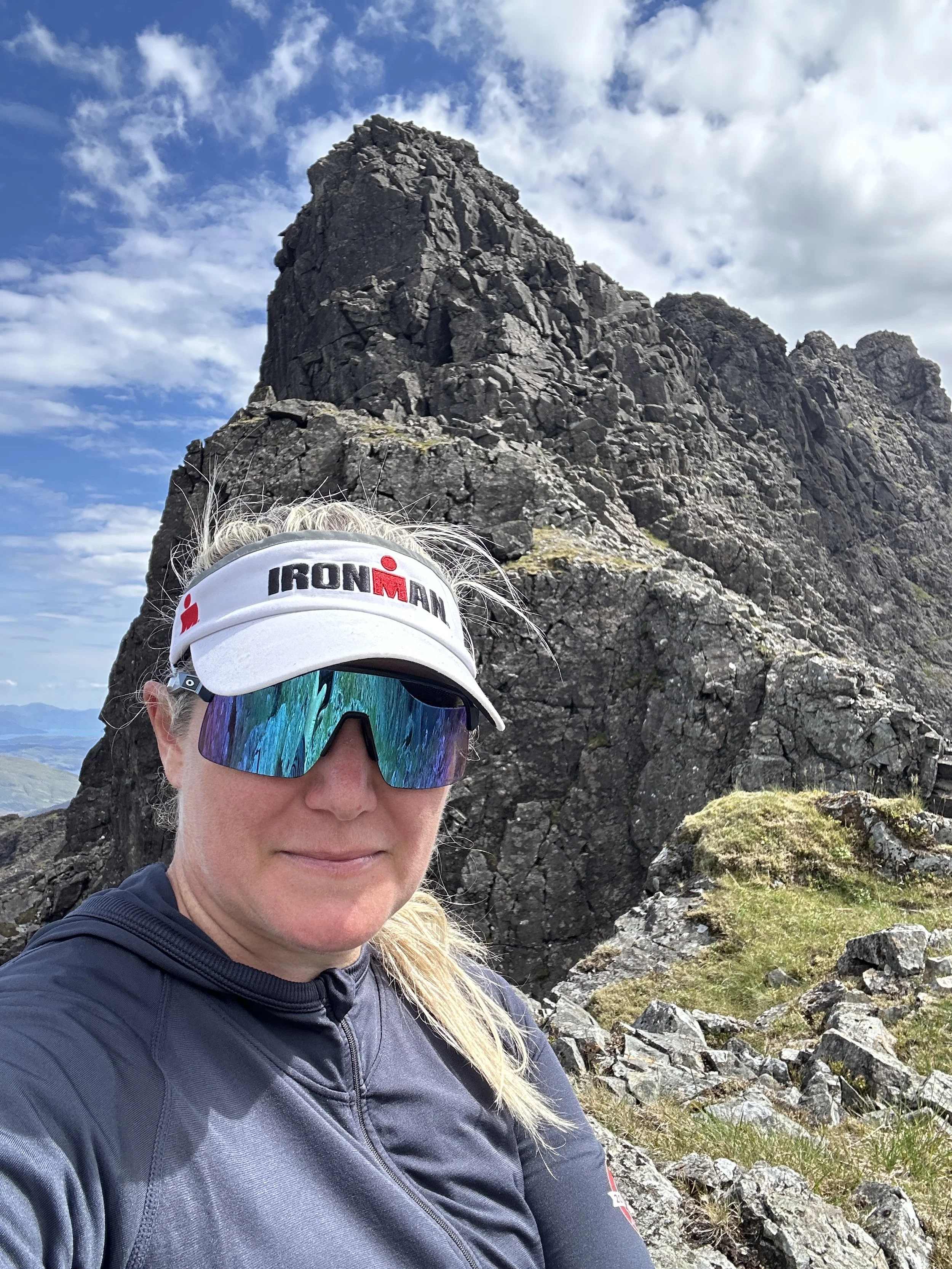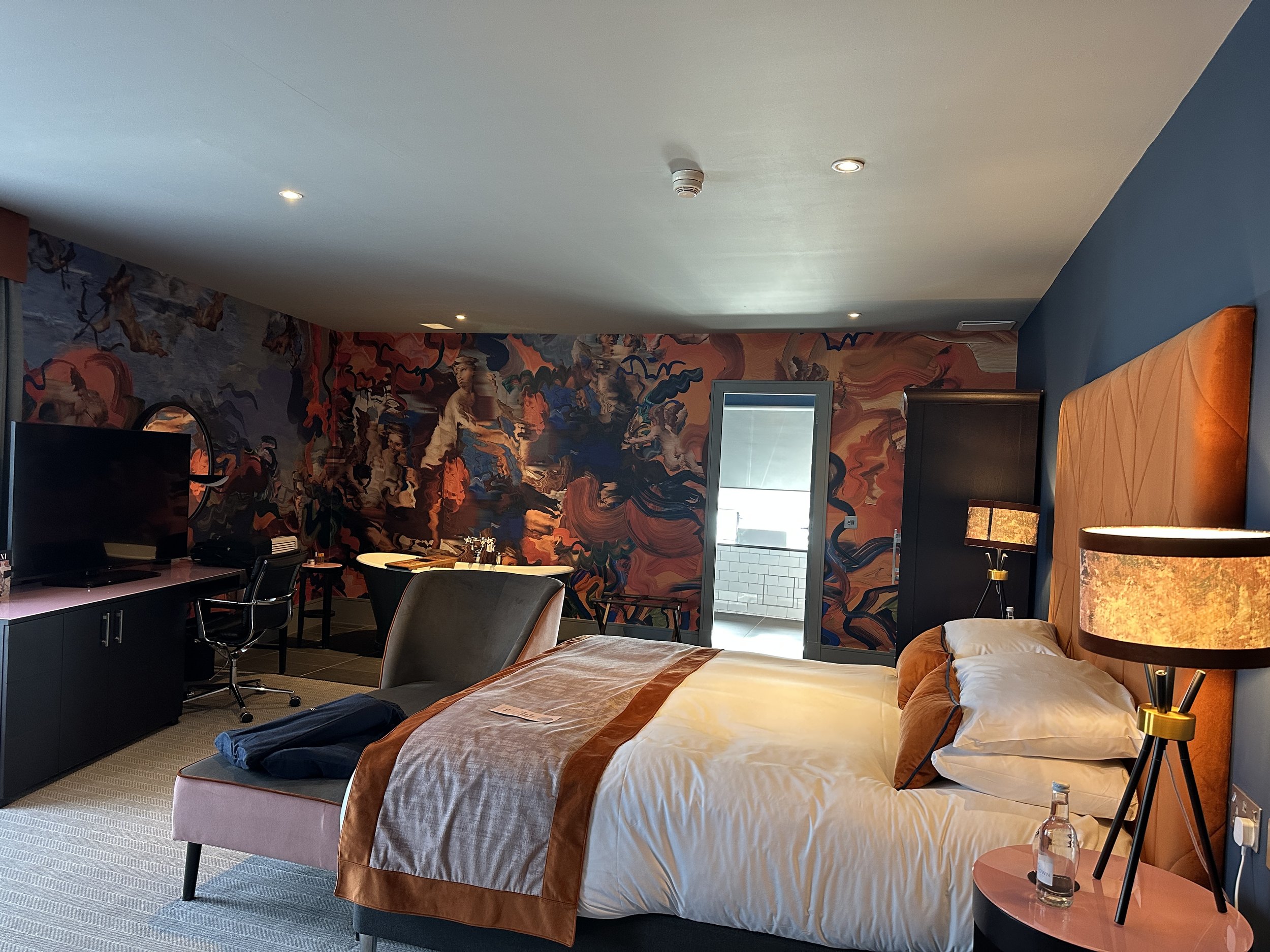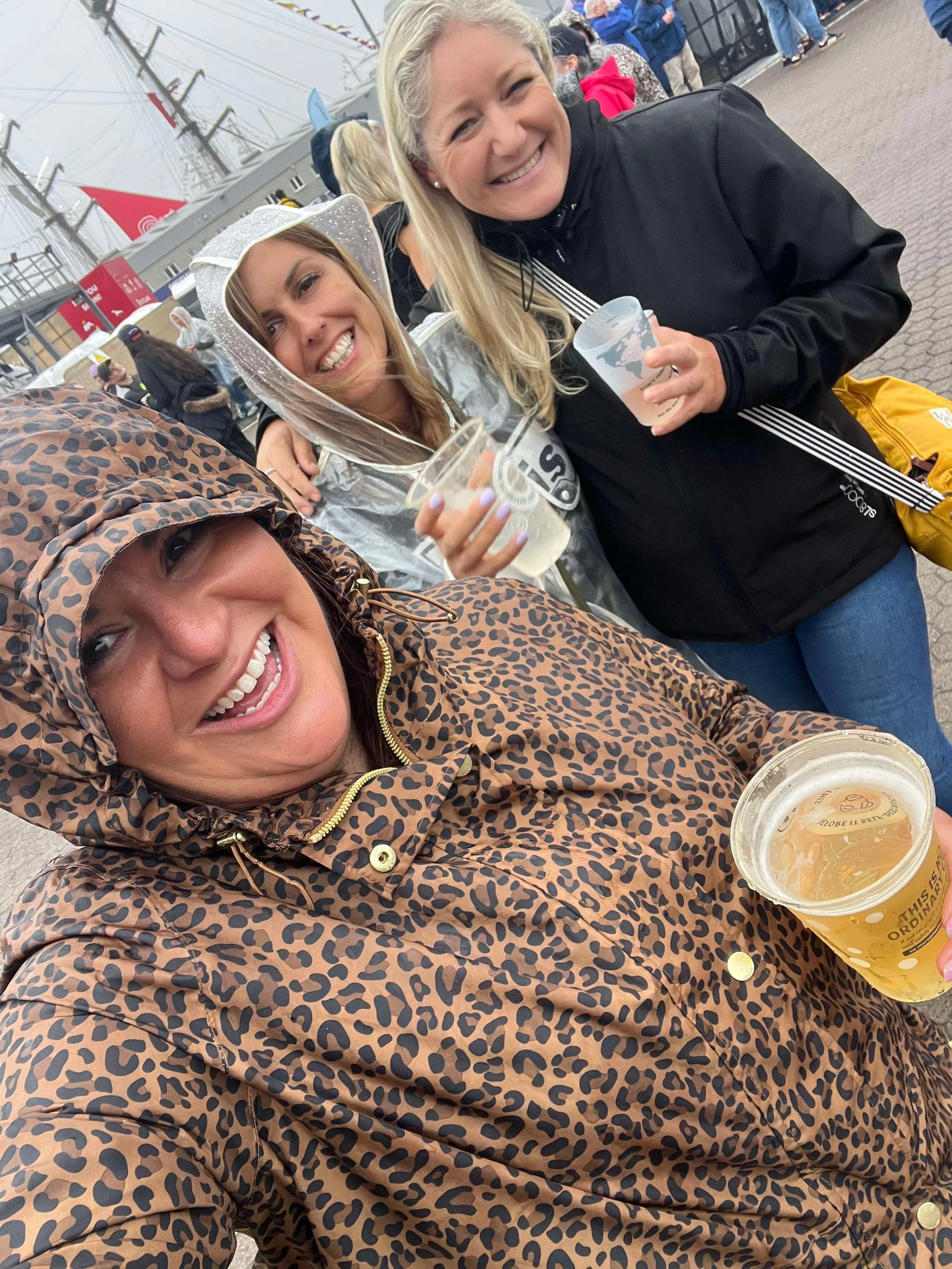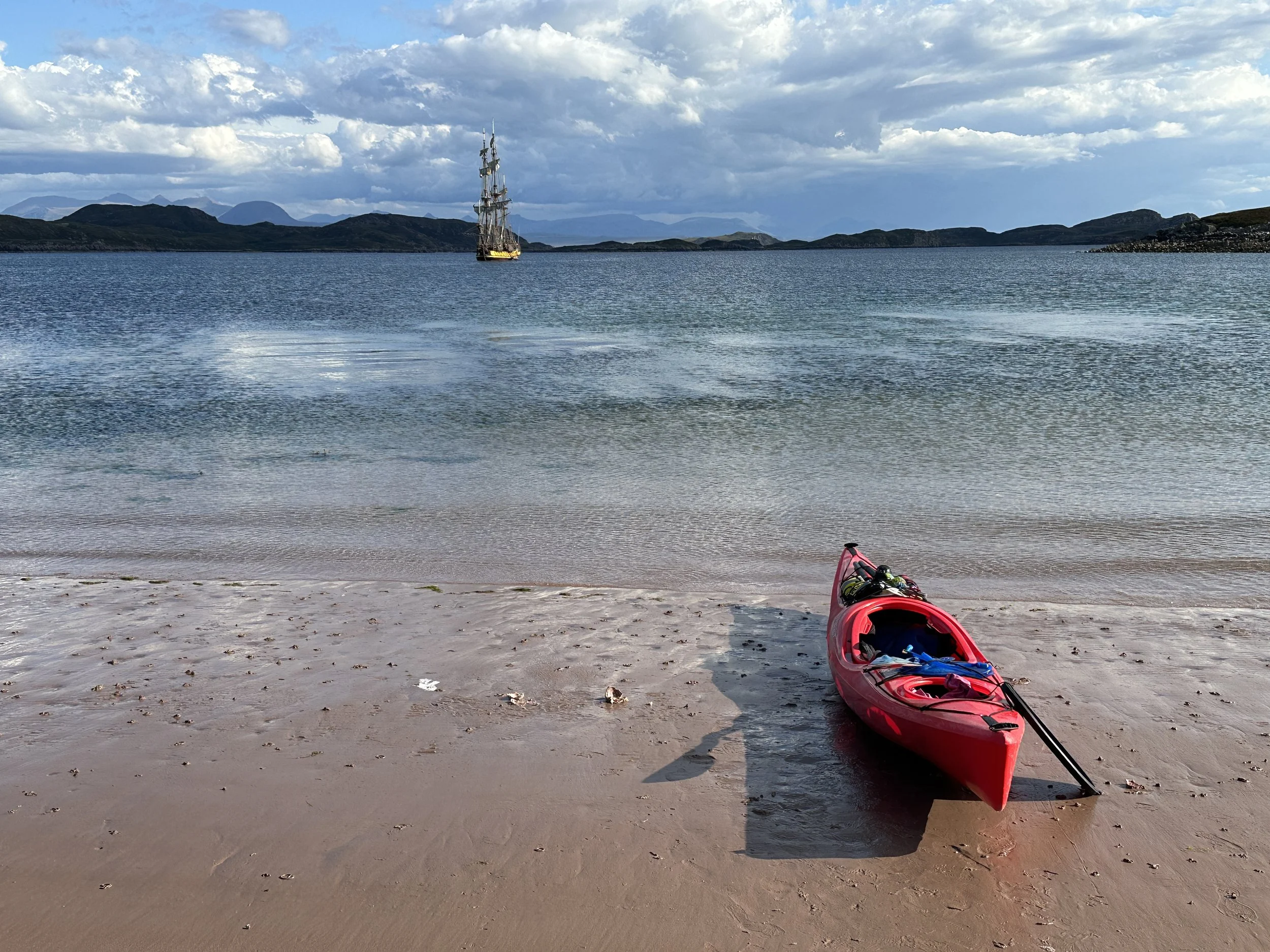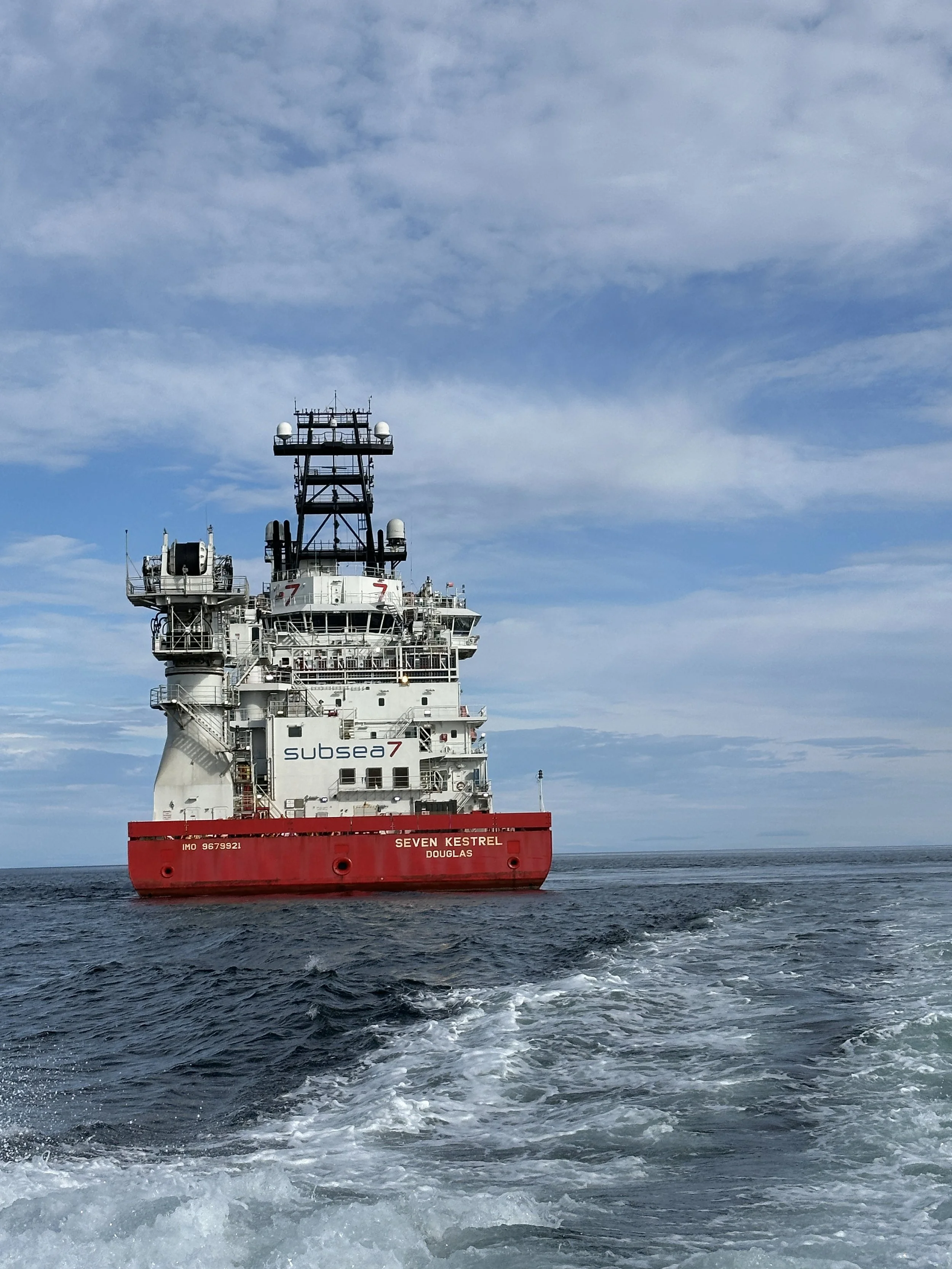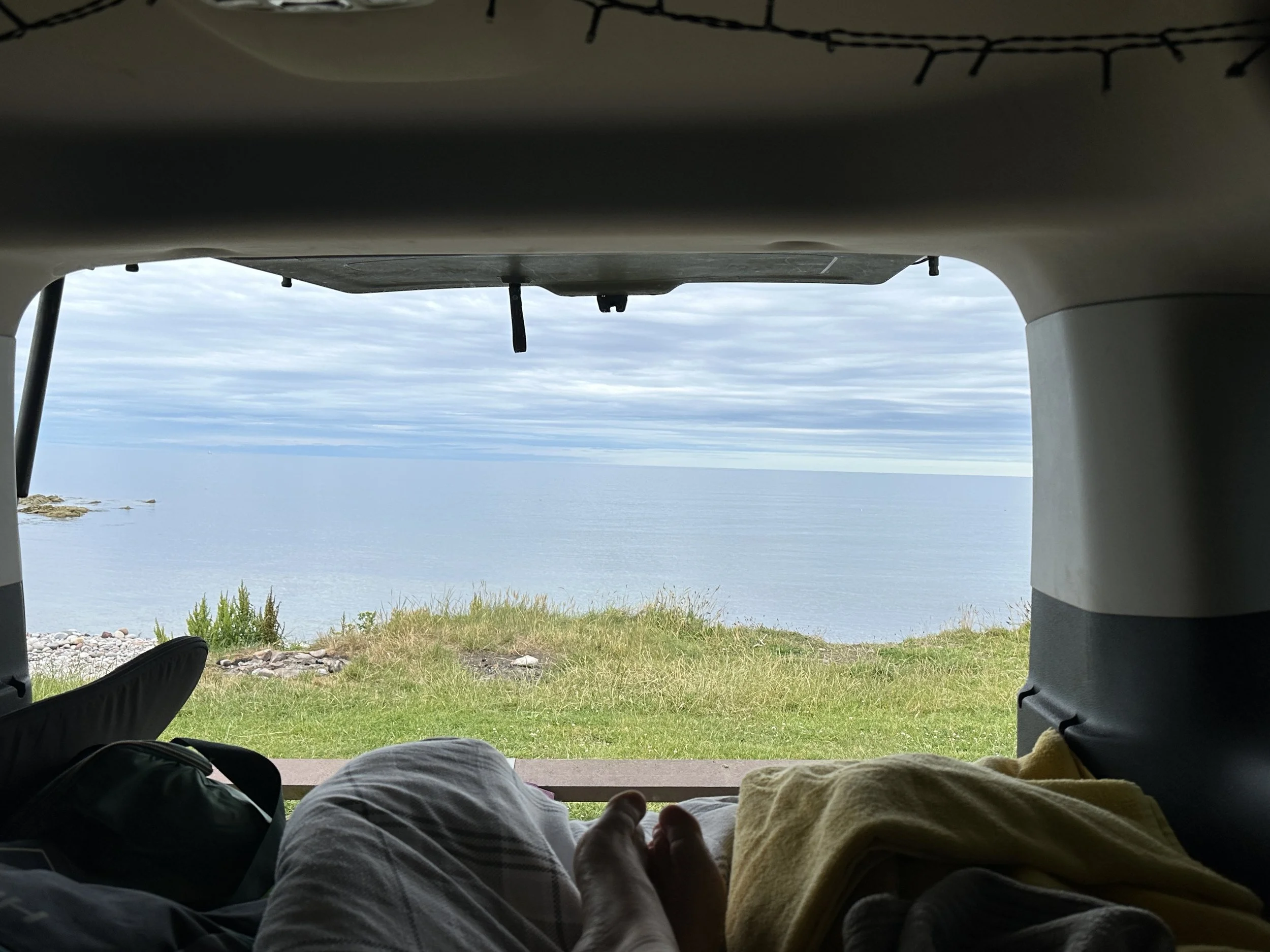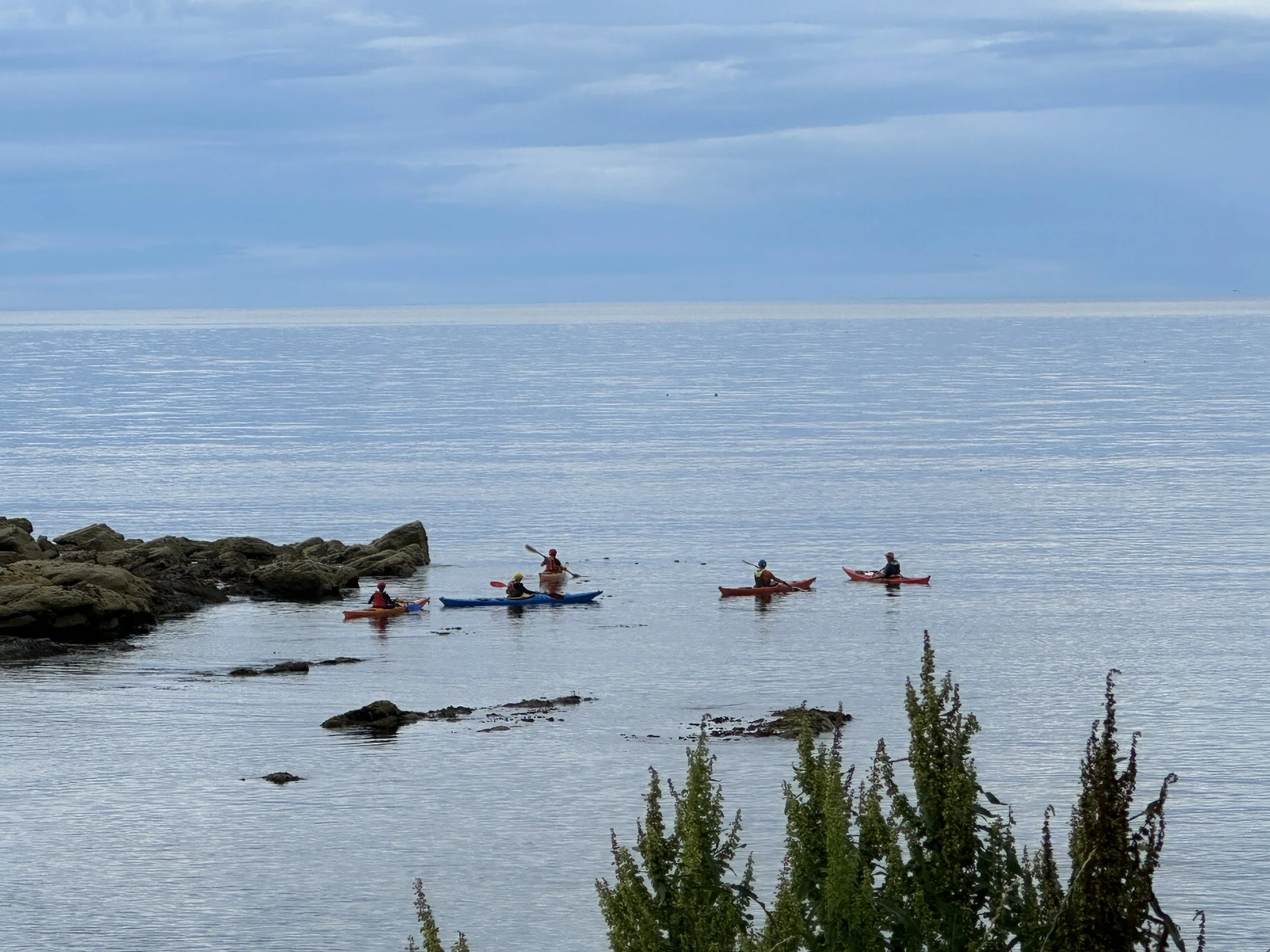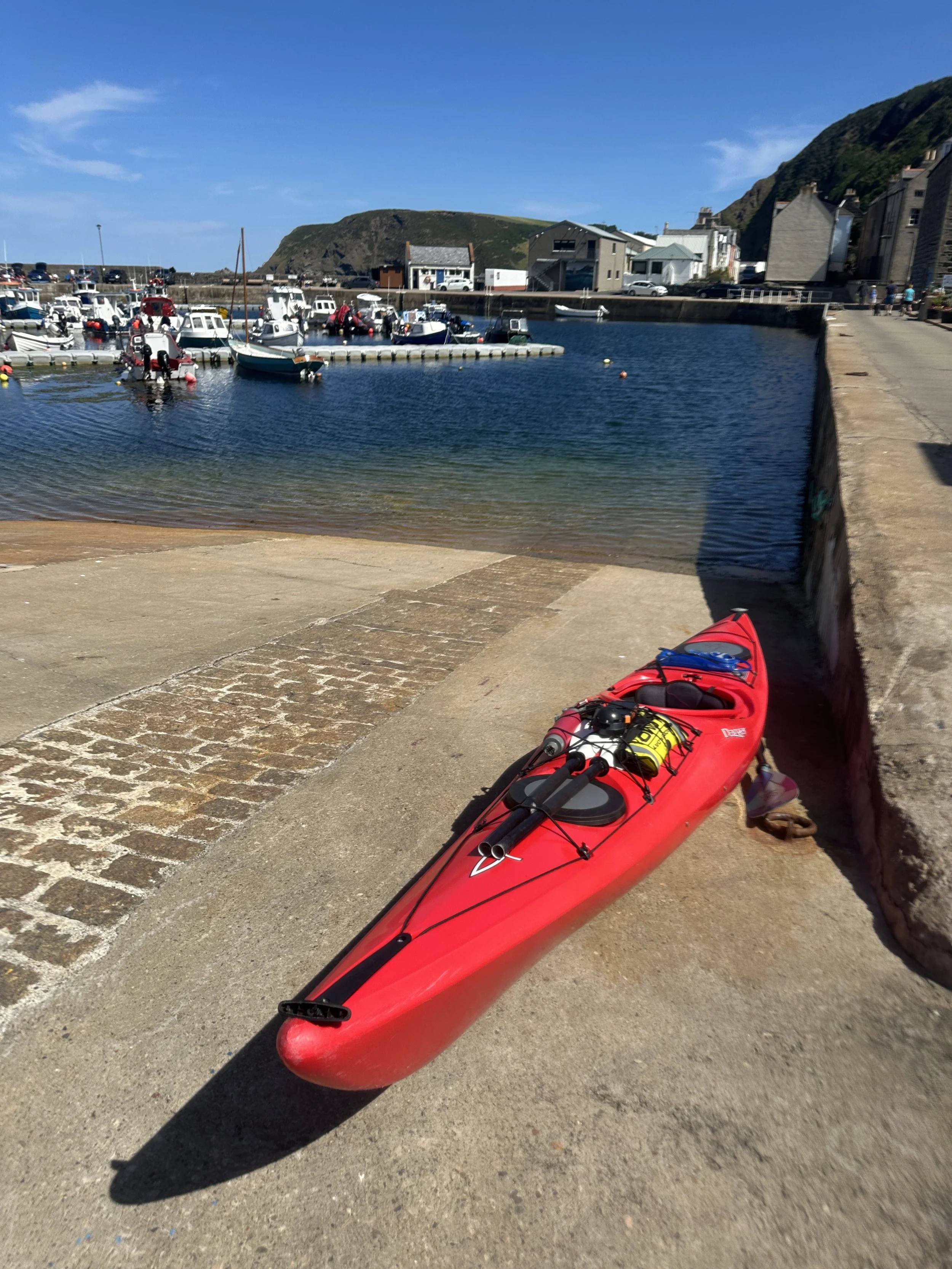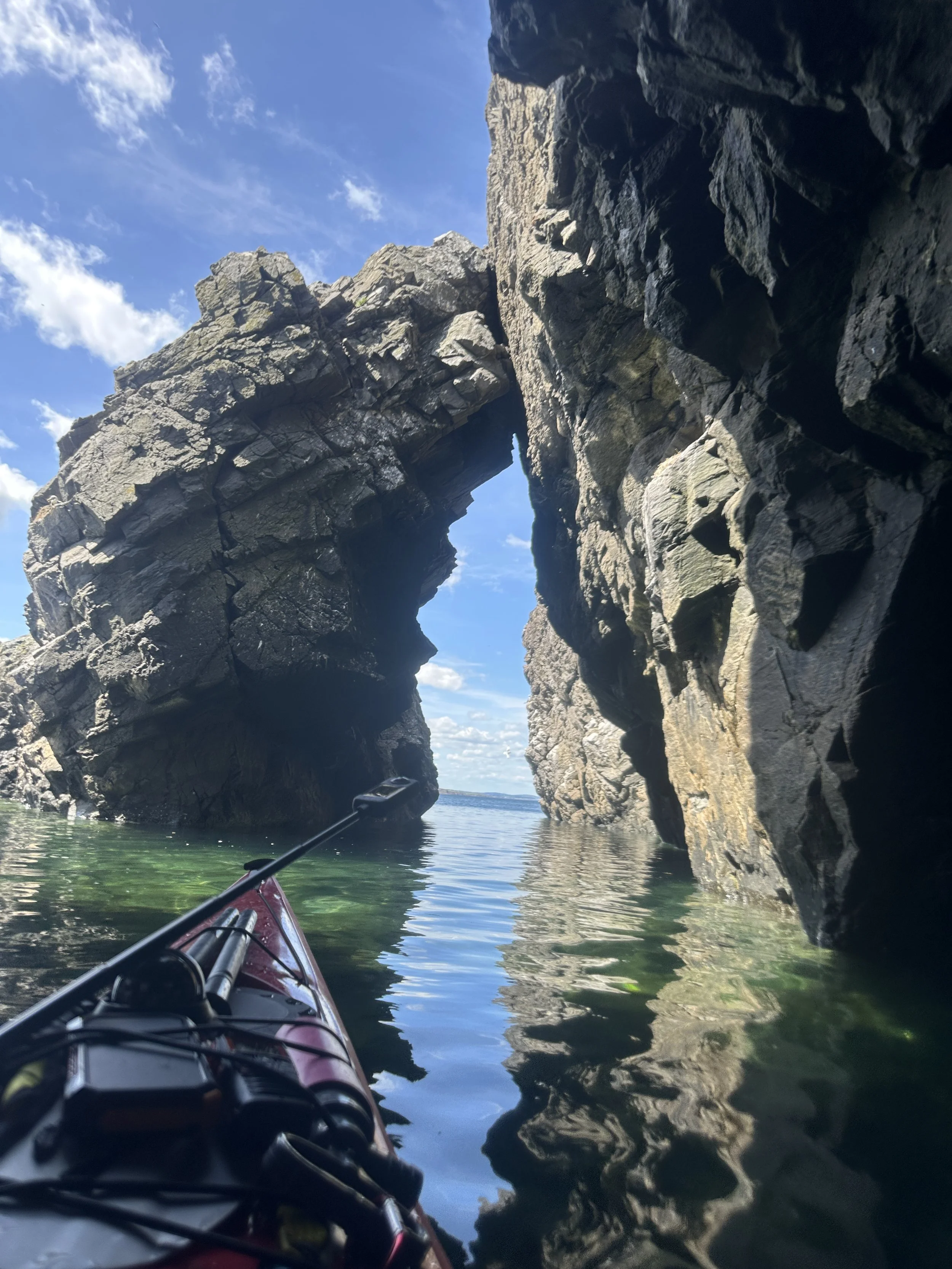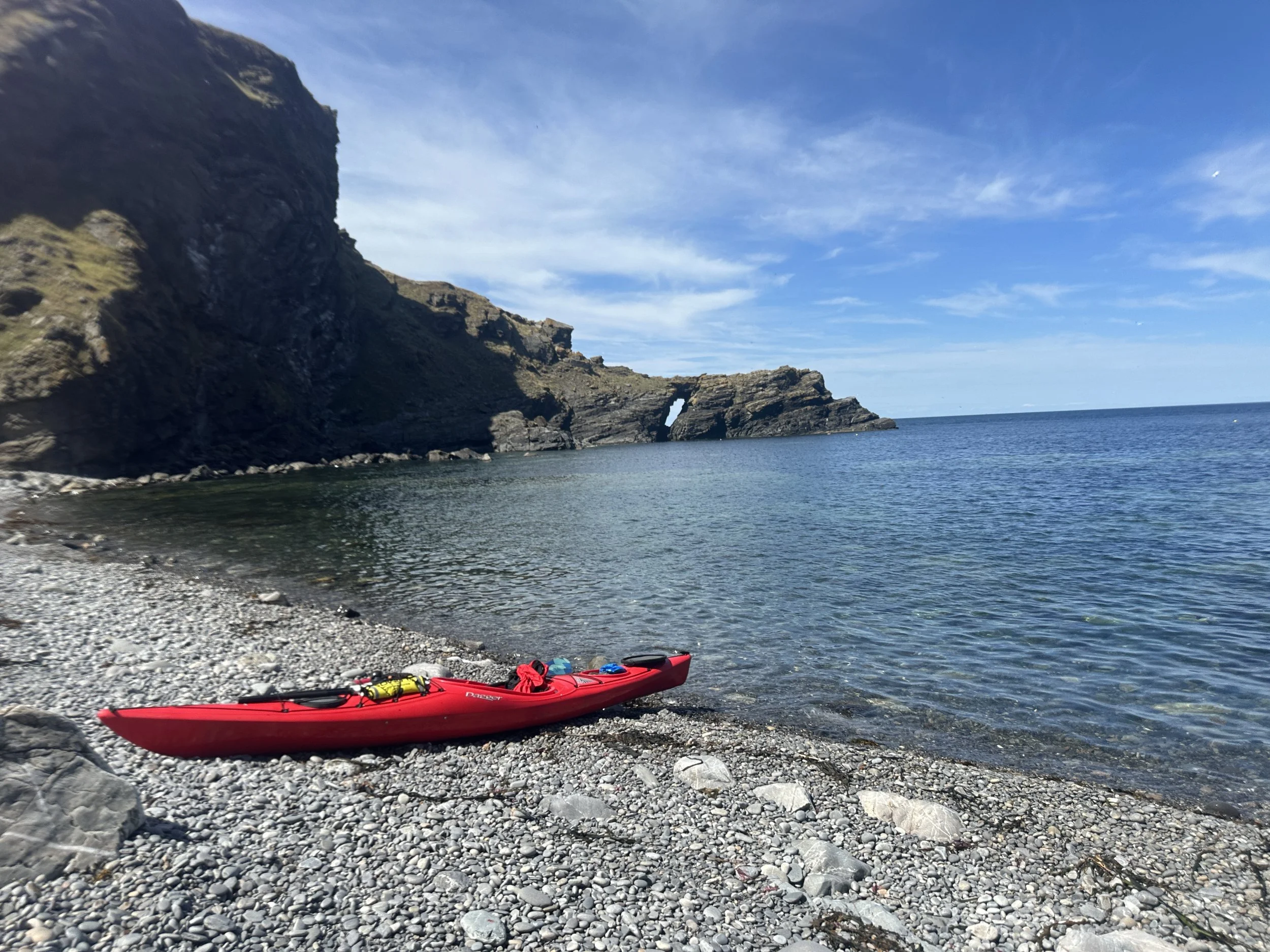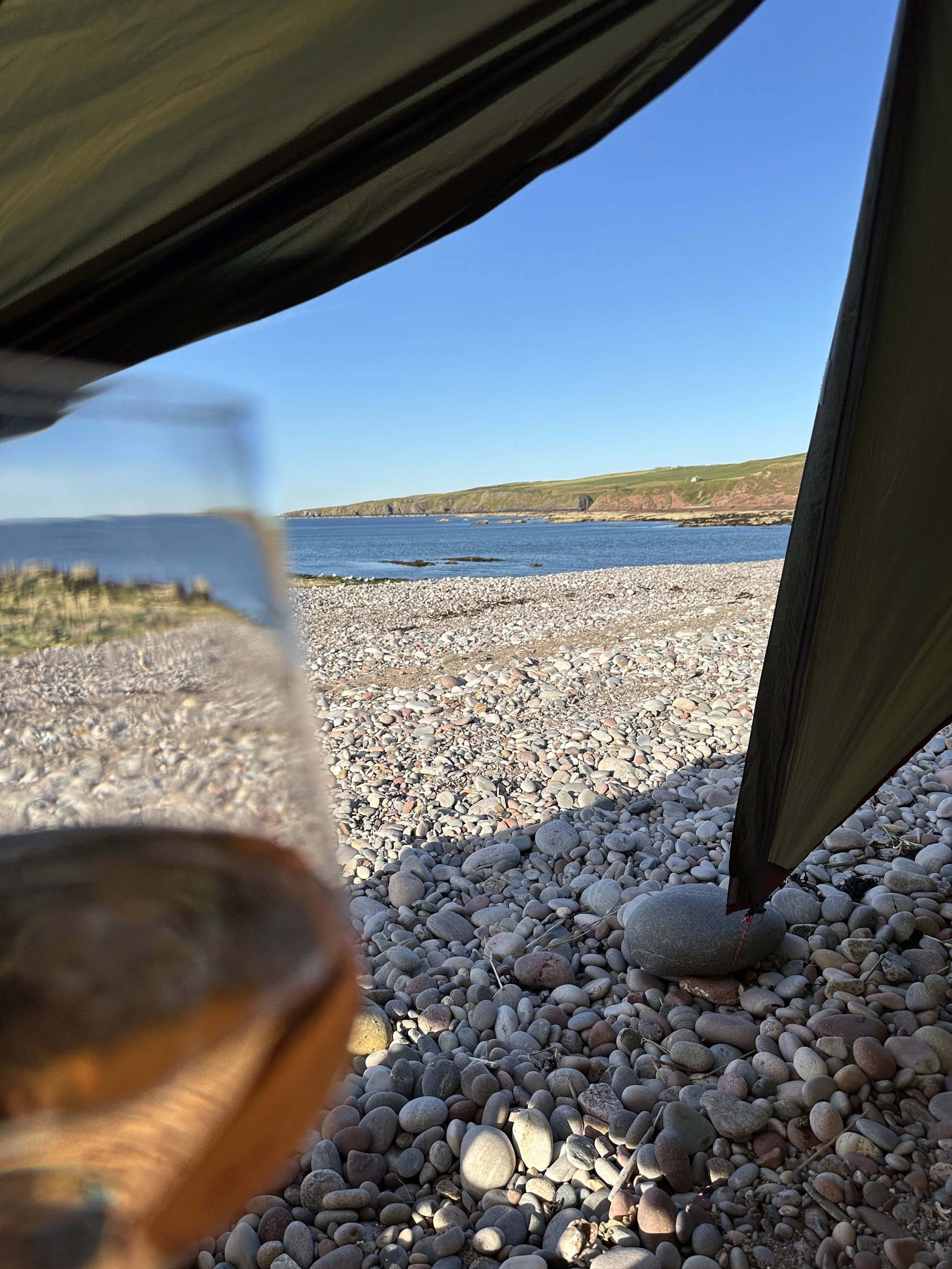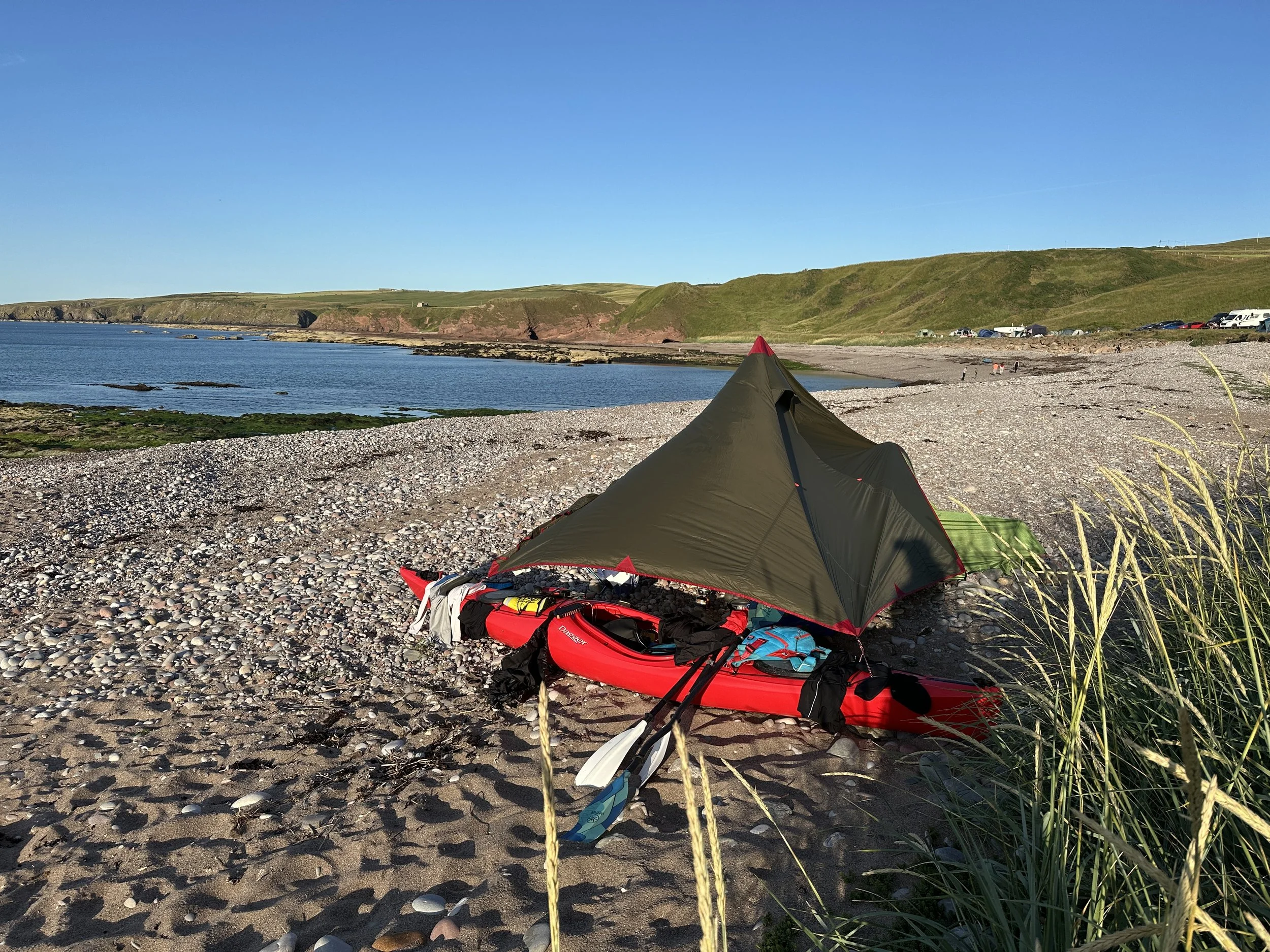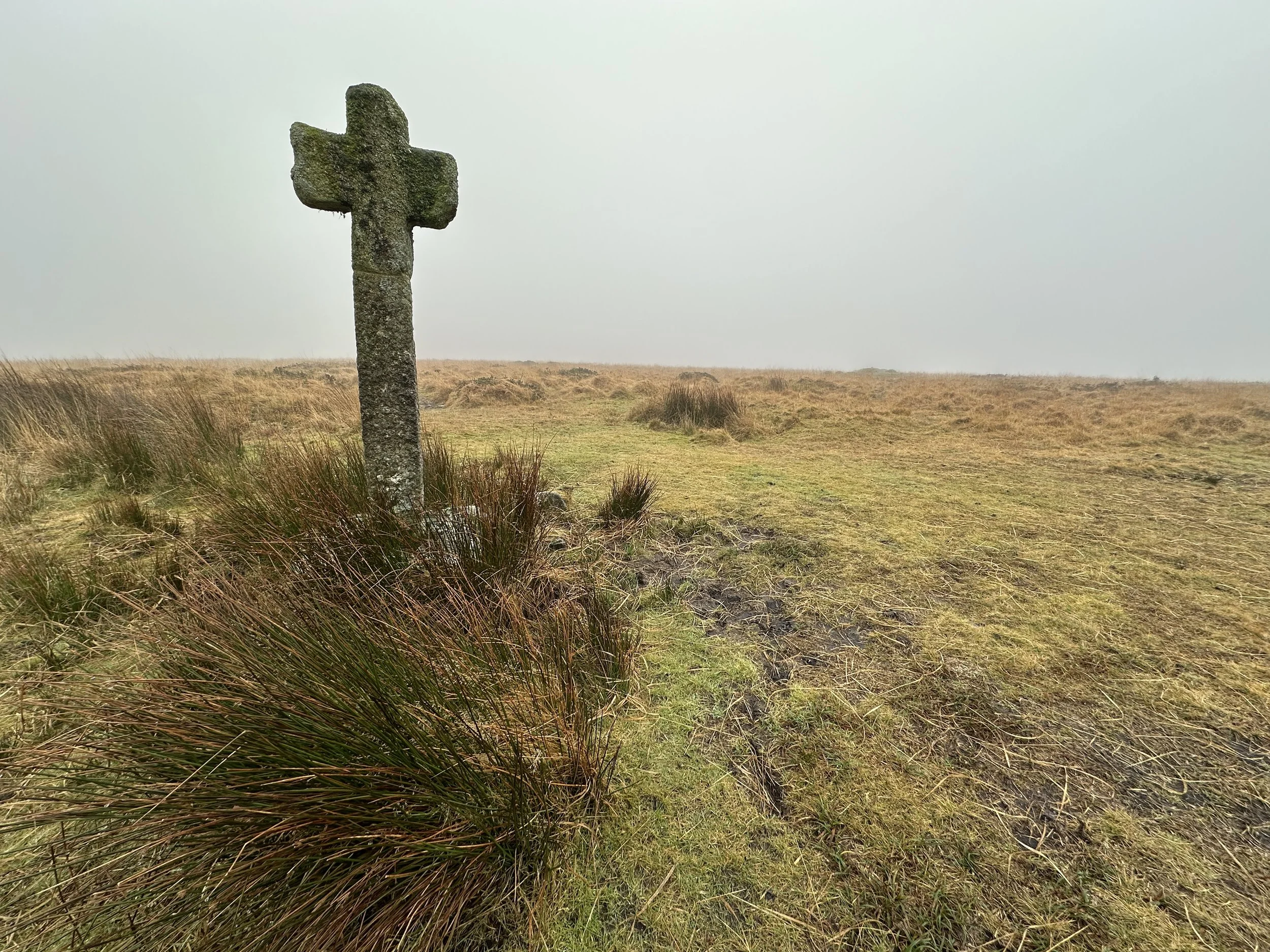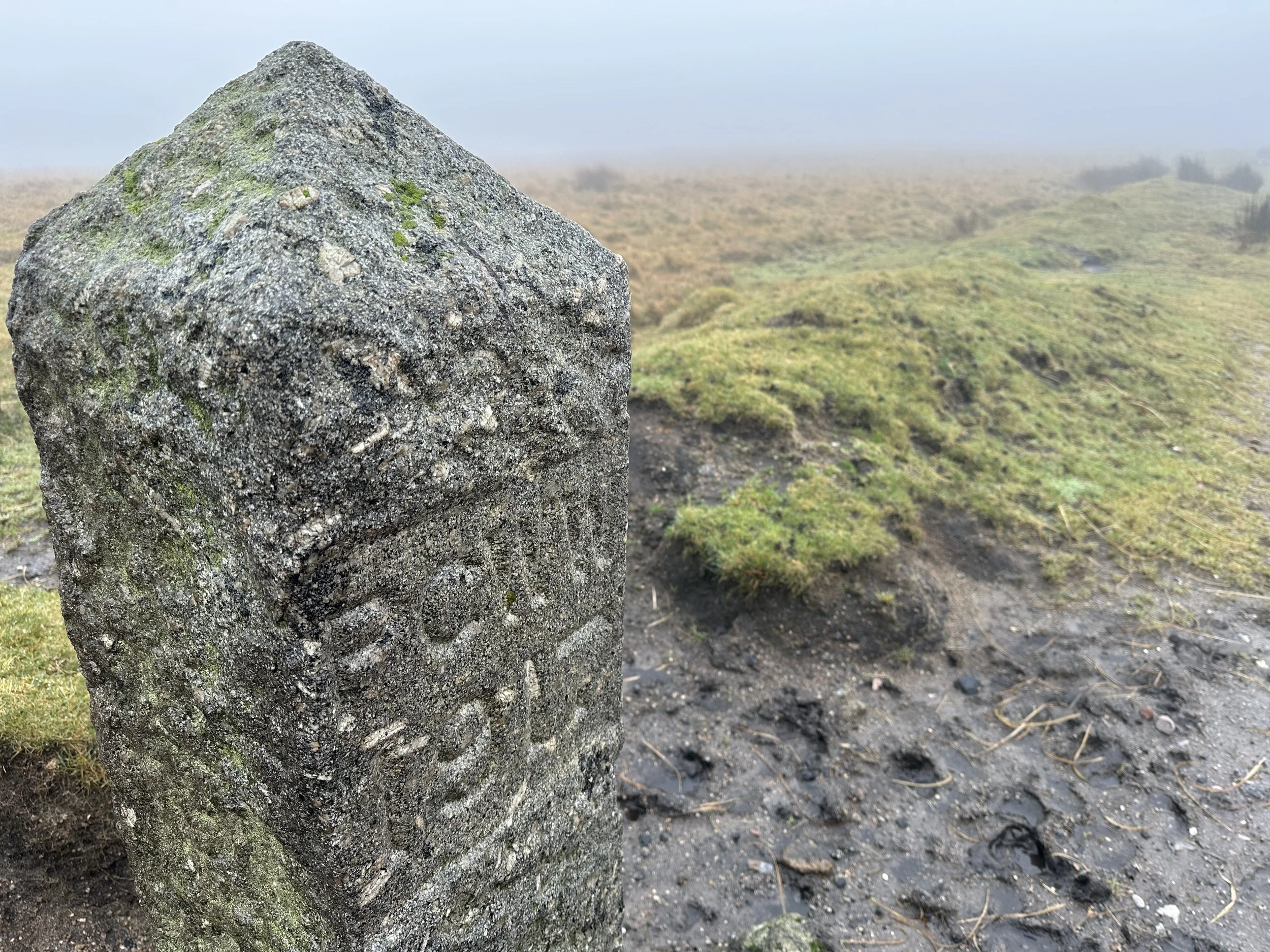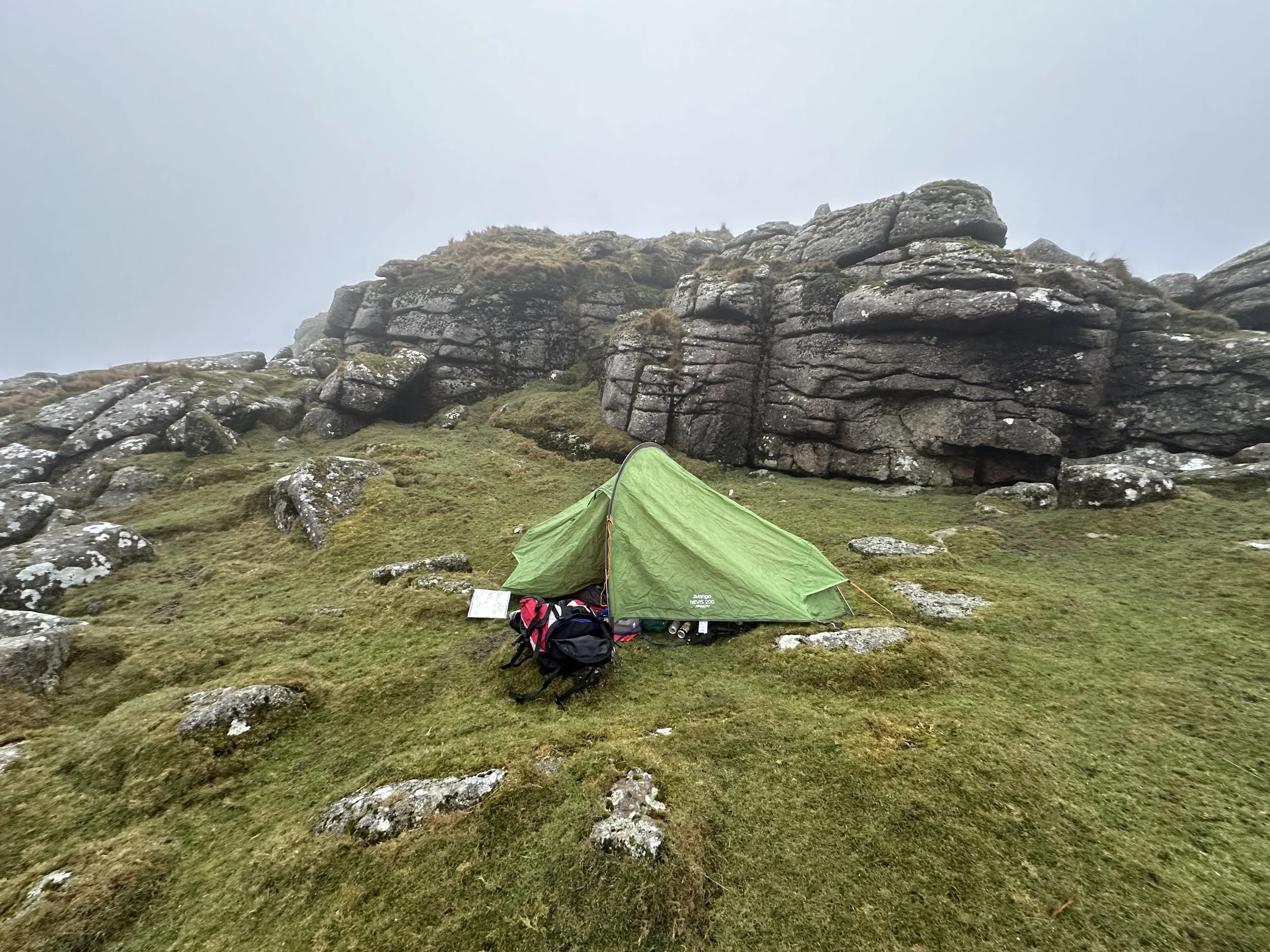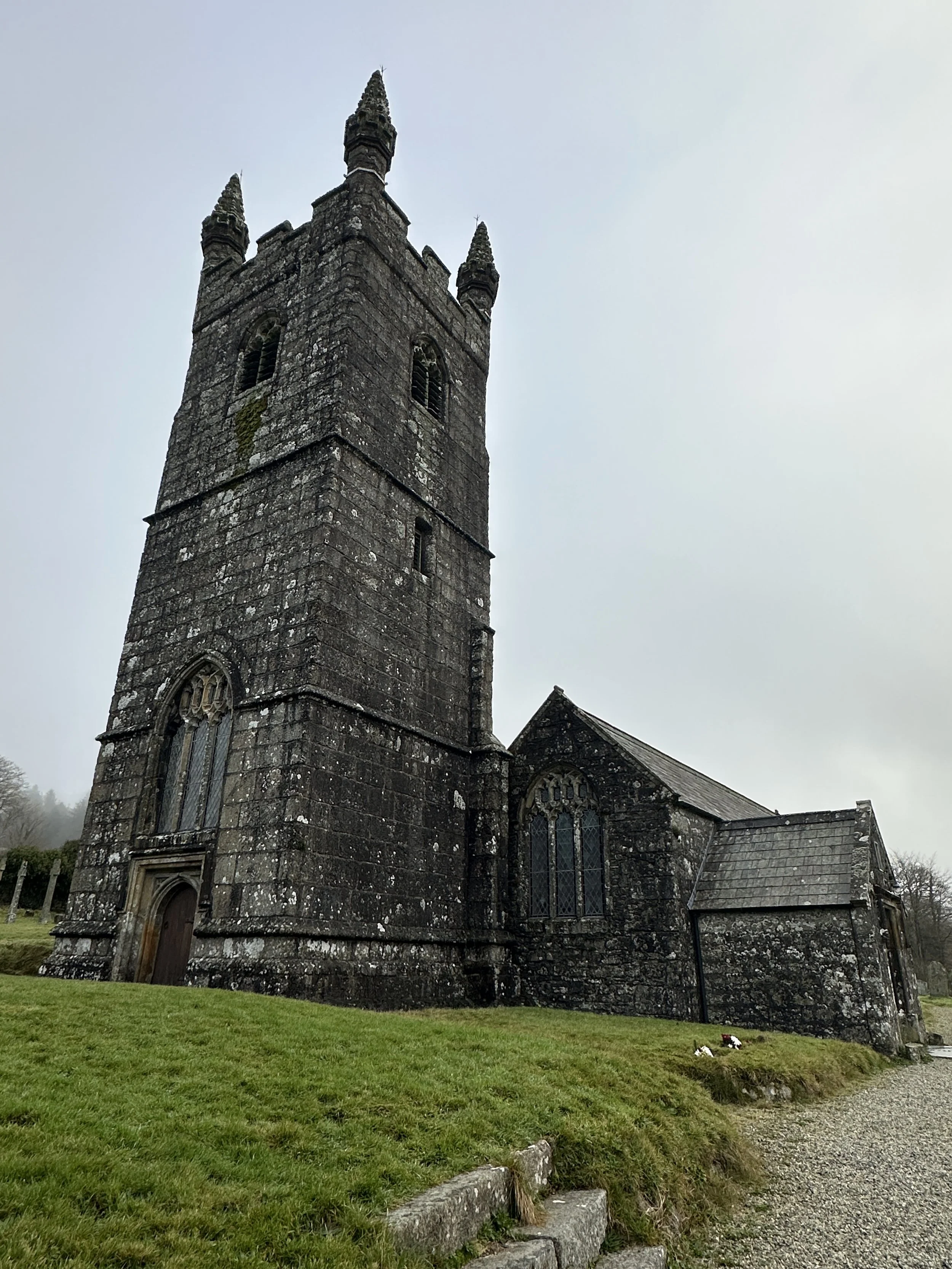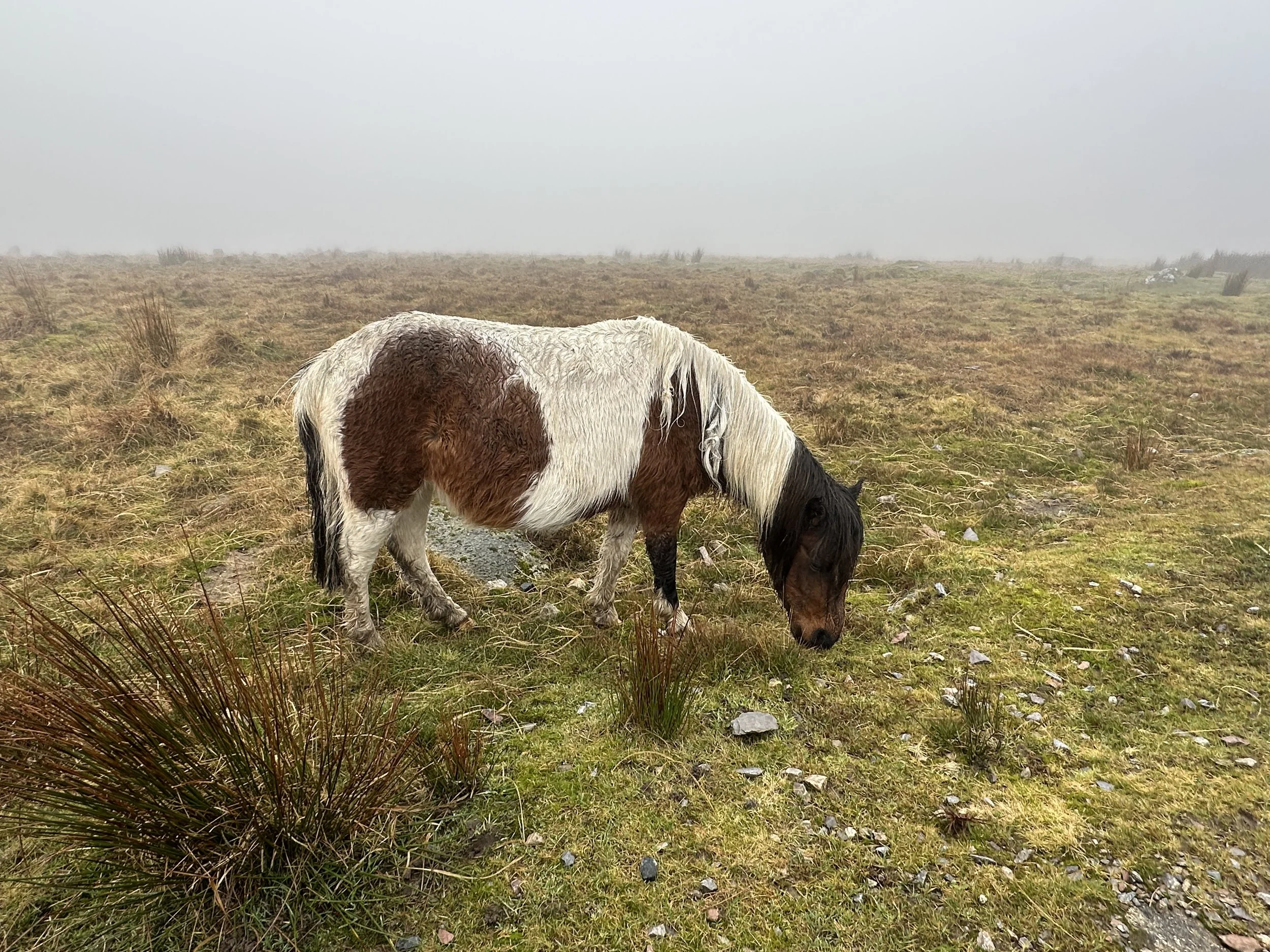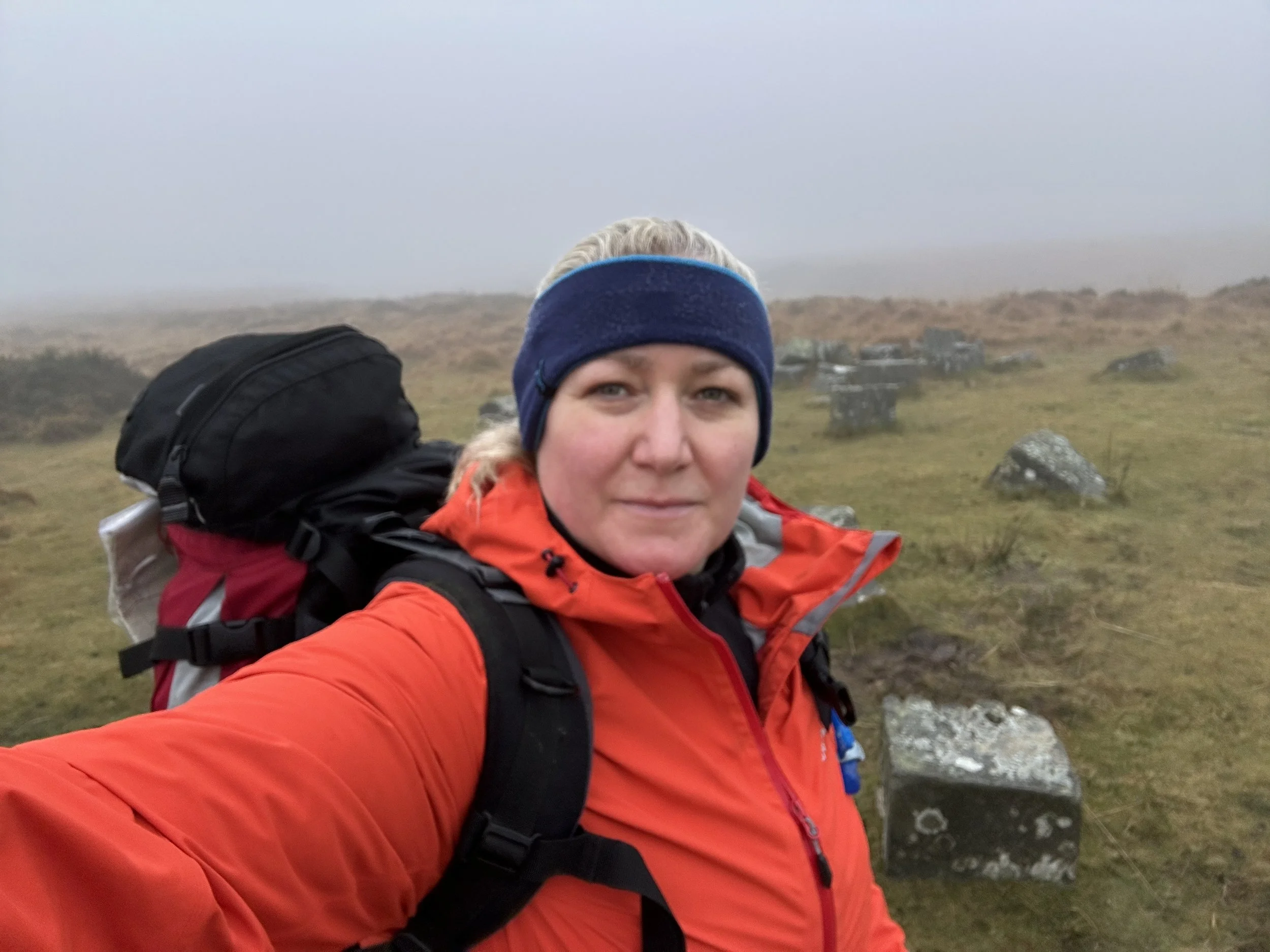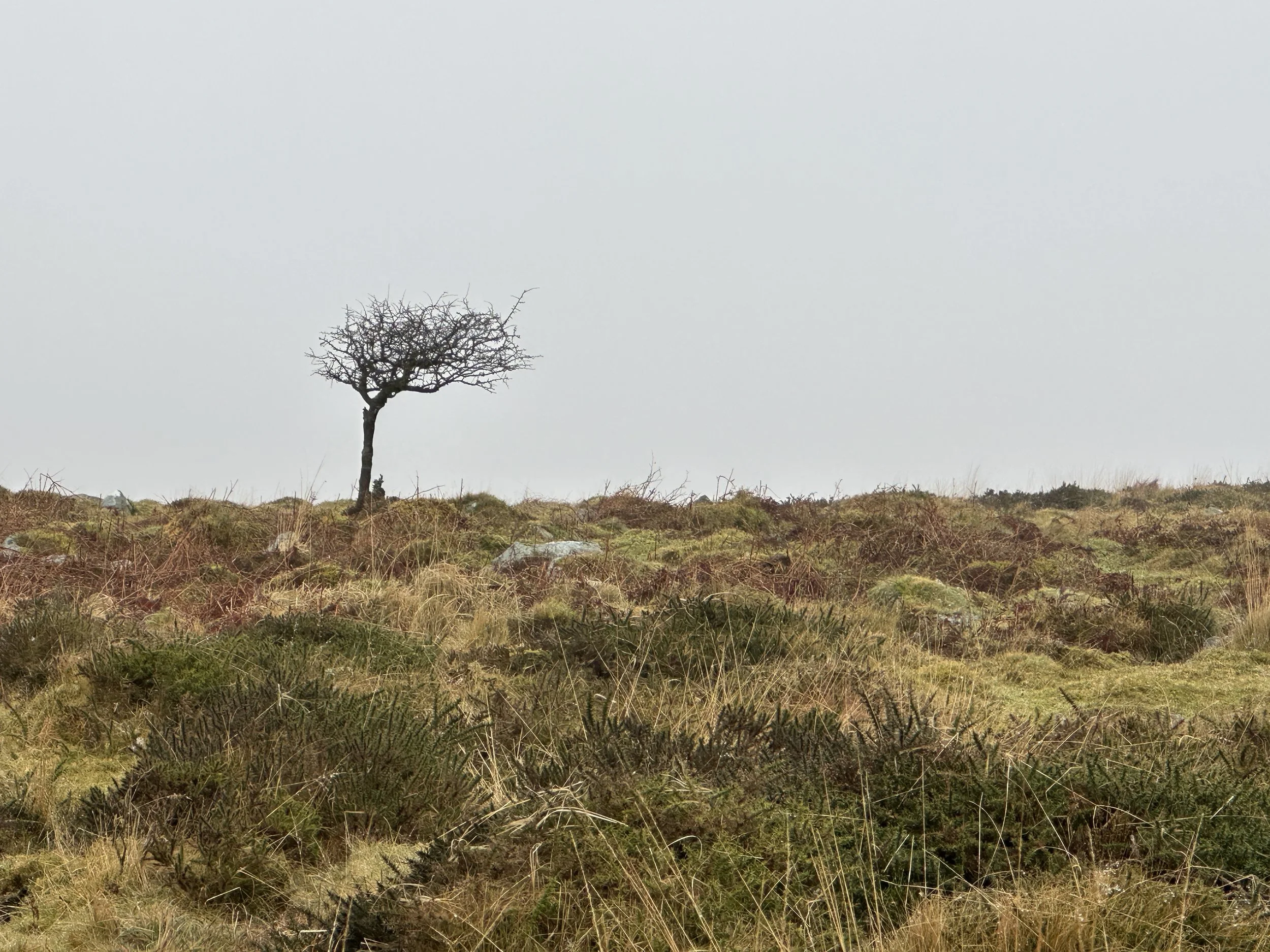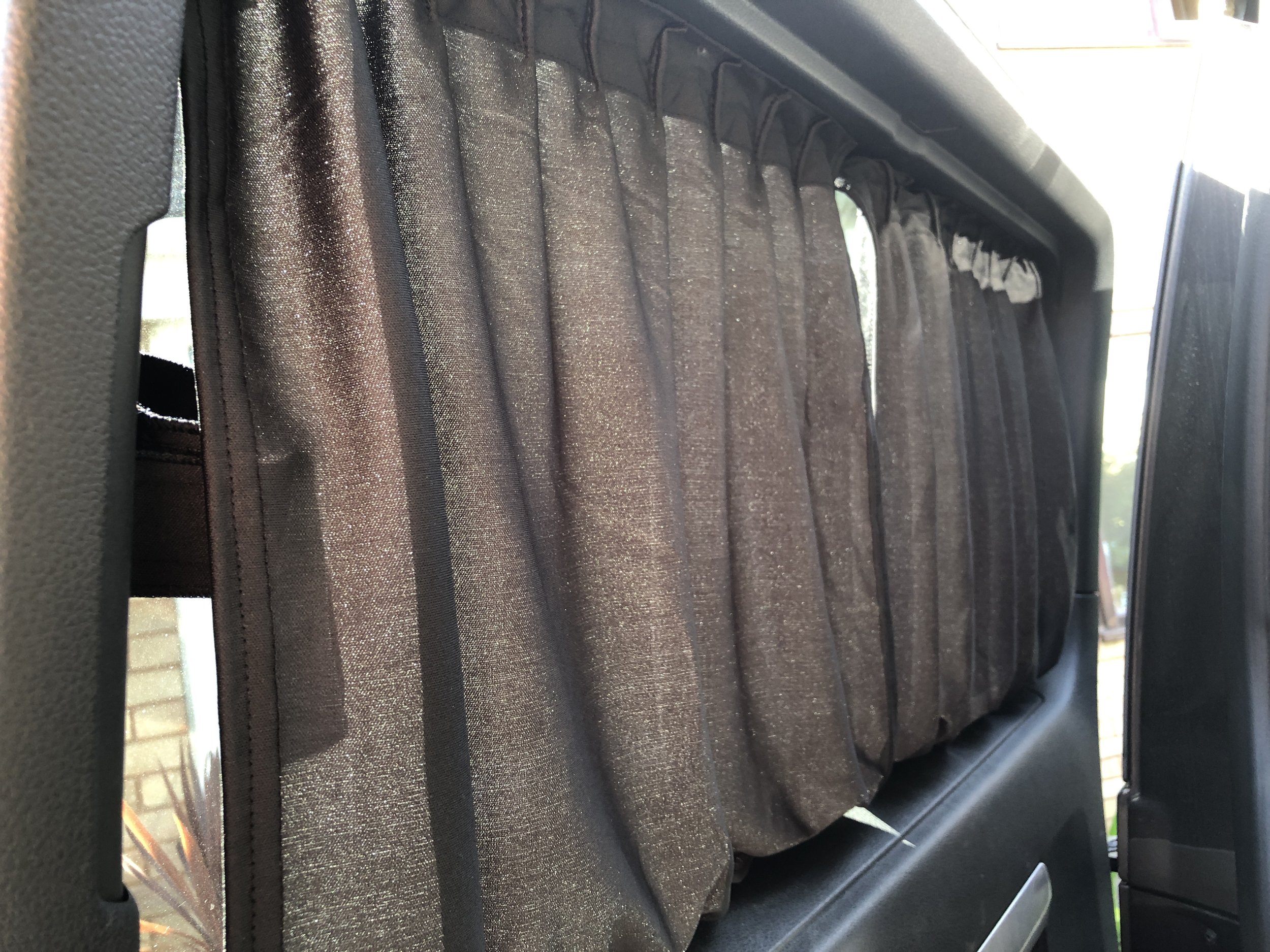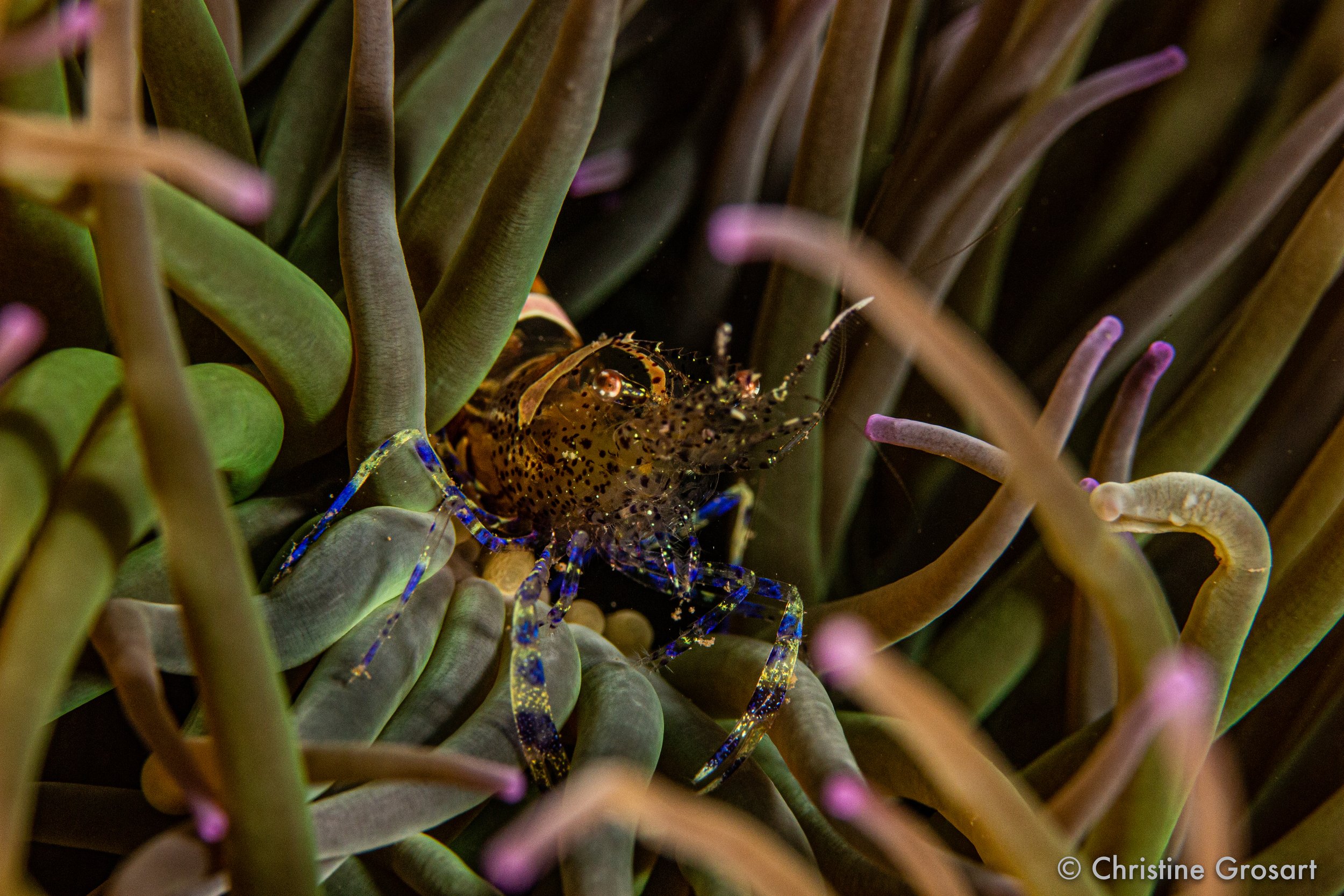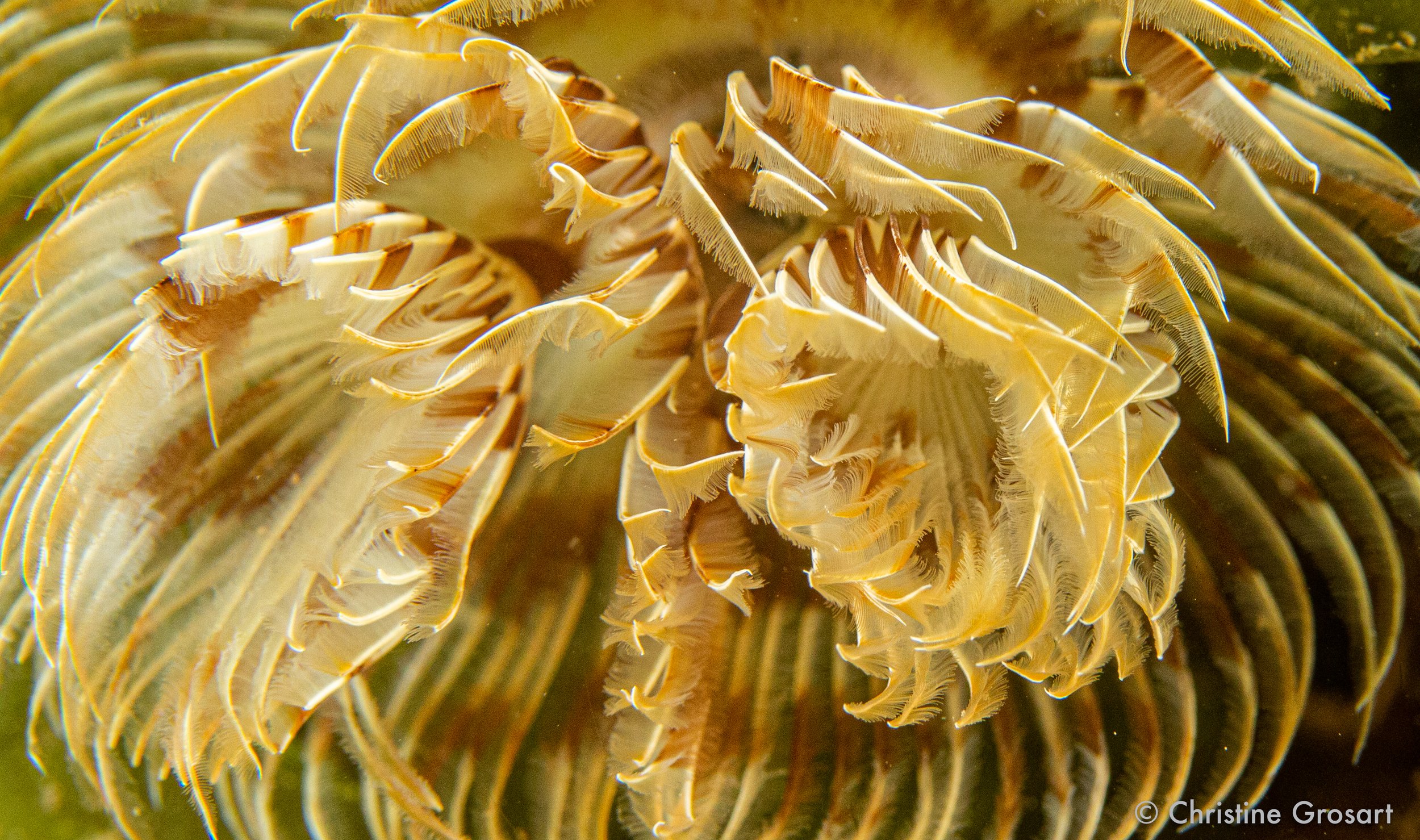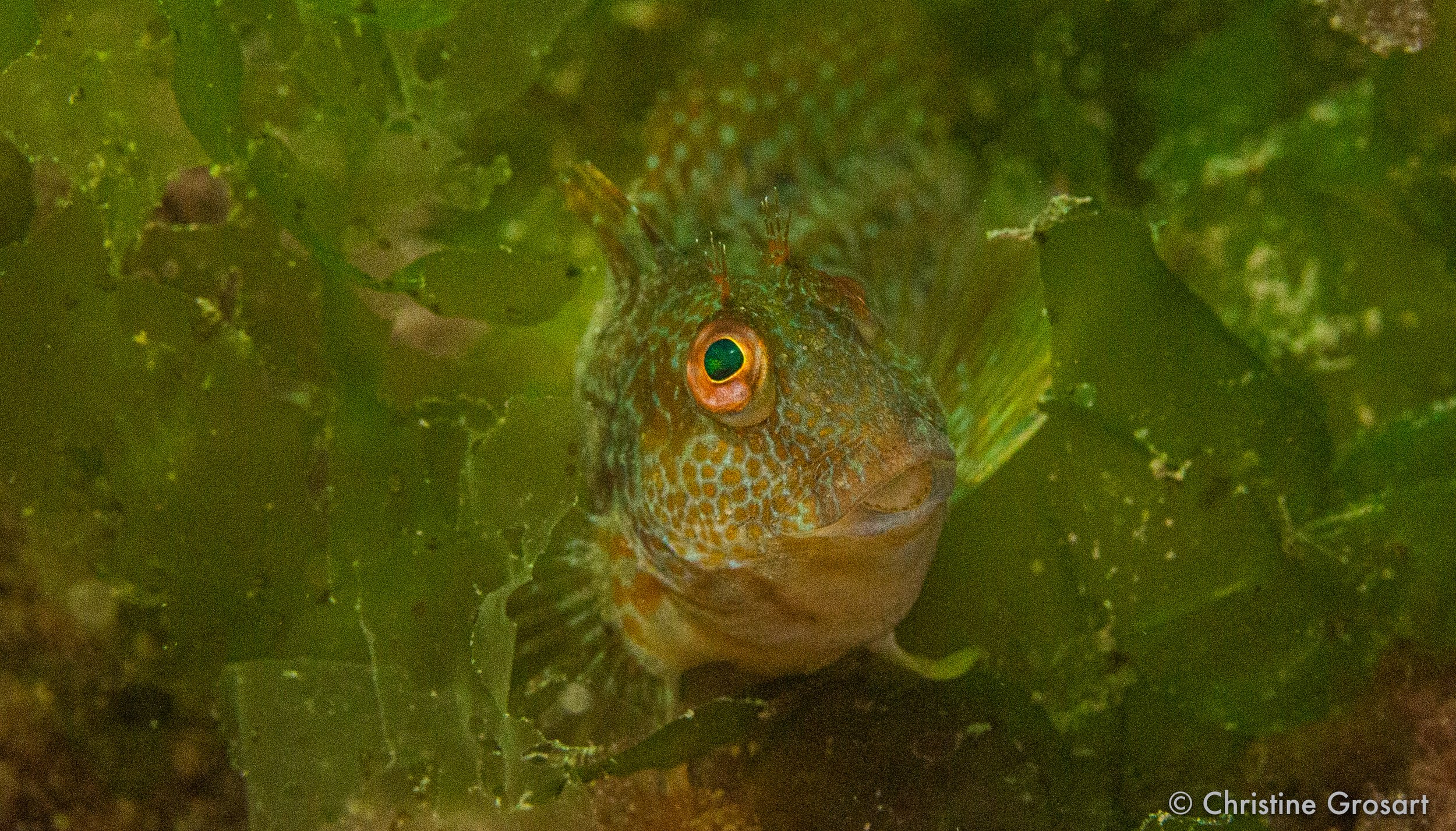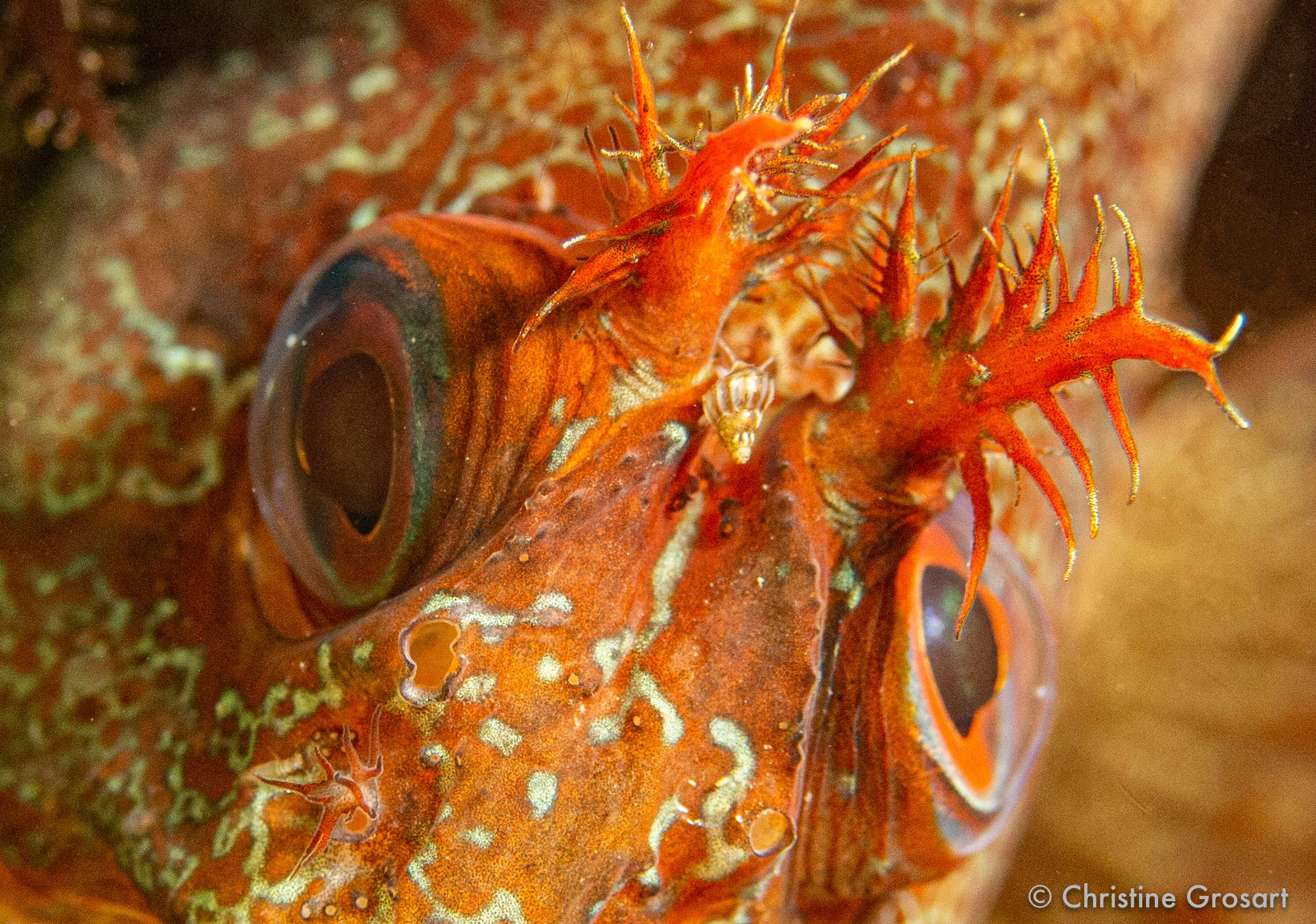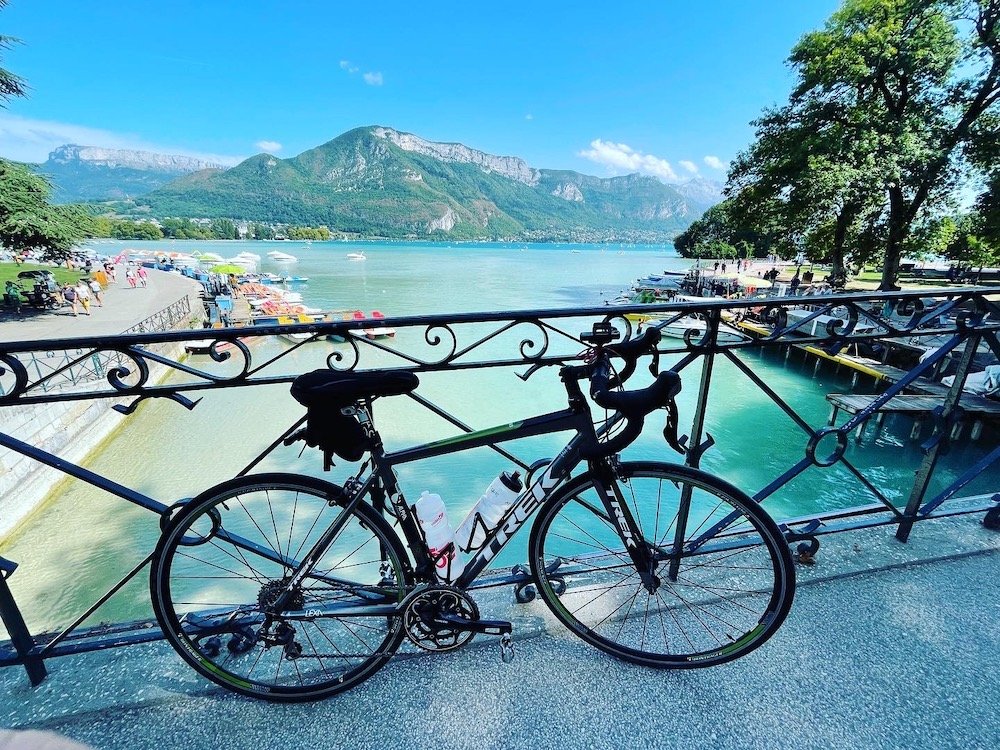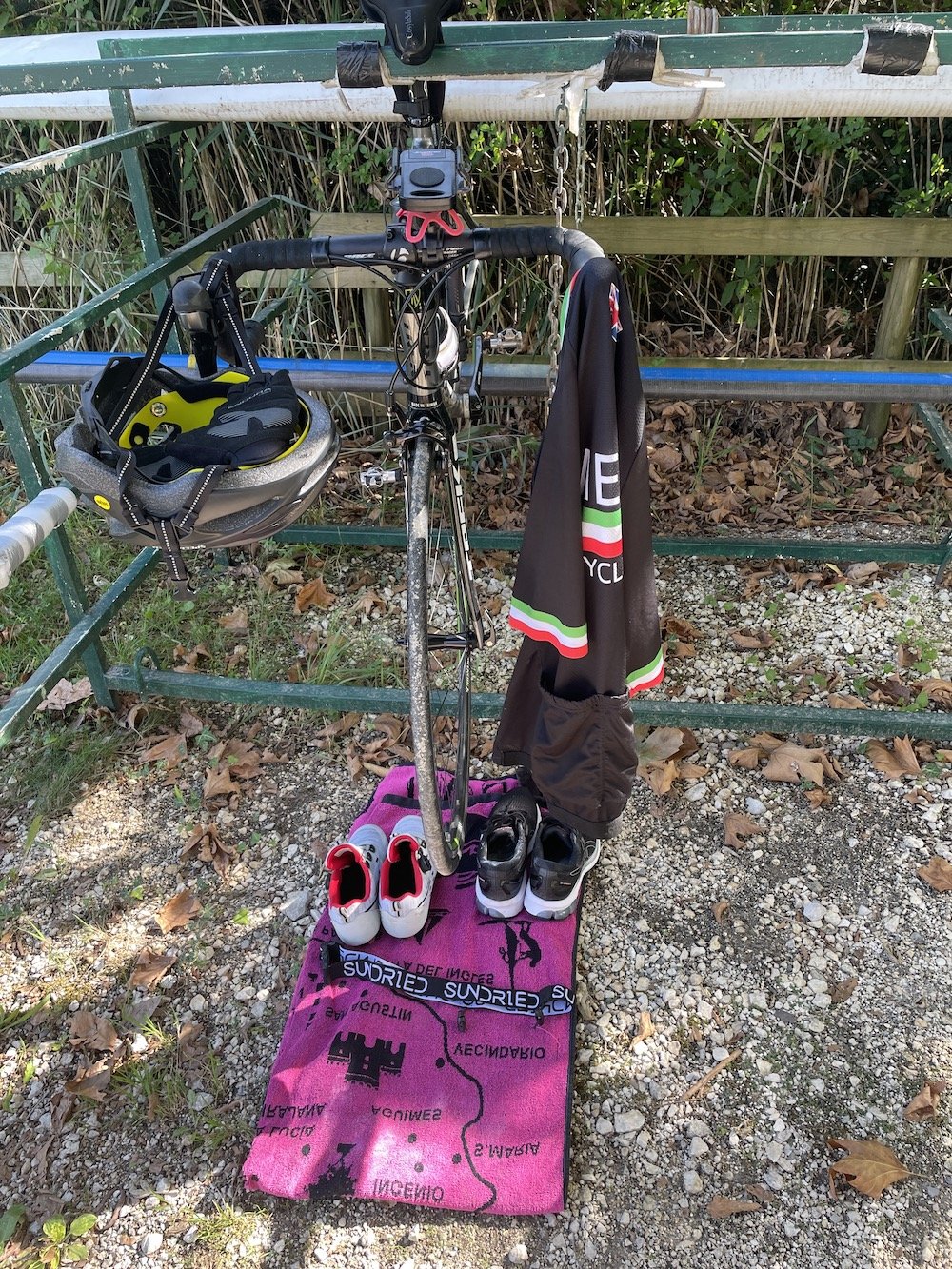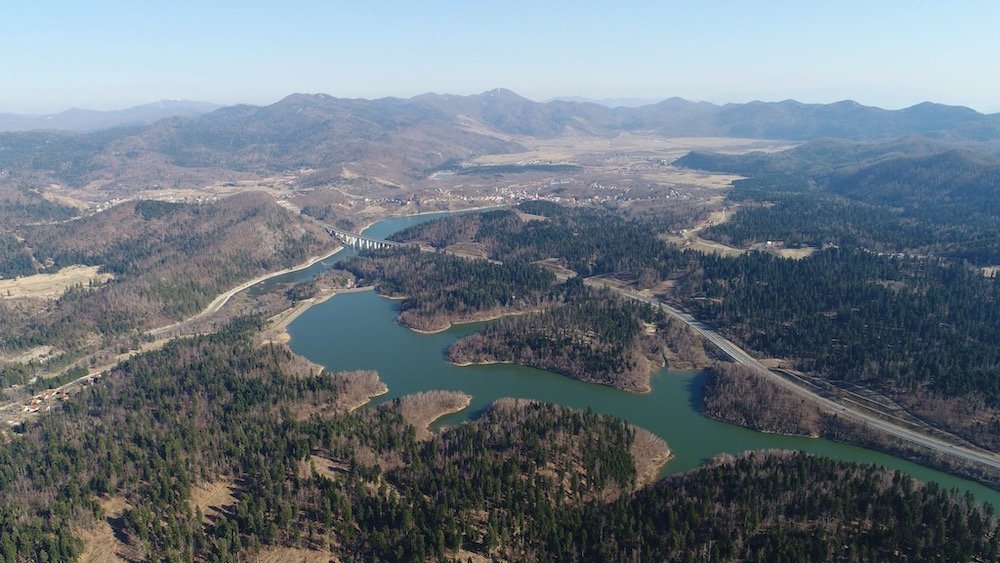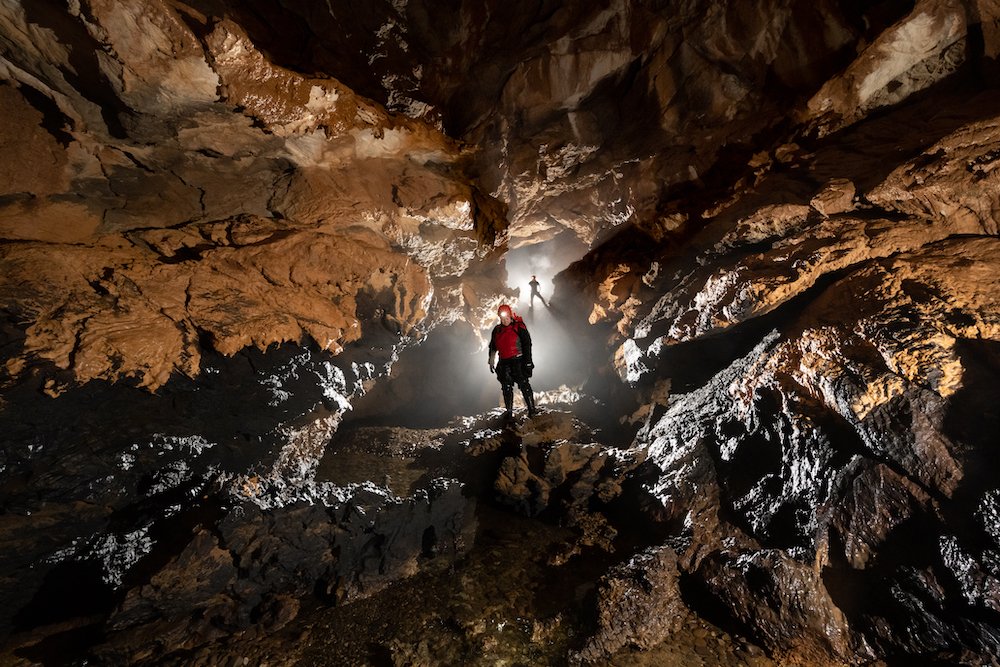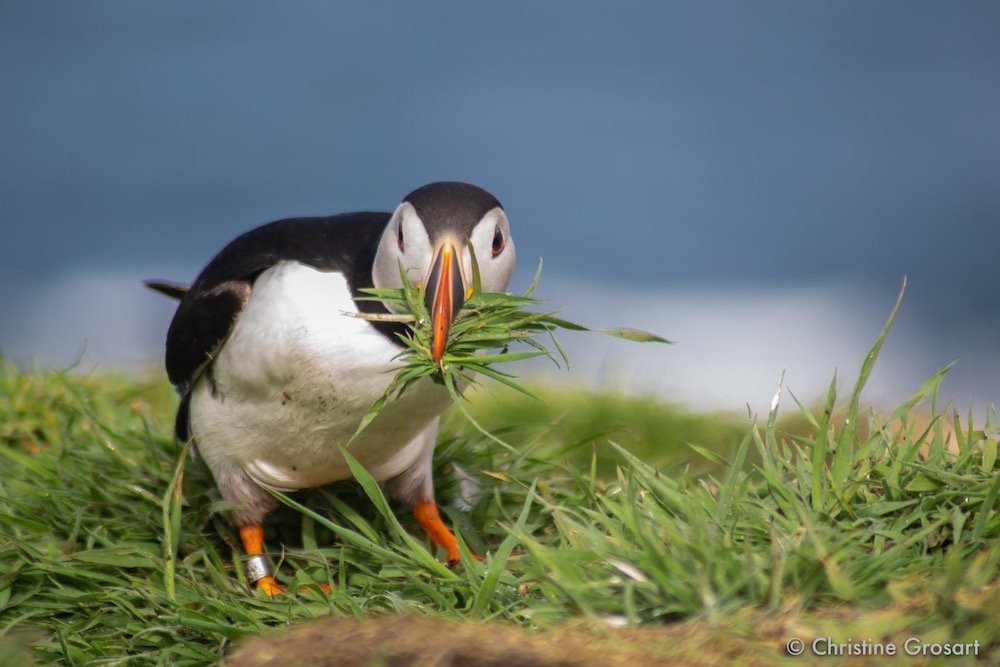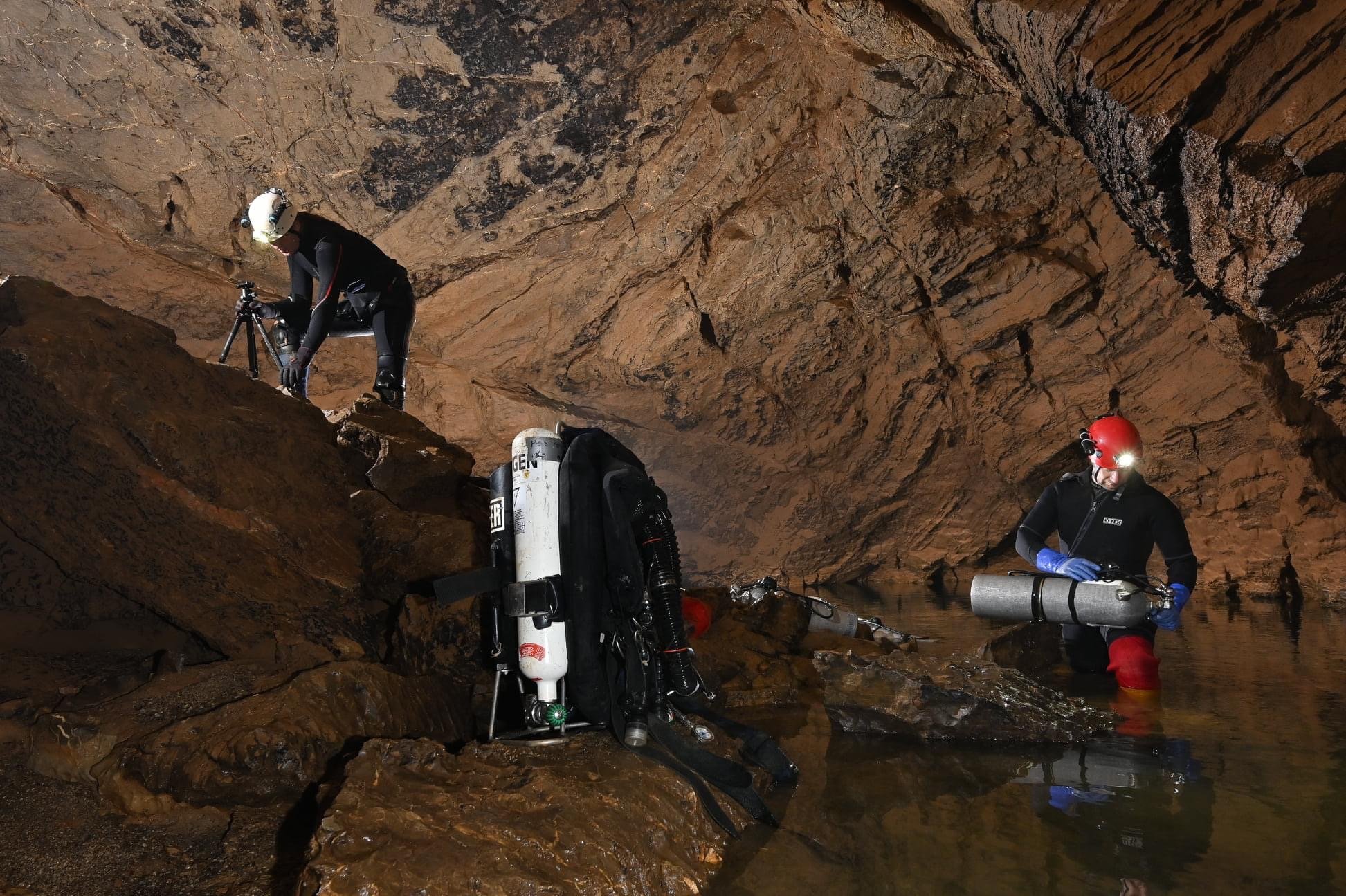The Surprise Scottish Summer (Part 2)
First view of the Summer Isles
The drive between Inverness and Ullapool can only be described as jaw dropping.
It was the most gloriously hot and sunny day, and everything was vivid green and blue, with dark grey mountains towering over the most incredible, breathtaking scenery.
Once through Ullapool, the road is mostly single lane with frequent passing spots. Instead of travelling along the coast it heads inland around several lochs and passes a stunning sandy beach at Achnahaird. The road then swings west and starts to gradually descend towards the sea when all of a sudden, out of nowhere, a sweeping bend gives way to a view of the entire Summer Isles.
I almost crashed my van and so did the family behind me! We all swung haphazardly into the passing place and whipped out our cameras quickly before heading on down to Port a Bhaigh campsite.
Heading to Sky from the Summer Isles
I had managed to book myself a front row seat right next to the beach and the check in was with a super friendly lady, who made sure I had a superb spot.
There was tonnes of space and nobody was on top of each other. I asked next door, a father and son in a rickety old campervan, if they minded if I fired up a small BBQ.
They didn’t mind at all and we got chatting. They were a bit ‘rough’ I suppose and I was wary of them at first.
Port a Baigh campsite
I had plenty to eat and drink and slept well before waking up to another superb day, perfect for exploring the islands by kayak.
But first, a morning swim was on the cards. I managed 20 minutes in my wetsuit, about 700m which was about as much as I wanted to push my arm, especially with a day of kayaking ahead. Plus, I kept on running into Lion’s Mane jellyfish. They pack quite a punch if they sting you. The further out I went, the more frequent they became, so I calmly swam back to shore and decided that was enough.
My plan was to do a lap of Isle Ristol and round the back of Eilean Mullagrach, but with no tides, good weather and no concrete plans, I decided to see where the mood took me.
I launched and turned south through Old Dorney Harbour. The water here was insanely clear and I could easily see the bottom, as jellyfish of all kinds passed by.
It would have been completely silent but for the screeching sea birds overhead who were going nuts about something (not me I hope!). I so hoped to see an otter, but none were forthcoming. As I headed across the glassy bay between islands I pulled into a rocky gulley and came face to face with an enormous bull seal. My god he was huge!
I back paddled away and he followed me, ducking and diving and popping up behind me.
He had quite a harem of ladies on the rocks who watched us, lazily.
Seal in the Summer Isles
I carried on round the back of a small island called Glas-leac Mor, which was home to a huge seal colony.
The paddle north along the west shore of this island was glassy calm, with the warm sun on my back and the sea was sparkling. Nobody really knew where I was and I didn’t care. This was true freedom. Responsible for only me, with seemingly the whole ocean to myself.
As I turned east towards the mainland, those squalls picked up again and I had a bit of a battering trying to get to a sandy beach on the northern shore of Isle Ristol.
Paddling the Summer Isles. Shot on Insta 360 (carefully!)
I landed and sunbathed here for a bit, taking the opportunity to fly my drone and get some stunning shots of the northern Summer Isles.
As evening was drawing in, I made the short crossing back to the beach and the campsite. I left my boat tied up as I figured I’d paddle here again.
After a shower I returned to my tent to find the ‘rough’ Glaswegian father and son had made a superb BBQ and had made up a plate for me!
It was an array of BBQ chicken, beef, salads, all stuffed into a Greek wrap. I was really touched and grateful and they were simply happy to see the excess of food they had made not go to waste.
That’s how it works up here on campsites in Scotland. Remember my shower/razor incident on Barra? The campsite owners found out about my trip to the local hospital before I even got back to the campsite! Everyone looks out for each other up here as it is so remote and seems to attract like-minded people.
My Strava kayaking route
Such people came into my life the next day.
The wind had picked up significantly and this was definitely not a paddling day.
My new neighbours were trying to turn a huge van awning 180 degrees the other way to shelter from the wind and it was like a scene from Carry on Camping!
One lady, Helen, was in serious danger of taking off like Mary Poppins, while her friend Michele was desperately pinning a huge unruly tarpaulin down by faceplanting on top of it!
Their partners were called Alan and Steve, which I thought was hilarious (Google it) and I couldn’t help but offer to go over and help. What then ensued was one of the funniest few hours I’ve ever experienced. They were fab people and I was soon invited for beer, from which I couldn’t depart as their elderly chihuahua had made herself comfy in my arms and was practically hibernating.
Christine, Helen, Michele
We had a great day and went for a freezing cold dip in the sea in our cozzies, among other nonsense which mainly entailed the men chasing our towels across the beach in the wind.
The next day brought calmer conditions, slightly, but Scotland was still not to be underestimated. Below are three photos from the same spot, only 15 minutes apart!
I had breakfast and launched my kayak again to head this time around the southern summer isles.
Passing through Old Dorney again, I set off to paddle anticlockwise around Tanera Beg and Tanera Mòr.
It was a choppier crossing than 48 hours before but totally safe. I hid in little gulleys and bagged some sea caves and inspected the litter that had blown onto the stoney beach on the southern side of Tanera beg. The southern side was sheltered for the northerly wind but turning north was quite a battle and my arm whined a lot. I took a break in a little harbour at the back of a fish farm and had some lunch. Crossing back to the mainland from the most northerly point was hard work into the wind and the waves concentrated the mind.
The Summer Isles, Scotland. Image: Christine Grosart
I was pretty shocked therefore to come across a family kayaking, with one boat occupied by a father and young child combo in a sit-on-top.
These conditions were in no way appropriate for this. They had no radio, no rescue kit and in shorts and t-shirts seemed blissfully unaware of how quickly the weather can turn, even in summer.
I paddled across their path and asked if they were Ok. Of course they were. They completely missed the point of my question. If the child had fallen in, I’m sure none of them had any clue what to do about it.
Figuring they were not my problem, and stupidity would take care of itself, I continued along the mainland coast back to the entrance of Old Dorney when….
Oh my God, what’s that?!
Silhouetted against the evening sun and sitting quietly in the bay was a scene from Pirates of the Caribbean.
A tall ship takes refuge in the Summer Isles. Image: Christine Grosart
A tall ship, presumably heading to the same Tall Ships race in Aberdeen, as I was, had come into the bay to shelter form a wind that was in the wrong direction to make any more progress.
They had sent a little rib to the shore presumably to get supplies, and I paddled up to the ornate wooden ship and had a chat with one of the crew.
I then headed over to a nearby sandy beach to unpack my drone and get some shots that summed up the beauty of this place. The ship, with it’s tattered looking sails and majestic outline was set against the most incredible backdrop. The sun got lower and the sea sparkled while the colours changed all the time. The battle with the wind was soon forgotten in this haven with a view.
I mooched back through Old Dorney, taking my time as it was so tranquil and beautiful and I also knew this was my last day here.
Tall ship rests in the Summer Isles. Drone: Christine Grosart/DJI Mini 4k
I packed up my kayak, made dinner, chilled with my new friends and got ready for the drive over to the Isle of Skye.
The ferries to the Hebridean Islands were all full, so I had decided to head to Skye, where I had never been.
My boss on the Kestrel, Stu, who seemed to be more excited about my trip than me, sent me a wealth of information on a munro called Sgurr Alasdair. The only trouble was, I was pretty sure I had not packed my hiking gear, having only really set up for a few days kayaking.
One very expensive trip to Ullapool Outdoors later, I was equipped with a pair of Soloman trail shoes. I already owned two decent pairs of hiking boots so really didn’t want to get another. But I didn’t have any trail running shoes so figured I’d give these a go. They were fantastic to be fair.
The view from the Skye Bridge was truly breathtaking and I earmarked it for a future paddling trip. But frustratingly, there was no viewpoint to park my car and take pictures nor fly my drone. I went without.
Drone shot of Glenbrittle and the Cuillin Hills behind. Shot: Christine Grosart (DJI mini 4k)
I found the campsite Stu had recommended to me, at Glenbrittle, and checked in. The lady owner happened to also be a medic and had worked at Iqarus, my first offshore company. A small world indeed. She had upped sticks and set up a life running a campsite between the ocean and the mountains and it was stunning.
The cosy cafe had pizza evenings and the campsite sported new toasty showers – it was a serious step up from the barren camping field with ‘no facilities’ that Stu remembered. It was utter luxury.
I pitched up wherever I wanted, but always a front row seat by the ocean. I couldn’t get over the view. If I faced one way I was looking out to sea. If I turned 180 the other, I was staring up at the intimidating Cuillin Hills and the imposing Sgurr Alasdair, the highest peak on Skye.
Facing north from Glenbrittle
Facing south from Glenbrittle
It was too windy for sea kayaking, so my mind was made up. I would head up to Sgurr Alasdair. With all my triathlon training, how hard could it be?
The gradual rocky path ramp up to Coire Lagan was an absolute delight. The path roughly follows a singing stream with mini waterfalls and navigates some fun lava flow hopping as you enter the middle of the ancient volcano.
Easy going path up to the Cuillin Hills. Image: Christine Grosart
There were a handful of people about, but in the main I was all by myself and it was wonderful. Most folk stopped there to look at the lake, but I was headed up to the top to get a look at the view of the famous Cuillin Ridge. I was pretty sure due to the wind and my lack of helmet, I’d not top out on Sgurr Alasdair itself and opted to aim at a scree slope dead ahead which would land me on the ridge somewhere just east of Sgurr MhicChoinnich.
It was steep. Very steep. I hate scree skiing at the best of times and I leaned into the choss that moved each time I did, trying not to literally get blown off the mountain.
Red line = My route. Blue line = the route I should have taken to Sgurr Alasdair Summit. Image from Google Earth.
It seemed to take ages to get up to the ridge but I finally made it and met another team coming back down. I really should have brought a helmet. The scree slope was absolutely steep enough for decent rocks to unstick at will and whistle through the air. I stayed out of the firing line and kept going, feeling slightly safer the closer I got to the ridge.
A bit of scrambling later (great with my dodgy arm) I came across ‘the’ stone circle and the incredible view Stu had been talking about.
Cuillin Ridge, Skye, Scotland
On top of Skye
It was an incredibly clear day as no clouds of clag could stick around in this wind. I didn’t fancy heading up the next very exposed scramble, so I had some snacks and delayed the inevitable trauma of scree skiing back down again.
It is fair to say I got better at it as time went on. There is no point tensing up and shitting yourself because the mountain is going to move whatever you do, so you may as well go with it.
I chose scree that was big enough to move slightly so as not to trip over it and plummet to my speedy death, but not so small that I caused an unstoppable avalanche.
I concentrated on picking the right sort of scree and managed to get back down to the ‘normal’ track without incident. Once on a proper path I instantly went absolutely flying on a thin layer of chippings which laced the underlying granite. Bastard!
And again!!
Hell fire, I’d come all the way down that terrifying scree ski slope and couldn’t stay upright on a bit of tourist path!
I never go anywhere without my Leki walking poles and they saved my backside on multiple occasions.
The only way is down….Image: Google Earth.
Once back at the lava lake, of course it started to rain. Naturally I had left my goretex coat at home, not needing it for sea kayaking. So, I put on my £20 pac-a-mac that I reluctantly bought in Ullapool and trotted downhill back to the campsite.
The showers were more of steam room when I got in there and I knew I would be sore in the morning and boy was I!
I may well be a triathlete but nothing kicks your arse like a Scottish hill! All it did was make me want more, but I was sorry to have to go. My friends from Port a Baigh had also come over to Skye and we met up in the evening for a good chin wag and some whisky.
Suite in Mal Maison, Aberdeen.
Soon, it was time to go. It is a long old slog back over to Aberdeen from the West coast. For some reason my sat nav decided to take me the ‘scenic route’ which is a fiddly to drive, especially with a sea kayak on the roof, but the views more than made up for it and I was in no hurry.
I rolled into my favourite Scottish Haunt, the Mal Maison Hotel, which I love not only for the superb rooms, food and whisky snug, but the easy parking that can accommodate my car and kayak.
I grabbed some fizzy wine and sank back into the free-standing bath, still sore as hell from my Sgurr excursion.
One steak and chips later and a good bath and I was almost human again.
This was just as well because it was time to go out again!
The next day I had booked to go and see the Tall Ships race in Aberdeen but not only that, I’d wrangled my mates Toni and Gail into coming along to the evening party. The Ministry of Sound Orchestra were doing an outdoors gig and I had been looking forward to it all year.
Of course it was drizzling. But, being mostly populated by people my age who were hard core 90s clubbers, it didn’t matter. We dressed for the occasion, got drunk and had an evening to remember.
The Surprise Scottish Summer (Part one)
Playing with tall ships in the Summer Isles. Heaven unfiltered.
One of the best parts of my job is looking out to sea and feeling the warm sun on my back, the glassy, gentle carpet of the ocean moving ever so slowly. The only ripple is that of the vortex made by the vessel’s thrusters as they move a few degrees to port.
What an incredible day this would be for sea kayaking, I thought.
Luckily for me, I had thought ahead and decided that the month of May would be a good time to drive up to Aberdeen to work, instead of taking the usual flight.
I had chucked some basic camping gear in the car and my sea kayak on the roof, with a view to doing a couple of days paddling on the west coast of Scotland either before or after my trip.
As I drove towards Largs on the west coast, my planned overnight stop, the weather was not at all favourable. It was throwing it down with rain, very windy and the clag spoiled the view of Great Cumbrae island, my planned paddle the next morning.
I rocked up at Largs Yacht Haven, which was a friendly enough spot, allowing campervans to stop overnight without much hassle. It was also an easy launch to the slipway from the car.
Largs was familiar to me as I had once spent several weeks aboard a drilling ship moored there for a time, before sailing down to Gran Canaria. It looked like an idyllic place to paddle for me and a bit more accessible than the stunning Hebridean Islands on the west coast.
But the weather was not to be.
Unperturbed, I ignored at as ‘it didn’t seem that bad’ and launched my boat trying to make the best of the wind and tide on the return journey.
It took me a long time to cross over to the shores of Great Cumbrae, both against tide and wind and it was a miserable crossing. It crossed my mind several times to just quit. But quitting isn’t in my nature and anyway, it would soon get better once I was round the corner and tucked in by Millport.
It didn’t.
As I turned the southwest corner of the island the wind barged me violently into the rocks all the way along the west coast of the island before finally carrying me reluctantly across the path of the Caledonian ferry and some 4 hours and 18 kilometres later, back to the shores of Largs.
It was a miserable trip and my injured arm really struggled with it. There’s a lesson there somewhere. Sometimes you just have to say ‘not today’. One day I might learn.
I headed up to Aberdeen for an early crew change, parking my van at the work office car park. It drew quite a bit of attention with a bright red sea kayak perched on the roof!
I usually work on board a Diving Support Vessel for 4 weeks at a time. But, being the fickle north sea diving industry, things don’t always go to plan.
Departing Seven Kestrel by crew boat.
After a few weeks, a gap in the work schedule meant many of us were, with very little notice, sent home.
For many of us on day rate, this means a significant loss of earnings.
But, always looking for a silver lining, this meant I suddenly had an extra week on my hands – in Scotland, in the most glorious heatwave – and I had my van, kayak and camping kit!
Being holiday season, I couldn’t get a ticket on a single ferry to any of the Hebridean Islands, so I hurriedly worked through my ‘Scottish Sea Kayaking’ book and in combination with Google maps, made a plan of sorts. I would start locally, test my kit and follow the weather.
I had weeks of freedom ahead, no ties and the whole of Scotland at my disposal.
Prior to my trip I had booked some tickets along with first offshore bosses, Toni and Gail, to go to the Tall Ships event in Aberdeen. There was a Ministry of Sound Orchestra concert on the Saturday night and the only thing I needed to do was get back to the east coast for that.
Toni kindly took some parcels for me as my plans evolved. A crew boat approached the Seven Kestrel in the gloriously hot weather, the sea sparkling and I analysed the coastline in front of me that I would soon be exploring in my sea kayak.
We alighted in Macduff and were taken by coach to Aberdeen where I collected my car. Toni greeted me with rather more items than I’d stated (sorry Toni!) and after a quick foray to Asda for food and Decathlon to buy some items I hadn’t brought for a week’s worth of nomad lifestyle, I set off towards Aberdour Beach.
This seemed like a good place to stop for the night. It is an unofficial campervan stopover, and I anticipated it wouldn’t be too busy. How wrong I was!
Aberdour Bay
An entire village of gazebos had set themselves up at the far end of the beach on the grass, so I avoided them and found a decent spot for my van among the others.
I couldn’t resist getting into the clear waters for a swim, so got into my wetsuit and did a quick excursion across the bay. Kids messed around in inflatables; families had a go at (unsuccessfully) standing on SUPs and dogs chased sticks and stones until sunset.
Everyone seemed friendly and I settled in for the night with some wine and a front row seat, sea view.
My first plan was to ‘play it safe’ especially with my dodgy shoulder. I looked at the tides and figured an out and back camping trip was best done from Gardenstown, or ‘Gamrie’ as it’s known. This little harbour was a pleasant little place and I dragged my boat round to the slipway before carrying a night’s worth of camping kit and loading it up while I waited for the nice ladies at the little cafe to create me some breakfast and coffee.
I dutifully paid my harbour launching dues and as I finished prepping my boat I was approached purposefully by a guy.
Here we go. Have I paid? Have I got permission? Let’s harass the woman on her own…
I was so used to this behaviour in England my hackles went straight up.
But no need. This guy just wanted a chin wag and had no clue about harbour dues. He was English but had lived locally in Gamrie for ages. He had also worked offshore for a time. Chatting delayed me setting off, but it was pleasant and a nice half an hour spent given I was spending most of my time alone. I started to relax. I had all the time in the world to enjoy the moment.
Troup Head
I paddled out of the crystal clear, green hued water of the harbour, avoiding children dive bombing from the harbour walls. I headed east and picked up a bit of a head wind. As I crossed the bay, passing the small village of Crovie, I headed for some nice-looking sea caves at the start of Troup Head.
Troup Head is an RSPB reserve. It has the largest Gannet colony on mainland Scotland, along with Puffins (my favourite) Kittiwakes, Guillemots and Razorbills. There are plenty of seals but in my typical ‘wildlife repellent’ style, I didn’t see a single porpoise, Otter or whale.
The sea was sparkling and I could see the bottom. This was an absolute paradise and I just couldn’t believe how lucky I was to have both the weather and the opportunity.
Caves near Crovie, Scotland.
As I rounded Troup head the noise was deafening. Birds of all types screeched and cawed and screamed at each other. Gannets dive bombed in front of me and puffins bobbed about eyeing me warily. The cliffs were plastered from top to bottom with white guano and fluffy gannet and gul chicks peeked out from their lofty nests.
The place was noisy and it stank, but it was amazing.
I paddled in and out of scenic little gullies, dodging the katabatic winds that poured down off the cliffs, whipping up little squalls that grabbed at my paddle and tried to turn my boat around. This was going to be slightly harder work than I expected and was forecast. My arm struggled a bit, and I took refuge in the many little gullies, joined by the odd seal pup.
Snack stop
I pulled into a pretty little cove for a break and a snack then carried on around to Aberdour.
Camping on the beach where I’d stayed the night before didn’t seem like much of an adventure, but I was playing it safe with my arm in case for some reason I wasn’t able to paddle back, at least I was in contact with some sort of civilisation.
It was a tad windy when I arrived and all the decent grassy camping spots had been taken, so I pitched up away from everyone else on the beach. For some reason I thought pitching a tent on a rocky beach would be easy.
About an hour of kite flying later I managed to get my small tent and excruciatingly overpriced MSR tarpaulin up – but it was a struggle. The tent pegs were useless, so I resorted to cave diving tactics and made some wraps round some big boulders. This only worked for a while though as the wind had other ideas and systematically ruined my plan by picking up the tent and the tarp and dragging even the biggest rocks along the beach.
I was treated to a fabulous red sunset that evening, but an almost sleepless night as I wrestled with the tent flapping noisily, pulling at the useless rock anchors.
I would need to come up with a better plan than this in the future if I was going to wild camp around Scotland from my boat. In fact, the only reliable anchor was my boat.
Morning came and the lack of sleep was unwelcome. I packed everything up and dragged the boat back down to the water to launch.
My journey back to Gamrie was significantly quicker as the wind was now mostly behind me, but the squalls still whipped up and made life difficult without any warning. I still shaved an hour off my time heading back over the 12km.
I was exhausted but determined to get on the road to somewhere I had never been before but was excited to visit.
Dartmoor
It is a pretty miserable way to spend the winter, stuck indoors, with the wind and the rain lashing at the windows. Having fallen off my bike, with an injured arm, I was pretty limited as to what I could do. But, in typical Christine style, given my legs were still working and cabin fever was most definitely setting in, I needed an adventure.
Sometimes, something just goes off in my head, and I have to get out of the house. I grabbed a map, a rucksack, my lightweight camping gear, a stove and some snacks, then hopped in the car and headed straight for Devon.
I'm hugely into wild camping at the moment, albeit mostly from my sea kayak. But sea kayaking wasn't really an option as I could barely lift and hold my arm for a few seconds. I decided to head out to Dartmoor. I have quite a history with Dartmoor, having done the Ten Tors two years running as a child. It is a magical, mythical place. There are a few places that I'd never been or at least could not remember visiting. I had avoided Burrator Reservoir as it's something of a tourist trap. I don't think I'd ever been to Crazy Well Pool either. So, I created a little route that took in all of these sites and set off walking from Princetown.
It was a foggy, murky morning. I'd recently bought myself some Shokz headphones, mainly for swimming training. They were the perfect accompaniment to my morning’s walk. And I decided to scare myself silly by listening to the audio book of The Hound of the Baskervilles, which I had not read since I was a child. It was seriously atmospheric, listening to the words of Sir Arthur Conan Doyle, complete with sound effects of the howling hound, as I trudged into the thick mist across the silent moor.
I will forever be grateful that I was taught the old school way of navigation. I'm super comfortable whipping out a map and compass to pick my way through the fog. When I was training with my school friends on the moor, we didn't have mobile phones back then. GPS devices were in their infancy, and we weren't allowed to use them in any case.
Nowadays, we are spoiled with Google Maps, Komoot, Strava and all manner of walking apps, not to mention my Garmin trustily strapped to my wrist as if it were part of my body. We are spoilt for choice as to which navigational aid to use. But the only one I ever truly trusted was my map and compass, which I would pore over obsessively, checking out contour lines, rocky features and trying to figure out if the pile of rocks looming ahead was the Tor I was looking for…or perhaps it was the next one.
My shoulder didn't seem to mind carrying a rucksack. I always use walking poles when I'm out in the hills or on the moor. They're great for stability, save me from tripping over when I'm top heavy and they're great for testing the depth of bogs and rivers.
The first day I only covered 13 kilometres, which was pretty pathetic in comparison to the distances I was doing in training for Ten Tors, where often we would cover up to 20 miles a day.
Crazy Well Pool
The weather was dank and a little bit grizzly, but I was just delighted to be out and doing something in the outdoors. I visited Crazy Well Pool and then carried on to Burrator Reservoir. Both were annoyingly busy, so I headed away from the road up towards Sheepstor, which seemed a reasonable place, off the beaten path to spend the night.
I'm one of these sad people who get really excited about camping kit. I love trying new camping meals, the latest camping gear and trying out various ways of keeping warm during the night.
In the Ten Tors of 1996, there was heavy snowfall and high winds all across the moor. I woke up in the middle of the night to an enormous slab of snow that had dumped itself in the entrance of our tent. Luckily, we had made really good progress and we're already on our way back up the moor towards Okehampton when, unknowing to us, the event had been called off. It took everything we had to finish the event, and we completed it in good time and received our medals. The rivers had burst their banks and, in an attempt, to jump one of them I become completely submerged. I think everybody was on the brink of hyperthermia and many of the children that year we're either airlifted off the moor by Chinook helicopters or simply could not be rescued and were forced to spend another night up on the Tors with the Army.
Cozying up for the night on Sheepstor during a relatively mild winter was a bit of a doddle in comparison. Not only that, but I was older, wiser and had a significantly better kit!
I put up a few social media posts sharing my little womble and was a little disappointed in a few folk, who seemed horrified that I was sleeping out by myself. It really was the easiest and nondescript overnight camp that I think I’d ever done, but somehow it filled them with utter terror on my behalf.
Perhaps it just takes a lot more to convert excitement to fear for me, but at no point did it cross my mind that anything I was doing was in any way unsafe. There didn't seem to be any logic to what they were saying. “But what if something happens to you, what if you get injured, what if you get ill?”
Wow. If I lived my life by all those ‘what ifs’ I would be sitting on my sofa right now wrapped in a serious amount of cotton wool.
There's something about being self-reliant, well organised, planning for all eventualities and leaning on all my experience, that means that the likelihood of any of their fears coming to fruition is extremely unlikely.
And in any case if they did, I would have done everything in my power to sort myself out before requesting help. I’m a Paramedic, after all…
What it did show me was that there is a huge spectrum of what people consider to be acceptable risk and what they consider an adventure to be. I'm loathe to call this weekend an adventure because honestly, it was just an easy walk with a little bit of camping.
In my world, I think the word ‘adventure’ was even a little bit extravagant. But to some people the concept of going out onto the moor camping alone was just a step too far. I tried not to let it annoy me and spoil my weekend and reminded myself that this was a reflection on them and their lives - not mine.
At about 2:00 in the morning I heard some voices.
What the actual hell?!
I come all the way up here into the back of beyond to be alone and yet here we are - people!
The voices passed very close to my tent and then faded as they went around the edge of the Tor. There was the rustling sound of tent material and then silence.
When I woke in the morning, I had a mooch about and bumped into two young lads who arrived very late at night ready to start climbing in the morning. We exchanged pleasantries over coffee, and they set about trying to climb the extremely greasy, lichen covered granite. I pulled a face; rather them than me and I packed up my tent ready for the second phase of my walk.
On the way down from my camp, I bumped into a very pleasant gentleman walking his spaniels. We had a long and pleasant chat which culminated in him enthusiastically telling me about a sign on the church door, down in the village of Sheepstor.
I almost didn't bother going but it was such a short deviation that I popped up to the pretty little church to take a look.
There was nobody around and the whole place was dead. I walked up to the church door and found the sign that he was talking about which, no word of a lie, actually moved me to tears.
I'm not a religious person and as I've got older, I do feel a little resentful at the amount of time I was forced to spend at church concerts, sitting on a hard floor in my primary school singing hymns instead of learning maths, where I struggle, and going to confirmation classes, which was a complete waste of my childhood.
The sign was so moving that I was almost tempted to push the door and go inside. But I just couldn't bring myself to do it. So, I turned my back, walked away and continued on my journey, thinking about everything that sign meant.
I covered about 15 kilometres more, working my way back around Kings Tor back into Princetown. It was hard going under foot mostly on the old railway lines and my feet were definitely starting to feel the lack of walking over the years.
The dark shapes of Dartmoor ponies came out of the gloom and disappeared back into the mist along with the occasional highland cow and dog walkers, who didn't seem to stray very far from Princetown. As I approached my car, the soggy blues and pinks of Christmas lights in the drizzle greeted me. I had hoped for golden, crisp, frosty mornings and blue skies, but they seem to be a thing of the past in England now.
I promised myself that I wouldn't leave it so long next time and given that Dartmoor is barely 2 hours away from home, there really isn't an excuse not to visit more often.
Happy Camping
Covid semi-lockdown
The UK is a bit of a madhouse at the moment, with people flocking to the coast trying to grab some rays.
We've decided to stay local to home in the Mendips and continue prepping the dive wagon for when things are less 'chaotic'.
I once passed comment on a friend's cave diving article about the use of caving lights beyond sumps (flooded passages) and I pointed out that the only real use for a Petzl Tikkina was to find your sleeping bag in a tent in the dark!
So that's what we use them for. Lightweight, using AAA batteries and easy to hang up in the dive wagon for when you need to rummage around in the dark.
Fernand Petzl was a caver and lived close to the Dent de Crolles mountain in the Chartreuse region of France. I've enjoyed phenomenal caving in this stunning region and Petzl, apart from record breaking cave exploration feats, began making caving equipment and then expanded into climbing and skiing gear.
It is one of the worlds most trusted and respected outdoor brands.
Don't forget your fire extinguisher!
Most fires in vehicles are electrical so powder extinguishers are most appropriate. Messy, yes, but they may well save your vehicle and everything in it.
Store it where it is easy to get to from the cab and familiarise yourself with the instructions.
The two camping items that folk seem to always forget are a sieve - and a can opener! Don't rely on ring pulls!
A small chopping board is always handy, kitchen scissors and a decent spatula and set of tongs are always handy.
Don't forget the wine bottle opener and a decent sharp chopping knife is important.
These collapsible washing up bowls are perfect for van camping and are super space savers.
Make sure you get ones with handles to make carrying them around a campsite easier.
I use a mini refillable washing up bottle and a good size ball of metal wire sponge for hard to clean pans.
Don't forget cloths and a tea towel.
In the last blog I showed you the new van curtains which are super cool. But I couldn't seem to find a way of blocking out the large rear window. I've found this blackout blind which can be easily cut to size and I have suckers which I can attach to the window as I don't fancy having velcro stickers over the rear door.
All you need now is a good book, some snuggly fleece throws, sleeping bags (or duvet, as you wish) and some pillows.
And some wine of course!
So far we've camped out on our driveway! Rules: Only allowed indoors for the toilet or more booze! The neighbours didn't bat an eyelid as they are equally as mad. We even brewed coffee and made bacon sandwiches much to the amusement of the morning dog walkers.
Soon I'll be looking at awnings, extensions and comfy ways to get changed in and out of caving and diving gear.
My good friends the Burkeys came up with this 'ingenious' idea for changing in blood curdling weather in the Yorkshire Dales.
Caving instructor and roving cave gear shop Starless River happened to be passing. Tony Seddon leaned out of the window and stated that he didn't know whether to be impressed - or appalled!
Once we are able to head out properly, we'll blog on our adventures, little trips away and much longer road trips with Agnetha.
Who knows when that will be.
But some day soon, I hope...
Abime de Mas Raynal
It occurred to me that I hadn't been to this wonderful cave since about 2003. I was very much looking forward to rigging it this time, rather than being pushed back behind 'some bloke' who always assumed that it was a man's job. Bollocks to that, I say.
Suntan rigging the Mas raynal super direct route on my 3rd ever SRT trip.
In 2002, on only my 3rd SRT trip, I went 'over the edge' and did the main hang or 'super direct' route which is 106 clean metres straight off a rusty iron bar in broad daylight on a single rope.
The only interruption is a re-belay some 30m from the crashing river below.
Abseiling the multi pitch route in the Mas Raynal
The water heads North West to Source du Sorgues and is typically blue and cold.
The multi-pitch route is friendlier and has some snaggy, slimy green slopes on route to the final hang.
It is partially P-hung and partially requires spits and hangers - so it's advisable to take some hangers.
Ashley, my CDG trainee, wanted to do the main hang on 8mm. He rigged it but only ascended it and used our ropes on the way down.
The 'window' 3/4 of the way down the mas Raynal indirect route. Image: Christine Grosart
The cave is like Alum Pot on speed. I think it is a little bigger in dimensions but the main hang is about the same.
Sunlight pours down the main shaft and the chilly gloom of the massive side inlet makes for some great silhouette photos.
Mas Raynal super direct. Image: Christine Grosart
The church bar
January 2019
Cave & Wreck Night, Netherlands
We always love heading to the Netherlands for Cave & Wreck night.
This event has been running for many years and the venue has grown to now be hosted in a huge church, which is the only venue big enough to take the 400 divers who attend.
What's even more impressive is that behind the altar is a bar!
They don't muck about in the Netherlands!
I’ve spoken here several times and this time Rich Walker and I were a double act, giving a catch up on exploration in Izvor Licanke, Croatia.
Rich has always tried to get up in the pulpit to give his talks but always worried about going up in flames!
It is becoming a tradition to be fed some serious gourmet, multi course meal at JP Bresser’s boathouse and he always raises the bar to show off his culinary skills. Accompanied of course by some serious wine from the caving regions of France.
It’s great to catch up with the GUE gang who come here from all over Europe and listen to inspiring talks about diving projects all over the globe.
View from JP and Anne-Marie Bresser’s boathouse in Netherlands
From cave diving discoveries to wreck documentation, the evening is packed with updates on what the GUE community has achieved in the last 12 months.
The following day, slightly hungover, we were treated to a thai kick boxing session at JP’s local gym, Gym Suppan. I can honestly say it is the most fun I’ve had in ages!
February
The next month I went to give a talk on caving to Bradford on Avon scouts and was treated to a busy church hall full of enthusiastic children asking intelligent questions.
I love inspiring youth to give caving a go and hopefully they’ll be the next generation of cave explorers.
Bradford on Avon Scouts
In March I headed out to a small platform called the Saltire. I was covering their regular medic who had to go home, so bizarrely I was the only person on the helicopter! Apart from the pilot of course – and she was female too!
I’m not sure if women have ever outnumbered men on a North Sea helicopter but it was nice to think it could have been the first time or at least one of very few.
There was only 14 of us on board, basically keeping the place ticking over until the decommissioning process.
International Women’s Day was happening and I was asked by Women Fitness magazine to write an article. I was excited at the opportunity to write for a non-diving, non-caving audience and slightly embarrassed that I was not the typical skinny or athletic type that adorned the glossy pages.
Even as a jump jockey I was always strong and solid and never waif thin enough to maintain a career on the flat.
What the hell, I thought – and I got writing.
Birmingham to Kendal
Christine on main stage at Diver show, Birmingham.
Following our trip in Croatia discovering yet more cave in Izvor Licanke, I was chuffed to have an article about it published in ‘Diver’ magazine and even more pleased to be asked to talk on the expedition on the Diver stage at the Birmingham Dive Show at the NEC.
The stage had hosted several of the diving world’s glitterati and it felt odd to be among them.
Signing autographs at the Birmingham Dive show
It wasn’t long before another incredible event cropped up and I was asked by Steph Dwyer to speak at the cavers session at the Kendal Mountain Film Festival.
In my lifetime I’ve dabbled in rock climbing and ventured up a few small mountains but never really progressed beyond that as caving and diving took over my life. I’m far more likely to be found crawling into a mountain than climbing up it.
I felt a little out of place at such a prestigious event. I took my copy of Sir Chris Bonington’s autobiography with me in the hope I’d get to meet him and ask him to sign it.
There we were, sitting in the VIP room and Sir Bonington and his wife were right there. Overcome by shyness (me, really?) I couldn’t bring myself to introduce myself nor ask him and I just sat there instead, head down and feeling very un-brave.
I don’t often get overcome by nerves and usually harness them to perform my best. The size of the audience really shouldn’t make a difference and I’m very much a believer that you should always put in 110% into your talk delivery whether you are talking to 4 people or 400.
The auditorium was packed and fully subscribed. There was a buzz in the air. Jason Mallinson was also talking about Thailand and as he was on later, I joked that Imogen and I were his warm up acts!
Christine, Jason, Imogen.
Imogen Furlong, whom I’d never met before was a lovely lady and excellent caver and delivered a great talk, which cannot have failed to motivate anyone to get underground.
I had the easy slot as I was showing my film premiere of ‘The Master Cave’, shot during real cave diving exploration and featuring never before seen parts of the cave thanks to the incredible Paralenz Dive Camera.
It is hard enough exploring virgin cave, never mind underwater with rebreathers, all of the team needing to dive and in 7 degrees of water. Filming exploration in action is not something that is done very often.
The evening was electric and I was proud to show the film that had been two years in the making and grateful to the whole Licanke team for helping me make it.
Home Comforts
Welcome to the next part of the Agnetha diaries!
Corona lockdown has given many of us the chance to ‘work’ on our vans.
Having shied away from a blank canvas, namely a Dispatch panelled van, I was left with some different work to do on Agnetha, my new Citreon Spacetourer.
The plush car interior meant I couldn’t do much ‘work’ without damaging it. What I did gain was more windows and built in insulation - but it all had to be worked around.
She was still looking a bit clinical and not very homely. Ok, she is meant to be a dive wagon and not a campervan. But she needs to be able to function as both. Stuff needs to be removable, swapped about and storage space for dive gear is important.
I bought a rug to brighten it up in there and make the floor comfy for bare feet.
Then I needed to find ways of blocking out the light when sleeping.
I found a set of cheap black out van curtains and they did the trick perfectly - complete with tie backs! Put the curtains on the rails first, then stick the rails up in the windows. One of the rails can be bent and formed into the shape of the window.
What I found when searching was a whole world of things designed for van and car conversions - there is a whole industry built around it out there!
The best buy I found was a blackout out windscreen cover from UK Custom Covers. Make sure you get the right size for your vehicle. It takes only a minute to put on and seconds to remove. You can then just fold it up and it goes neatly back into its pouch.
Next job was the bed. I did a lot of deliberating about this. I tried to get a custom one made but the cost was going up and I just wanted something simple that had plenty of storage underneath, was easy to remove and could be used for one or two people.
In the end I went for a classic rock and roll bed, which slides out as a double. Unless you enjoy building projects, I’d recommend for the extra cash you may want to get the vendor to build it for you and post ready-made. It is a lot dearer though.
For a simpler quick fix, there are any number of inflatable beds out there or even just use pallet furniture covers as mattresses. These are what I use on the bed frame.
You’ll need a few extras for the car before you hit the road. I bought a small powder fire extinguisher which is no bad thing to have in any vehicle.
Being a Paramedic, it’s all too easy to get carried away with my travelling first aid kit.
I decided to keep it simple and sensible - after all, this is my leisure vehicle - I don’t want it kitted out like an ambulance!
By far my favourite purchase is this storage caddy, or car trunk organiser.
It opens up into a rigid box with partitions so you can just chuck loose items in for your trip, especially in the Spacetourer where storage is limited and building some isn’t really an option.
There are nifty pockets all round it and I use it to keep things like loo rolls and books dry. You can also anchor it using the handy hooks to stop it sliding around.
Other creature comforts worth their weight in gold are over-seat storage pockets or car organisers.
These are nifty for keeping small nik-naks tidied away. I keep spare bulbs, fuses and a set of jump leads in one of these - just in case!
You will also need a bin.
I keep mine hung on the passenger seat and keep a small roll of biodegradable small bin liners in the bottom.
For the girls, you won’t want to go out without a tangle teaser which lives permanently in my car - and a she-wee for the great outdoors.
The pockets in the car organisers are perfect for these smaller items.
That's all for now!
Hang around for our next blog which will detail lots of essential - and very cool - items to take with you on your next adventure!
To be a Fellow
"Dear Miss Grosart,
I am writing to confirm your successful application for Fellowship of the Royal Geographical Society (with IBG)."
Well.
That's not something I ever expected!
Someone at work asked me why I explored caves. What did I get out of it?
They didn't see the attraction.
There's no money in it. In fact, it drains your own personal finances. No prestige.
No job prospects. No gold medal. Rarely any recognition other than the occasional nod of approval from your mates in the pub that night.
You get to call a piece of this planet your own for an unknown period of time - until that is, another human goes there after you. Until then, it's yours.
But honestly? Nobody really cares.
The Royal Geographical Society (RGS) is the United Kingdom's learned society and professional body for geography, founded in 1830 for the advancement of geographical sciences.
Today, it is the leading centre for geographers and geographical learning.
The Society has over 16,500 members, with its work reaching the public through publications, research groups and lectures.
Through my work with Ghost Fishing UK, I had come to the attention of Paul Rose, the popular explorer, former vice president of the RGS and tv presenter.
My CV, which was rather rather unsung, showed many years of cave diving exploration in France and Croatia.
Chris preparing to push the sump at the end of the Garrel
I was mapping new, uncharted territory in stunning underwater caves across Europe but very few people knew of it and even less cared.
One of my favourite pastimes is making films about exploration. I want to share our discoveries and show the diving world what goes into virgin exploration, going literally where no other human has ever been.
I never take myself too seriously though - it is meant to be fun after all! There is usually a healthy selection of outtakes to bring me back down to earth.
It meant the world to me and that's why I do it.
The primary reason for Paul's interest was the charity Ghost Fishing UK which was ground breaking, with the largest single collective of divers in the world, the first training course in the recovery of ghost gear and a powerful database of locations, types and impact of ghost gear in British waters.
Run entirely by volunteers, it had changed the lives of over 70 divers and was starting to make a real impact on the perceptions of the marine environment and the damage ghost gear can do, to not only the diving world but the general public.
A long standing, massive issue that was largely taboo and very much hushed up and overlooked, was now being exposed.
An estimated 640,000 tonnes of fishing gear is lost into our oceans on a global scale each year. Whilst great strides and efforts had been made to manage fish stocks and sustainability, huge fuss being made about super trawlers and fighting over fishing grounds...the fact that every commercial fishing vessel has at some point lost or abandoned fishing gear to the ocean to continue ghost fishing, had not even been considered.
My role in the charity covers lots of areas. I set out as a trustee and secretary, while my underwater role tends to always be videography and photography. An image speaks a thousand words, especially to the non diving public, so this is an area I am quite devoted to. I also make films, short AVs and documentaries about Ghost Fishing. I do all the press releases and connect with the fishing communities and make hard won friends and connections who are nervous of our intentions. I call myself the charity ‘dogsbody’.
Ghost Fishing diver. Image: Christine Grosart
I've taught myself all about sound recording, underwater videography, lighting and getting the most out of Adobe Premiere Pro.
I hate not being able to do something - if I can't do it, I have to go and learn how!
It took months and months of work to build, write and test the Ghost Fishing UK training course.
Run over 3 days it is designed to turn carefully selected divers into Ghost Fishing divers, who can work safely as a tight team, in close proximity to ghost nets.
It is immensely satisfying work but very, very time consuming and I admit to struggling to combine both cave exploration with running a charity full time and holding down a high profile job for a significant company offshore.
But hey, you're only on this planet once, I believe, so it is my mission to make the most of it and record as much as I can for posterity, inspiration and creating fond memories to look back on.
Going Bubbleless
Learning to cave is the beginning of a whole new adventure.
Where else can you take up a hobby which can lead to exploring parts of this planet where literally, nobody else has ever been? All the mountains have been mapped and most of the ocean floor has been documented.
But nobody knows what lies inside the Earth until somebody goes there.
Many cavers spend their spare time ‘digging’ to remove obstructions in caves such as sand or boulders to open up new cave passages, or even dig open new ones from the surface. I’m far too impatient for that! In order to discover places no human has ever been, I took up cave diving in 2004 and never looked back.
I had mostly used conventional SCUBA equipment, reconfigured for appropriate use in caves.
Following my 2017 exploration in a cave called Izvor Licanke in Croatia, the logistics of using this equipment became a limitation. The cave was deep and we only had enough gas and bottles for one dive on the expedition.
Chris learns her closed circuit rebreather in Egypt
So, I bought a machine called a Closed Circuit Rebreather. It meant learning to dive in a slightly different way and I figured the best way to learn was to get lots of time in the water.
My partner Richard and I headed out to Egypt last summer to take a little break and spend hours getting used to my new equipment. Hopefully, this new rebreather will open up many doors and allow me to explore Licanke even further to discover yet more places unknown to humans.
Image of a clown fish: Christine Grosart, 2017
Beautiful Babbacombe
Pipefish. Image: Christine Grosart
Shameful, I know...but I had never dived Babbacombe!
Either the wind was going the wrong way, the visibility too poor, too much rain, waves breaking over the wall into the car park, too many people...
The list of excuses is endless.
But finally. I had some time at home, in the UK and in SUMMER!
This never happens AND the divers from the Facebook group South Coast Divers had been putting up some cracking images of critters down at 'Babbers' as it's fondly known.
I was fortunate to be welcomed by three people I had never met before nor dived with but we all had something in common - squidge!
Squidge is a diver's slang for marine animals. As opposed to spidge, which is wreckage.
Someone once pointed out that with regard to UK wreck diving, you can get the same effect walking around your local scrapyard at night, in the fog with a rubbish torch, in the rain!
There have seldom been times when I could argue with that. Triple expansion engines don't interest me and why is everyone so obsessed about boilers?
No, despite trying to fit in with the crowd, I'm afraid I have to admit to being a 'squidge' person.
This was evident when I spent an entire dive in Scapa Flow photographing starfish on the seabed and making scallops swim - they are so funny!
That evening in the pub, someone asked me where I had dived. "Markgraf" I replied.
"Oh" he said "See any nice scallops?"
I digress.
Jewel anemones and nudibranchs. Images: Christine Grosart
Anyway, off I went down to Babbers and needed to find somewhere to doss overnight. Covid makes things tricky but I did find a prime spot where overnight parking is allowed and the morning view is to die for.
I woke to the most glorious sunrise and the waves gently lapping only yards form Agnetha.
I made myself a strong coffee and had light chit chat with passing dog walkers.
It was time to pack up and head round to Babbers to meet Tamsyn, who had volunteered to show me around. Lisa and Richard Frew from Dive South had also come along for their first time at Babbers.
I'd had some fun building a single cylinder set up as I rarely dive anything other than my twins, sidemounts or CCR. But as we were only going to about 6 metres all that seemed rather overkill.
The super-hard-to-spot Snakelock anemone shrimp. Image: Christine Grosart
The sea was sparkling, the coffee shack was open and although it was busy with families and anglers, the atmosphere was friendly and folk kept their respectful distances. For just a couple of hours, we could drop beneath the waves and leave covid behind.
After an excellent location brief by Tamsyn, we walked to the end of the jetty and were accosted by a grey seal who was obviously hanging around the anglers hoping for some fish.
He'd got too brave for his own good and was sporting a hook in his mouth. He was close enough as we put our fins on that we could smell his fishy breath.
We got in and he soon vanished.
The visibility was about 8 metres and it was great to be diving with likeminded people. I was on a mission to take some nice macro shots and so were they. I was also keen to do some Seasearch recording. I love the way that just a simple, shallow dive can contribute to citizen science and even go some way towards creating MCZs.
Pregnant variable Blenny. Image: Christine Grosart
The snotty water and kelp soon gave way to a shallow reef and this was teeming with life. The usual Tompot blennies made an appearance but apparently I photographed one special little critter without even realising it!
The Variable Blenny has apparently been absent from our waters for several years. At least, there had been no positive ID of one since around 2007.
The South Coast Divers group, many of whom were keen Seasearchers, had been doing plentiful shore diving during these covid times and Variable Blennies were seemingly back in town.
And they rather liked Babbacombe!
For those not in the know, Seasearch changed my life. Well, that may seem an exaggeration but for a cave diver who gets easily bored in the sea and disappointed on almost every dive by 'only' seeing just kelp or weed or rocks with 'stuff' on them then well yes, you can see why I got a bit disillusioned with diving in the sea.
It offered me very little challenge and I found wrecks creepy and a bit boring.
Double spiral worms. Image: Christine Grosart
Then I did a Seasearch Observer course and my whole world changed.
National Seasearch coordinator Charlotte Bolton once said to me:
"Call me sad - but I love ALL my dives".
Rubbish, I thought. You must have at least one or two crap dives.
"Nope" she said "I love all of them."
How was this even possible?
The Seasearch course opens your eyes. It makes you look, Then look again, Then look closer again and before you know it you are analysing seaweed 'feet' and arguing over the markings on a corkwing wrasse.
An octopus could be dressed in a grass skirt and playing the maracas right in front of you but you'd probably miss it because you were trying to decide what length of 'animal turf' to put on your form.
In fact, no, you wouldn't miss it. You would simply enter it as 'rare' and gloat about it on your cephalopod reports - complete with photo.
Oh, it changed my life alright and it definitely changed my diving. It gave me a new lease of life and I spent every day offshore dreaming about not only taking macro photos of cool stuff but sifting through marine critter ID books and filling out Seasearch forms in latin.
I don't know what has happened to me but I like it. Diving for a purpose rocks!
Velvet swimming crab in a snakelog anemone wig. Image: Christine Grosart
I still can't tell the difference between a crab and a wrasse but I do love pretending I can and it is quite satisfying when someone tells you that you've photographed something quite rare when a) You couldn't take a photo of a fish at all last week and b) you had no idea what you were looking at and thought they were just everywhere!
Tamsyn very kindly pointed out a pipefish to me once I'd packed my camera away. She felt bad so pointed out another one on our second dive post coffee and sandwich.
He obliged beautifully. Their snouts are so long they are a pain to get in the frame and in focus, hiding in all that weed.
Pipefish. Image: Christine Grosart
We headed for Mushroom Rock which is, no surprises, a large mushroom shaped rock right in the middle of the bay. Underneath, it is adorned with jewel anemones. These are my new favourite things to photograph. All colours, pinks, greens, purples, yellows...just stunning.
I inspected every damn snakelock anemone searching for the fashionable 'anemone shrimp'. This elusive shrimp likes to hang out in snakelocks and has kept macro photographers sane throughout covid.
I hunted religiously through every patch of snakelocks, going over and over in my head that it takes determination and hard work to get that photo you want and nothing comes easy on a plate and OH HELLO!
There he was.
I managed a few quick shots and signalled frantically to the others, at which point he turned his bum on them and hid in the most awkward place, almost impossible to photograph. I think Lisa got a few but he really was a bit camera shy.
The super-hard-to-spot Snakelock anemone shrimp. Image: Christine Grosart
Velvet Swimming Crabs like to wear snakelock anemones as wigs and they made for some amusing photographs.
I had a fantastic day with such lovely people and definitely got my photography and Seasearch fix.
I'm chuffed to bits with several recent purchases. My Ikelite housing was bought to accommodate my Canon 100D DSLR camera and I bought some second hand Ikelite strobes, DS160 and DS161.
I was debating for a while about a Cinebag Grouper, which seemed like a nice idea but quite pricey for what I thought was just a cooler bag with a badge.
I took a punt and bought one.
How wrong I was. The bag is sturdy, well padded and well thought out, with waterproof inner zip pockets and it is heavy duty. I keep an old sofnolime can full of fresh water in my car and you can use the Cinebag as a rinse bucket.
It takes up little space in my car and protects my equipment on the boats. I love it.
Blenny. Image: Christine Grosart
Lobster. Image: Christine Grosart
Tompot Blenny. Image: Christine Grosart
Pipefish. Image: Christine Grosart
Amazing Annecy
“The Marmots were singing, the vultures circling and I froze my a** off!”
Sometime in the early 2000s, en route back from the epic Dent de Crolles cave system in the Chartreuse, France, we swung by a town called Annecy.
Lovers Bridge, Annecy, France
It frankly, took my breath away. A clean, cosmopolitan town with tree lined streets casting gentle shade over the many restaurants and bars, over looking a warm, mountain lake with a mountainous back drop. The canopies of parapentistes circled the mountain slopes, dormant ski lifts awaited winter and water skiers zoomed about all over the lake, dodging pedalos with beer swilling tourists.
It was idyllic and I vowed to go back.
It was almost 20 years before I did.
With a triathlon looming, what better excuse than to train for it on the banks of the stunning lake Annecy.
I was delighted to join a new vessel and a new company after the Licanke expedition. The Seven Atlantic is well known as one of the best flagship saturation diving vessels in the north sea. She didn’t disappoint. A friendly crew and lovely working environment, with a great back-to-back – I was able to settle into my training without issue.
In the queue for France
I couldn’t find anyone who wanted to come with me to France at short notice. The upside was, it left me free to do whatever I wanted, whenever I wanted.
I loaded my van with a sea kayak, bikes, swimming gear, camping gear and pretty much anything I thought I might need. It was weird going to France without any diving kit.
Figuring as a free agent, time was my own, I saw no reason to bomb it straight down to Annecy. Besides, campsites have weird opening and closing hours there so it made sense to arrive in daylight and not be trashed when I got there.
My Orro gravel bike in the champagne region of France.
I was super motivated – captivated even – by the Tour de France Femmes. It had been some 30 something years since it had been allowed to take place. One of the stages passed through the champagne region of France. A quick search on Komoot and a few emails to the Epernay campsite and my plan was forming.
I set up shop at the campsite after an uneventful journey and planned my ride for the next day.
The route was 45 miles or so and took in all the famous vineyards such as Bollinger and Moet & Chandon.
It was warm, sunny and there were a few tell-tale signs of the tour that had passed through a couple of months earlier. I was super grateful for the municipal water fountain which also doubled as a book swap library!
The route was somewhat lacking in cafes, so by the time I got back to the campsite on just an energy bar or two, I was ready for a good feed.
On the advice of the campsite owner I was directed away from the pizza and frites I had been longing for and instead ended up in the best rated restaurant in Epernay. It didn’t disappoint I have to say.
I got on the road the next day down to Annecy and checked in at the campsite. The sky was a little moody and being September, the weather had started to become a little unstable.
Warm, sunny days were met with windy, thundery nights, sometimes with some serious mountain lightening storms.
It was during one of these evenings when the temperature dropped and the wind began to pick up, my fellow campers and I treated ourselves to the local burger van.
Campsite by lake Annecy
As I tucked in beside my awning, a lovely Welsh couple sheepishly wandered over to me. Looking up as they approached, they said "Um, I don't suppose you've heard?" They looked sombre.
"Oh" I said "Has she, ummm....."
They nodded.
The Queen had passed away. The mood on the campsite was strange. It was peaceful, people of all nationalities stopping to chat to each other - and several of us cracked open a bottle of something fizzy that we were keeping aside for some occasion.
We raised a toast.
RIP M'am.
Each day I got out to have a mini adventure. First I managed to ascend my first mountain on a road bike – the mini Col de Leschaux. Biting off more than I could chew, I went for Le Semnoz at the end of the trip which wasn’t the smartest idea. The Marmots were singing, the vultures circling and I froze my a** off!
Even less smart was not taking a jacket as it’s really quite cold at the top of mountains! I was glad to get back down to the col and into the warm sunshine again.
My sea kayak gave me lots of fun on the lake and I paddled right into Annecy itself which was a stunning experience.
I found the most perfect little boat stand which made a great bike rack for practising transitions and I had a little circuit set up – swim in the lake, jog along the pontoon – transition to bike, lap of the campsite then transition to running shoes….jog round the campsite….
Unfortunately the worry of leaving the bike unattended prevented me from doing the full distance, but it was great for practising transitions.
Not long after I drove home I had the small matter of the Great Exmoor ride, which was a complete blood bath – ok, I finished it but doing such a hilly route when I was still sore after my escapade up Le Semnoz, was a daft idea.
A week later came my first triathlon.
I was delighted to complete it and not finish last. My swim was quick, but I’d over done it and was out of breath for quite a while once I’d jumped on the bike….then, given I had done no running training at all, the 3km time was very, very poor.
I knew what I had to do to improve and vowed to take myself away on another training camp before the next one.
It was fantastic to have three amazing friends turn up – complete with cream tea and prosecco and their cameras – I was so grateful to Lisa, Jo and Paul for coming along and offering support and encouragement. They are the best.
Christine in her first triathlon
Every little girl's dream
Chris riding at sunset in Essaouira, Morocco
Riding along a beach at sunset on your Arab stallion.
It's the stuff of dreams, right?
Well, dreams can happen if you make them.
Morrocco is an easy going melting pot of many different cultures.
I spent my entire childhood dreaming about racehorses, winning the Grand National (that didn't happen, by the way) and while my girl friends at school adorned their bedrooms with 'Take That' and "East 17' I decorated every inch of my bedroom wall with posters of a grey horse - Desert Orchid - and newspaper cuttings of the 2003/4 National Hunt championship battle between Richard Dunwoody MBE (my hero) and Adrian Maguire (not my hero).
I spent my dinner money on the Racing Post and went hungry as a compromise. After all, jockeys were hungry all the time...and I was going to be one!
Going down to the start in my second race, 2001
Riding in races was a dream and there can't be many people who realise their dreams. My first race was a 3 mile steeplechase - always one for diving in the deep end - and I was proud as punch to be in the shake up and not disgrace myself.
Young girls who dream of horses watch films like the Black Stallion over and over again and the film always chokes me. Not because it is sad - but because the beauty of the horse depicted in the film is so astounding.
A couple of years ago Rich and I headed out to Morocco with the promise of a sunset ride on some Arab horses on the beach. It seemed to good to be true. Rich had a few riding lessons at home and we headed out.
I believe learning to ride is best done in the real world and not an arena going round in circles.
Rich found his balance and despite one tumble and half an hour trying to catch a very spirited Arab who had the whole west coast of Africa at his disposal, we were soon cantering along the beach at sunset and playing in the warm sand dunes with our sure footed steeds.
Achraf and his arab stallion on the crazy Essaouira beach
A few days later, still hungry for more, Rich took a quad bike and a camera while I met up with Achraf, a young Moroccan boy who made his small fortune by offering up his Arab horses for us western women to enjoy.
I missed a good old burn up so Achraf and I met up and had races up and down the beach, fetlock deep in the Atlantic Ocean. Nothing, absolutely nothing, beats it.
This spring, I invited a couple of caving friends - Faye and Nicky - to join me on a four day trek in Morocco.
We trekked around farmsteads, galloped along miles of empty beaches, swam with the horses in the sea, met wild camels and ate round a camp fire on cliff tops and slept in bedouin tents. We ate amazing food, the horses had at least 4 sand rolls a day and we enjoyed stunning coastal scenery.
Nikki and Faye and some wild camels
We rode through a small village where some children were returning from school. They soon accosted us and were thrown up onto our steeds to get a welcome ride home. Well, to their open air swimming pool which is where they seemed to spend their afternoons.
How lucky, I thought. While these children were clearly poor, they took enormous joy in riding an Arab stallion home from school and then taking an afternoon dip in their pool. They were happy, joyful children and I envied their childhood.
There really is a sense of freedom when you are galloping along an endless beach with the wind in your hair and sand in your face. Just you and your Arab stallion. And perhaps some friends who understand what an amazing feeling it is.
Thank you to Equivasion in Essouira for yet another incredible adventure.
Kerensa Kernow
Who doesn’t love Cornwall?
Stunning scenery, wild places, mysterious history and turquoise seas.
North Cornwall coast. Image: Christine Grosart
I’ve been visiting Cornwall ever since I was child, including one infamous family caravan holiday where we had to take the kitten, Whiskey, along too as he was too young for his jabs and couldn’t go into a cattery...
We’d stop on the A38 to let him have a wee in his litter tray (on a lead!) and had to hide him in the Sennen caravan when the campsite man came round for his money.
Animals weren’t allowed!
During the Covid-19 crisis earlier in the year we stayed away from all tourist traps and apart from work, didn’t venture further than our home on Mendip.
It wasn’t fair to Cornwall for people to descend en mass, so we waited until the county was happily open and ready for business.
We packed Agnetha to be as independent as possible and booked some very nice campsites in Looe, Fowey and Porthkerris.
A month of lockdown when I returned from Atlantis, meant working on my new wheels.
Agnetha is my Citreon Spacetourer. With 6 rear seats removed and a wet floor out in, she has been fitted out with a removable rock 'n roll bed, curtains and now the most important thing in covid times: A Porta potty!
Now then, skip this part if you already know about campervan toilets....
A porta potty is possibly the best thing I have ever invested in. Make sure you get the green toilet chem as it is better for the environment and smells better....
Read the instructions on how to use it and NEVER put wetwipes down the porta potty (the same way you would NEVER put them down an actual toilet).
Keep a plentiful supply of bog rolls in the car (I use beautifully wrapped ones from Whogivesacrap)
Agnetha the spacetourer
These were areas I didn’t normally frequent, typically gravitating towards places I knew well such as Marazion, Penzance and The Lizard.
This was a little adventure. We packed our hiking gear, recreational diving kit and of course, our cameras.
We had a decent walk to Looe and swung by the extremely pretty fishing village of Polperro.
We treated ourselves to a little shore dive at Talland Bay with a convenient car park and a café that sold prosecco.
After an hour or so I scared Rich as he lost me. I was in 1 metre of water eking out the last scraps of gas, taking photos of snails… There is probably a reason why underwater photographers often dive solo!
After a couple of nights we moved house and set up at a campsite near Fowey. I’d never been there and found a lovely walk in glorious weather, from the app iwalk cornwall. The scenery was stunning, the water sparkling and we wrapped up a perfect day at the Old Ferry Inn, with Cornish sardines and dressed crab overlooking the Fowey estuary.
I also highly recommend a visit to the Fowey River Gallery which is full of stunning artwork, plus a trip around to Readymoney cove, close to St Catherine’s Castle.
An absolute godsend was my decision to buy a proper camping cooker - rather than just a single burner.
With two of us, we needed a decent cooker and went with the trusted brand campinggaz and it didn't disappoint. It also took up very little space.
I decided that kayaks were the best way to explore the estuary, so we hired some for the day and set off up the river, paddling in amongst the yachts and exploring the boat graveyard.
Rich was surprised to come across Loyal Watcher, now used for commercial diver training. It was a vessel he was very familiar with when he was tech diving in the late 90s, when she was then owned by Richie Stevenson.
We wrapped up the day in Jo Downs Handmade Glass shop. I left with a mirror that I’d had my eye on for about a decade! I’m a huge fan of her work and I was very proud to trot off down Fowey high street with my prize in hand!
We had been to Porthkerris before, albeit only for diving with Ghost Fishing UK. We managed to set up in a nice spot on the cliff edge overlooking the beach and had super easy access for diving and the facilities.
St Michael’s mount, Marazion, Cornwall. Image: Christine Grosart
I set about the local dive spot with underwater camera in tow. I was a little disappointed by the lack of wildlife and the poor visibility. I think the latter was caused by other divers, but we couldn’t find an explanation for the critters - there was barely anything there!
Then we went on a night dive.
In typical fashion, the cool stuff came right at the end. A super cool and very friendly cuttle fish was hunting right in front of us, using our video lights to home in on his prey.
Once done, he investigated our Paralenz which made for some pretty awesome viewing.
I was sad to leave Cornwall early and head back offshore, but work is work and it was a welcome short break in the sun.
Croatia Calling
Croatia is a beautiful country and one I have been very lucky to visit many times.
My partner, Richard Walker teaches technical diving in the small fishing port of Krnica, Istria and I have been out to Croatia to dive in the sea and the caves on many occasions.
Over the last couple of years, Rich and I have been visiting a particular cave in Croatia, near Rijeka called Izvor Licanke. After a couple of reconnaissance trips, we explored completely virgin underwater cave last year and we were determined to return and continue the exploration.
The cave is a resurgence, meaning that the underwater passage meets daylight as water pours out from underground into the river and lakes downstream. There is a short, shallow ‘sump’ or flooded passage which soon surfaces in a couple of lakes and some huge passageways beyond. A high boulder climb up to almost the roof, leads back down to the river again and a short distance upstream the second sump is met.
Sump 2 was first dived by French explorer, Frank Vasseur way back in 1998 and he dived for 140 metres to a depth of -36 metres. Due to local politics the team and everyone else were denied access and the sump remained unexplored until 2016 when Richard and I, having spoken to Frank, extended his line with the efforts of only a small team of ourselves and our Dutch friend, Rick Van Dijk.
The slightly awkward cave entrance
With permissions in place, we were able to apply three days to the project; one for carrying the diving gear through the first sump and the dry cave to sump 2; one for the exploration and one for bringing all the gear out again.
Rick Van Dijk and the 2016 equipment stash This year, Rick joined us again and I also invited my ex Cave Diving Group trainee, Ashley Hiscock, who was making quite a name for himself to come along and help.
The previous year we had struggled with time to shoot any meaningful video and I flooded my DSLR camera in the first sump when a dry tube failed, so we were keen to have someone along to do the images and video for us so that we could concentrate on the task in hand.
We had just the person in mind. But there was a catch…
Can I come?
Licanke project 2018. Image: Mark Burkey
Licanke project 2018 - Day 1
It was that time again.
Izvor Licanke lay quietly in wait for the usual suspects to return and uncover the secrets that lay in this huge, water filled cave. The same team returned for the 2018 assault on the end of our line in sump 2, this time using closed circuit rebreathers.
This made a lot more logistical sense. It meant we could do multiple dives while only transporting the same number of cylinders as last year. The plan was to only use those cylinders in an emergency, in the case of rebreather failure and each diver took their own full set of 'bailout'.
Robbie Varesko, our Croatian interpreter and minder was a triathlete. He had been doing the equivalent of iron mans in Croatia and he was itching to get into the cave this year.
Robbie Varesko - an incredible asset to the expedition.
So, Rich Walker gave him his old Fourth Element proteus wetsuit (it has a gaping hole in the arse but Robbie seemed not to care - until he got into the 6 degree water!), Rick Van Dijk donated a helmet and diving/caving light and I loaned him some knee pads. He sourced his own wellies.
Mark Burkey returned with his camera and the promise to shoot more footage for the film about this cave. Ash Hiscock drove down again bringing dry tubes and gas banks. We headed up to Fuzine and settled into our accommodation. Same place as usual with lots of stuffed things on the walls.
Robbie and I didn't mess about and got straight into the sump, ferrying through the bailout bottles and the drytube and we were ready for the next days diving.
Wild World
Osama and Mauro at sump 2. Image: Mark Burkey
I was well and truly broken after that 15 hour day. I didn’t ache so much, but mentally I was wrung out.
I asked Oz how many days off he though he’d need before going back. He gestured “two” with his fingers while inhaling a mouth full of Mauro’s incredible mushroom risotto.
That was me out. I needed at least 3 days off and even then, wondered if a trip in excess of 15 hours wearing my rebreather was something I wanted to do that week. Again.
Mauro was super fired up at this point. Having seen the carry between sumps 2 and 3, Rich had no interest in going there with his JJ.
We agreed that there also wasn’t much value in having people sitting between sumps getting cold all day and as Osama and I had already moved the push bottles forward to sump 5, there was no point in Rich and I crossing sump 2. Each time a diver passes that sump there is elevated risk. Rich’s JJ had broken in numerous ways in any case so he had carried it out the cave. I left mine in and rebuilt it, so there would always be one standby diver with a fully functioning rebreather, quick access to a drysuit and fully charged scooter ready to help beyond sump 2 in case of an emergency.
Chris and Mitch in Izvor Licanke. Image: Mark Burkey
Osama managed to flood his KISS sidewinder when he carried it to sump 2. I always carried my rebreather fully built and waterproofed but for some reason the guys decided to do it their way. Some faffing ensued and after some stolen sofnolime, the unit was back working again.
Oz and Mauro set off while Mark snapped away with his camera and Lou rounded up rather less than enthusiastic volunteers to help her complete the survey.
Lou had done an incredible job or resurveying all the dry cave between sumps 1 and 2 as we could not access the old data. This is the beauty of this expedition; everyone gets to learn lots of different caving and cave diving expedition skills in a relatively comfy environment. A short 7 degree cave dive between you and daylight being ‘comfy’…
Rich, Mitch and myself posed in various positions throughout the cave while Mark Burkey tried to take pictures he hadn’t managed to before and he came out with some stunners.
Chris and Mitch in Licanke. Image: Mark Burkey
The next job was to go back to the houses and cook for the guys when they came out. The accommodation this year was 2 houses close to each other with excellent and comfortable facilities. We had tried to get a ‘camp boss’ – someone to take care of the cooking, cleaning, shopping and general domestic duties while we faffed and fixed broken things and recuperated.
Unfortunately, she got injured and wasn’t able to make it, so we put our best cooks to work to batch cook for everybody and re-heat stuff for the divers who came out late.
Back in the cave, Oz and Mauro were making good progress to sump 5 and continued laying line in irritatingly shallow cave. It surfaced, then sumped, surfaced, then sumped again…it carried on like this, with intermittent sandy air bells until they finally crossed what was now sump 8.
Not believing there wouldn’t be another sump just around the corner, Mauro set off walking in his diving gear.
The cave got bigger as he walked down a clean washed stream way, a canyon, which got higher and echoed more as he went. He went back to Oz and they shed their diving gear and set off into new, galloping size passageway.
Screen grab of 'Wild World' beyond Sump 8.
Getting bigger all the time, they filmed with the go pro and tried to estimate the size and distance they were travelling. Soon, the canyon broke out into a huge boulder chamber. There were precariously balanced boulders the size of cars everywhere and some stalagmites close to the walls. The big breakdown chamber reminded me of a smaller version of the Salle de la Verna.
Trudging up and down the big boulders, Mauro was non-stop singing “OOOOH Baby baby it’s a wild world……doo do do dooo do do….”
Oz is deaf to him, so carried on trying to measure things mentally.
They came across another sump. Sump 9.
Neither of them had a mask or diving gear, understandably, but as with the others it was blue, clear and inviting.
Filming with the go pro as they walked back, they made their way back to sump 2 where they took a 15 minute break and a short snooze before heading back through the deep sump.
Some of the team went back into the cave to meet them and get the news. They had been underground about the same time (15 hours) plus a bit of faff at the start.
There was still a lot of work to do. All their discoveries needed to be surveyed and they wanted to do a bit more filming.
Owing to Mauro’s incessant singing, we decided to call the new, gargantuan chamber; “Wild World”.
Izvor Licanke had not done what she had promised. We were sure the cave would close down.
Instead, she opened an enormous, 30 metre high can of worms...
Survey Izvor Licanke 2023
This expedition has received generous assistance from several organisations and businesses listed below. We are grateful to our Croatian friends for their help and support over the last 7 years.
The expedition reports, funded by Mount Everest Foundation, are available to read here:
https://www.mef.org.uk/uploads/uploads/MEF_22-36_FullReport.pdf
Izvor Licanke Expedition Team 2022: Mark Burkey, Louise McMahon, Luke Brock, Mitchell Parry, Richard Walker
Push divers: Christine Grosart, Osama Gobara, Mauro Bordignon.
Funding and support:
Santi Drysuits, Halcyon Dive Systems, Mount Everest Foundation, Ghar Parau Foundation,
Moody Mull.
Mull, Scotland
“Is anyone here a geologist?” our rather chilled out kayak leader asked.
“Me, me, meeeeeee!” I said, rather excited …and putting my hand up….seriously….
Well, not really. I did study geosciences for several years with the Open University and loved it…but never finished the degree because I had another medic degree going on….I digress.
We were on the Isle of Mull. Looking to cheer myself up after a rather stressful, fraught and astonishingly horrible start to the year, I clicked ‘going’ on a Facebook kayaking trip run by Ali Othen Mountains and paddles.
Packing boats, ready for the off.
It was 7 days kayaking, circumnavigating Mull with 6 nights wild camping. We would be completely self-sufficient, taking all our camping and cooking gear with us and I was really looking forward to seeing places only accessible by kayak and wildlife spotting.
I flew home from work, threw the kayak up onto the roof and packed the car, before the long drive up to Oban. From there I jumped on the Craignure ferry and set up camp at the pricey but very smart Craignure campsite. I had a pint and a chippy tea with Ali and my diving buddy Darren who has lived on Mull for quite some time now.
Darren’s wife is part of the Otter fancying society on Mull and they build the otter crossings around the island. They also occasionally end up with run-over otters in their freezer for autopsies...nestled in between the oven chips and on top the peas, apparently...
After a cosy night in my van we met up with the other two random paddlers who were on the trip. I think it is safe to say neither of them were my type of person, but there was nothing I could do about it. My plan was to learn how much stuff I could get into my kayak, how it would ride fully laden, what worked and what didn’t work, so I could plan my own adventures going forward.
Lunch break
We set off in glassy, stunning conditions from Craignure and paddled along the south coast, wild camping along the way. We stopped off at gorgeous, white sandy beaches but as ever, they were blighted with piles of rubbish and I spied one large green fishing net.
Mostly buried and too big to even think about taking with me, I had no choice but to leave it.
I did spy a smaller piece which looked in good enough condition to do something with. I took pictures and logged the location on my phone. We found a comfy-ish spot for the night having paddled 16 miles.
On the second day, we arrived at Fidden Farm after a 25 mile paddle, familiar to me from last year’s adventure in Scotland.
After a night here, we crossed to Iona which was my first decent open water crossing. It was lumpy but prepared me well for what was to come.
From the northern tip of Iona we headed straight for Staffa, a 13 mile open crossing, to the famous Fingal’s cave.
The crossing had a reasonable swell but was perfectly manageable – until the tourist boats came thundering past and created huge wakes. Initially terrified, I settled down and began enjoying surfing them as we made the last strides towards the cave entrance which was fortunately in good enough condition to enter.
Balancing my phone on my lap, I shot some images and video and managed to choreograph Ali into position for that classic ‘kayak in a cave’ shot. The cathedral like cave entrance, made up of volcanic basalt columns was seriously impressive.
Not keen on getting tangled up with tourists, we had a quick bite to eat then headed on another open crossing to Treshnish and stopped on Lunga.
Puffin takeover on Lunga, Treshnich, Scotland. Images: Christine Grosart
The weather started to come in and rain and wind meant I got very good at putting my tent up quickly.
In the morning the waves were still a bit necky for crossing over to Calgary bay, so I took the opportunity in the sunshine to enjoy the colony of puffins who were busy building nests in the cliff edge.
They weren’t shy at all and I was pleased that I’d taken my DSLR and 300mm lens to capture their antics. I could have spent more than a few hours in the sunshine among the primroses and bluebells watching them.
Once the weather settled a bit we made a very bum-clenching 8 mile trip around to Calgary Bay. Normally beautiful, yet again on my second ever visit, it was overcast, windy and raining.
We hunkered down in our tents and despite Ali dutifully checking the waves every few hours, they wouldn’t calm so we had to spend another night in the rain, stuck fast.
It wasn’t looking hopeful to get around the corner to Tobermory.
Stunning south Mull, Scotland
As another night passed, this time with no sleep and some weird antics going on outside my tent, I decided to call it a day. We had to head back by bus to Craignure to pick up the cars to drive the kayaks around the corner in any case. I decided that this was a good time to bail. The Sound of Mull would keep.
I was grateful to get back to my cosy van and my own company and decided to make the most of my free time and head back to the beach where I had seen the lost fishing net.
This was easier said than done.
We had arrived on the beach by kayak and with a bit of advice, google maps and a helpful dog walker, I strode off confidently in completely the wrong direction to the wrong sandy beach!
It too had plenty of lost fishing gear washed up along the shoreline, but it was the wrong rubbish and the wrong beach.
Off I set on what should have been a half an hour walk…turning into a 2 hour epic!
Scaling cliffs, dodging sheep and landing thigh deep in a bog…I finally made my way to the correct beach..which I could have easily walked to down a perfectly good track from the car had I not set off in the wrong direction…
Hey ho. The sun was out, it was absolutely stunning on that southern side of Mull and I bagged up the net while another group of paddlers took a break nearby and the sea sparkled continuously.
It was possibly one of the most beautiful views I’d ever witnessed in the UK and I enjoyed it before heading back to the campsite and then Oban for the next crazy couple of days.
Ali keeps the lost art of writing post cards alive.
"We had all become distracted by the loss of a 5 grand scooter..."
Rich and I conducted the important but tiresome task of sorting cylinders to be filled, checking regulators, fixing regulators, dealing with fizzing pressure gauges and cracked o-rings and analysing each cylinder, before packing them into their own tackle bags for transportation through the cave.
This is all done in a relatively pleasant environment of Krnica dive centre and a dip in the sea afterwards is always welcome.
The team began to arrive at the airport and we loaded the rental van with Js of oxygen, trimix and air banks and Mark’s entire collection (almost) of camera gear.
We headed up to Fuzine and moved in.
Dry chamber between sumps 1 and 2. Image: Mark Burkey
The next morning we headed to the cave entrance. We had never been here in August and were shocked to see the water levels had dropped dramatically. Sump 1 was still a sump, but it added extra faff having to lower equipment down onto dry land rather than the convenient deep pool we had been used to.
Furthermore, inside the cave the normally flooded deep lakes which we scootered equipment across were now wading depth. This meant a prolonged carry with each of the 15+ bags, scooters, rebreathers and camera gear.
Another factor was that the low water levels exposed rocks that had never been trodden on, as they were usually underwater.
We weren’t long into the carry when Mark found one; carrying a heavy dry tube, he trod on a slab which I normally caught my knee on when scootering across the lake - and it snapped right under him.
I heard shouting and hurried back to the spot where Mark had ended up. His knee had shot down a slot after the rock had broken and twisted. After a quick assessment (good job I’m a Paramedic) I was happy to move him and after the initial shock, he felt better and had a good range of movement. His thick neoprene wetsuit had supported him enough to prevent any further damage and he wanted to carry on.
It was a stark reminder that we were thin on the ground for support and we couldn’t afford to lose a single person. Added to the extra time and effort involved with lower water levels, we knew this trip was going to be tough.
The carry was also interrupted by my nagging concern that I had only seen 2 scooters carried into the cave. I knew there were 3...
After some discussion, 2 divers were sent back to sump 1 to look for the missing Suex XK1. Somehow it had come free and was hiding in an alcove on the wrong side of sump 1.
Several hours later, as I headed back to the lakes to get another cylinder bag, I heard an almighty bang and loud voices. Then silence. Back at the climb, nobody was there so whatever it had been could not have been that bad….
It turned out that Rich had attempted the awkward climb up into the boulders and slipped, falling backwards whilst wearing his JJ rebreather; the huge slab of rock behind him bending the frame.
He was unhurt but we vowed that despite the climb being short, we should put in proper bolts to discourage people from free climbing it with only a hand-line - especially with thousands of pounds worth of heavy, expensive gear on their backs…
Rich pointed out that we had all become distracted by the loss of a 5 grand scooter and needed to concentrate. With such a small team, two of whom had never been in this cave before, the pressure was starting to show.
It seemed to take an age to get all the gear to sump 2 but it got there and we set Fred on the task of checking all the cylinders and regulators. A few had succumbed to the carry and we switched them out for new.
Setting up at sump 2. Image: Mark Burkey
It had been a long day and the team elected to take a day off the next day rather than launch straight into the push dive. This was a wise decision.
We spent our ‘day off’ brushing up on cave survey, knotting more line and sorting cameras.
The next morning, Rich and I got into our drysuits and the team got ready to see us to sump 2 and off into the unknown.
We had not even got as far as the boulder pile when again, I was called back. This time, Rich was in trouble.
He was coughing incessantly and complaining of exhaustion. He could barely put one foot in front of the other and he wasn’t even carrying anything. We feared the worst and sent him out of the cave.
Did he have covid?
I carried on to sump 2 whilst thinking on my feet about what to do. We were a man down and there was only one diver left capable of pushing the cave. It was all down to me. I’d have to do it alone...
Funding and support:
Santi Drysuits, Halcyon Dive Systems, Mount Everest Foundation, Ghar Parau Foundation,
A tall order
Caves remain the last frontiers on Earth that cannot be discovered unless you go there in person. Most of the easy pickings have long gone.
As the covid-19 saga rolled on into 2021, the likelihood of me being able to get to Croatia with a team to continue pushing the cave Izvor Licanke, looked gloomy.
As June approached, the travel restriction hokey-cokey continued and getting even the most enthusiastic divers to commit was proving impossible.
Travel through France was a no go and with a heavy heart, yet again I had to cancel the expedition.
Preparations had been stop start - how on earth do you plan an expedition when you don’t know who can come, when or even if it will take place and how you will ultimately get there.
Nothing was open, nothing was really working and, admitting defeat, I took a chance on August.
Figuring that holidays abroad and getting people moving would be good for somebody’s economy, I took the first of many risks, that partly by luck and partly by judgement, paid off.
For some reason August was rammed for most people so it was with a small team of 5 that we headed out to Croatia, with a tall order ahead of us.
My poor car!
The 2019 expedition had yielded a further 2 sumps beyond the deep sump 2 and the dive line ended some hundred or so metres into sump 4.
We had no idea if sump 4 would surface or plummet deeper. This is both the beauty and frustration of cave exploration - no human has ever been there; it cannot be photographed from space or planned by flying over it or studying it as you can with mountains. Even the world’s deepest ocean trenches have now been mapped.
Caves remain the last frontiers on Earth that cannot be discovered unless you go there in person. Most of the easy pickings have long gone.
We got lucky with Licanke in that access problems for the local cavers and cave divers globally had been lost for 20 years, but we managed with the help of locals, to gain legal access Licanke.
Thus, the end of the line laid by the French prolific cave explorer Frank Vasseur, was ready for the taking and with his permission (always ask, never just take) we began exploring the cave.
Since 2015 my team have now extended this cave by a further 1,229 metres, bringing the total length of the cave system to 1623 metres.
What we lacked in numbers in 2021 we made up for in talent. We are always fortunate to have a National Geographic and globally acclaimed underground photographer, Mark Burkey, on our team, He was taught to cave dive by my own fair hand and has let rip ever since, photographing beyond sumps all over the place in some really quite hard-to-reach places.
Louise McMahon. On the right.
Louise McMahon was new to the team and relatively new to cave diving, Highly intelligent and a fast learner, she brought various skills with her but most importantly, is a computer whizz and she offered to re-survey the cave system as far as sump 2 and produce a proper survey of the whole known cave.
Fred Nunn was a last-minute acquisition. I had taken him caving a few times and he took it all in his stride. He had thousands of dives under his belt, all of them in the sea, but it was not a difficult task to up-skill him in the cave diving skills he needed to cross the first short and shallow sump and he passed his course with flying colours.
Fred is often described as ‘Heath Robinson’ - a real problem solver. We hadn’t long invited him when he was already making lead flashing for the dry tubes and weighting systems of all sorts to tidy up our attempts and sinking unwieldy camera boxes and dry tubes.
The two push divers were myself and Rich as our chosen third partner was unable to get out of Mexico due to covid.
It was what it was. We knew it would be tough - and it was.
With thanks to Ghar Parau Foundation and the Mount Everest Foundation for supporting
this expedition.
With thanks to Santi Drysuits, Halcyon Dive Systems and Suex for their generous support throughout this expedition.
